























Having parlayed his father’s beer distributorship into a multifaceted empire of casinos, real estate, and hospitality, Tom Celani is now preparing his next act with the opening of the Big Rock Italian Chophouse in Birmingham
























In 1975, our founder, George P. Barnes, Jr., made history by opening Heritage Optical Center at the corner of Chene and Lafayette. In the process, he became Michigan’s first AfricanAmerican dispensing optician to own and operate a full-service optical dispensary. Thirty-one years later, Heritage Vision Plans branched off from this original company to offer vision benefit management services.
Since then, Heritage Vision Plans has become a leading U.S. provider of vision benefits plans with an extensive, nationwide network of over 31,000 eye care providers. However, we’ve never lost sight of our origins. Each year, we work with Detroit Public Schools to provide free vision screenings, eye exams, and glasses to children in our community.
Integrity, affordability, flexibility—and top-notch customer service: These traits are at the heart of what we do.
• We offer competitive, transparent pricing that clarifies the complex world of healthcare.
• We provide vision benefits that include annual eye exams, discounts on LASIK and hearing aids, and frame and lens options for both individuals and the whole family.
• We support our members with a home-grown customer service team, ready to stay on the line until the problem is resolved.
• We champion our community through eye health and wellness programs that help disadvantaged youth receive eye care.
No matter the size of your organization, we deliver the vision care benefits your employees need.




Congratulations to the outstanding Top Circuit Court Judges and Nominees of 2025! Your dedication and commitment to justice truly shines.

No matter what your industry, from healthcare to oil and gas, public sector and expertise to ensure their success.
We offer commercial payments and investment banking as well as employer from our industry experts. For business executives and owners, we are truly your full-service bank























































































THURSDAY | JUNE 26, 2025
SUPER EARLY BIRD TICKETS ON SALE NOW - DON'T MISS OUT






























20 VICTORY LANE
Detroit’s manufacturing and innovation strengths are being integrated and marketed together for the first time under the newly defined Detroit Innovation Corridor.
20 BLOW HARD
A new batch of studies have upended the notion that energy produced by wind and solar is less expensive than clean coal and natural gas.
20 EXCESS CAPACITY
A recent glut in automotive production output in China could lead to an industry shakeup, not only in the Far East but across the globe.
22
How
26 EXTRA POINTS
Corporate jets and business travelers are driving new traffic at the region’s airports. By R.J. King
27 ART OASIS
An artistic family restores a historic residential home and opens Detroit’s Secret Garden. By R.J. King
27 NIGHT MOVES
In late May, the Chevrolet Detroit Grand Prix’s presenters, Lear and the Detroit Auto Show, are teaming up to bring a “turbocharged car show” to downtown Detroit. By R.J. King
28 ACADEMY AWEIGH
A boat-building school in Michigan’s Upper Peninsula expands to address labor shortages in the marine industry. By Seth Schwartz
28 PDA Q&A
Scott Andrews, President, Packard Inc., Medina, Ohio. By R.J. King
29 SENTIMENTAL JOURNEY
Scotty’s Motel, in the Upper Peninsula, offers visitors a taste of motor lodges of bygone days. By Tim Keenan

64 KING OF TUBI
Dennis L. Reed II, founder and CEO of DRII Productions in Oak Park, has produced and directed more than 40 movies and TV series in metro Detroit. By R.J. King
66 RETURN ON INVESTMENT
Triple Play: Michele Varian ventured from Detroit’s Indian Village to New York City to stake her claim in the fashion industry. By Tom Murray
69 PRODUCTION RUN
Bar None: Neuvokas Corp., in the Upper Peninsula, has made its all-American composite rebar cost-competitive with steel. By Tim Keenan
71 PATENTS AND INVENTIONS
Mr. Outboard Motor: Cameron B. Waterman, who practiced in Detroit, was one of those rare lawyers who had a knack for inventions. By Norm Sinclair
73 OPINION
Cellular Data: By combining innovation, ethical standards, and supportive policies, predictive models developed from genomic analytics can usher in a new era of smarter patient care. By Md Nagib Mahfuz Sunny
74 THE CIRCUIT
78 FROM THE TOP Top Undergraduate Business Schools in Metro Detroit in 2025, Top Graduate Business Schools in Metro Detroit in 2025, Top 10 Mortgage Lenders in Michigan, Top 20 Home Builders in Metro Detroit, Top Circuit Court Judges.
82 CLOSING BELL
Land Operation: Between giving inoculations and becoming an industrialist, Dr. George B. Russel amassed a fortune developing real estate in Detroit. By Ronald Ahrens
Our party pics from exclusive events. ON THE COVER
Photo by Jenny Risher
















Acentury ago, when Chrysler Corp. got its start in Highland Park by acquiring the remnants of Maxwell Motor Co., the era of custom coachbuilding was in full swing.


















chassis with an engine
Other automakers have tapped into rising demand for customization, evidenced by a robust aftermarket for one-of-a-kind vehicles from the likes of Lingenfelter Performance Engineering, Saleen Automotive, or Bob Fehan Motorsports. ose fortunate enough to buy a new Ferrari are invited to visit an “Atelier Suite,” or artist’s workshop, to pore over color palettes, exclusive leathers and fabrics, interior lighting treatments, and custom stitching. In other words, they’re o ered a bespoke experience.

Between 1915 and 1941, when production lines began arming the Allied Forces during World War II, luxury car buyers typically bought a rolling chassis with an engine from any number of manufacturers — Packard, Cadillac, Lincoln, Chrysler, and several others.




From there, a wealthy enthusiast hired a specialty house, or a coachbuilder, to craft a handmade body along with a lavish interior. e practice gave rise to a number of design houses both locally and across the country, including Fleetwood, Dietrich, Darrin of Paris, Brunn, and Holbrook.
Aware of the competition, Packard and others ran their own custom shops.
Following the war, coachbuilding largely disappeared; the specialty industry fell victim to a sluggish economy and fewer luxury buyers.
But over time, the practice of attaching a designer label to high-end sedans, sportscars, SUVs, and even pickup trucks, helped spark sales. Today, with a new sense of back to the future, automakers are embracing custom builds like never before.
e demand is fueled by greater wealth, improved manufacturing techniques, and a desire for exclusivity (which never goes out of style).
More and more, in a bid to generate revenue and bring panache to their everyday brands, mainstream automakers are homing in on specialty vehicles.
Cadillac, for example, markets a series of high-performance models under the Blackwing moniker. Ford, meanwhile, o ers exclusive performance features under several lines of Mustangs, including Shelby, Cobra, GT, and more recently, GTD.
In a bid to distinguish a new line of luxury EVs, two years ago General Motors established the Cadillac House at Vanderbilt at its sprawling Warren Technical Center. Whether in person or virtually, buyers of the Celestiq sedan, with a starting price of $340,000, are assigned a concierge who leads a personalized design consultation process. e ability to create what is a rolling work of art continues to grow.
Consider: Scott Andrews, a technology consultant, has acquired the rights to the former Packard Motor Car Co. In the next two years, working with Bob Fehan Motorsports in Auburn Hills, Andrews plans to begin o ering a new version of the 1935 Packard Victoria Convertible.
Outside, the car will retain its tapered fenders, built-in running boards, sweeping design, and distinctive grille, thanks to berglass and carbon ber. Everything else is modern, including a V8 crate engine from an established automaker so buyers can get their cars serviced by a local dealer.
Limited to annual sales of 325 vehicles, due to a carve-out that enables U.S. companies to produce classic-themed vehicles outside the current one-sizets-all regulatory framework, the new Packard Motors won’t need to make and store thousands of replacement parts.
In turn, it can produce and deliver an unlimited number of cars overseas.
As custom work grows in numbers, it creates jobs. It also preserves a slice of American heritage.
R.J. King
rjking@dbusiness.com
On behalf of the team at Apex Digital Solutions, I want to thank you for the fantastic piece on Cabinetworks Group and Apex Digital Solutions (in the January-February 2025 issue of DBusiness). The article turned out wonderfully, and we’re thrilled with the outcome. Thanks for all of your hard work. We greatly appreciate it. Michael Duprey Southfield
I just read your editorial, “Startup Central,” in the September-October 2024 issue of DBusiness. I agree with you. If you were to take at least a percentage of the money currently earmarked for Michigan’s corporations and direct it instead at providing money to startups and small businesses, and for the support necessary to strengthen our startup infrastructure, it could represent a gamechanging impact on the innovation network. Clearly the investment would need to be directed strategically at those areas that need the most support, and I’m curious what the network itself sees as its weaknesses?
Ric Geyer Macon, Ga.

Business leaders say they trust the attorneys of Plunkett Cooney to anticipate legal pitfalls, to resolve high-stakes litigation and to craft contracts they can sign... with confidence. See your business differently. Get the Plunkett Cooney perspective. n Appellate Law n Banking, Bankruptcy & Creditors’ Rights n Business Transactions n Cannabis Law n Commercial Litigation n

Ronald Ahrens has been a regular contributor to DBusiness since 2007. His first story was about General Motors executive Bunkie Knudson’s diaries. His first Closing Bell column ran in the May/June issue of that year. Since then, he has contributed stories on topics ranging from Michigan’s cannabis industry to his July/August 2024 feature on Stardock Systems Inc. in Plymouth Township. He has won several Alliance of Area Business Publishers Awards for his work. In this issue, he welcomes five new members to the Century Club, and in Closing Bell he tells the story of Dr. George B. Russell and the Detroit Car & Manufacturing Co.
Jenny Risher is a Birmingham-based freelance advertising and editorial photographer with nearly 20 years of experience. She specializes in automotive, pets, lifestyle, fashion, and portrait work. A graduate of the College for Creative Studies in Detroit, Risher also attended the Parsons School of Design/The New School in New York. She has published a book of her work, “Heart Soul Detroit,” which features portraits of 50 prominent Detroiters including Iggy Pop, Smokey Robinson, Jack White, Dr. Jack Kevorkian, Lily Tomlin, and others. In this issue, she photographed Tom Celani at his new Big Rock Italian Chophouse in Birmingham for the cover story.


Nick Hagen is a Detroit-based photographer specializing in journalism and portraits for editorial and commercial clients. He’s an alumnus of Detroit’s College for Creative Studies and, along with working for local clients, he’s regularly commissioned by national and international outlets like The New York Times, The Washington Post, and Politico. From covering political rallies to photographing intimate portraits, Hagen showcases people who aren’t typically in the spotlight. His ultimate goal is to honor the everyday with honest photography and storytelling. When he isn’t working, Hagen is probably at Balduck Park on Detroit’s far-east side walking his rescue dog, Louie, with his partner, Hannah. In this issue, he photographed a film shoot at DRII Productions in Oak Park.
DIGITAL DEVELOPMENT SPECIALIST Izak Geisler IT
Lim
IT DIRECTOR Jeremy Leland
CIRCULATION
CIRCULATION MANAGER Riley Meyers
CIRCULATION COORDINATORS David Benvenuto, Cathy Krajenke, Rachel Moulden, Michele Wold
MARKETING AND EVENTS
MARKETING AND EVENTS MANAGER Lyndsay Zelenak
COMMUNICATIONS AND PR Regan Wright
MARKETING AND EVENTS COORDINATOR Maya Stephenson
DIGITAL STRATEGY INTERN Isabella Amadori
WEDDINGS ACCOUNT MANAGER Karen Wilkie
MARKETING AND EVENTS INTERNS Zeinab Beydoun, Olivia Clark
MARKET RESEARCH
MARKETING RESEARCH DIRECTOR Sofia Shevin
MARKETING RESEARCH COORDINATORS Alyssa Fueri, Kristin Mingo
MARKETING RESEARCH SALES COORDINATOR Alex Thompson
MARKETING RESEARCH SALES ASSISTANT Theresa Lowery
GRAPHIC DESIGNER Kendra Okamoto
MARKETING RESEARCH INTERNS Alyssa Dunson, Alli Garpow
BUSINESS
CEO Stefan Wanczyk
PRESIDENT John Balardo
DIRECTOR OF BUSINESS OPERATIONS Kathie Gorecki
PUBLISHING AND SALES ASSISTANT Logan Neaton
SENIOR ACCOUNTING ASSOCIATE Andrew Kotzian
ACCOUNTING ASSOCIATES Jenna Glod, Austin Schmelzle
DISTRIBUTION Target Distribution, Troy


















EXECUTIVE MBA
PROFESSIONAL MBA • MSA
• Curriculum that balances proven theory and real-world, industry-relevant experience
• Delivered by a trusted partner in the business of developing talent for what’s next
• Located in the heart of West Michigan’s business center
COLLEGE OF BUSINESS www.gvsu.edu/seidmangrad















— DAN GILBERT, FOUNDER AND CHAIRMAN, ROCKET COS.
Over its 324-year history, Detroit has been a hub for mobility innovations, from advancing shipbuilding to railroads, automobiles, and aircraft. The city also has been a leader in medical and drug developments, as well as research and treatments.
Now those strengths are being integrated and marketed together for the first time under the newly defined Detroit Innovation Corridor. The V-shaped district connects Michigan Central, the emerging University of Michigan Center for Innovation behind the Fox Theatre, and Bedrock’s upcoming life sciences district at I-375 and Gratiot Avenue, before running north to the Detroit Medical Center, Wayne State University, and Henry Ford Health.
While the Detroit Innovation Corridor needs a more attractive name, the establishment of a mobility and health care powerhouse raises the city’s and region’s stature when competing for investment, talent, and jobs with Silicon Valley, Route 128 in Boston, the Research Triangle in North Carolina, and Austin, Texas, among others.
The new tech cluster will assist groups like the Detroit Regional Partnership and Michigan Economic Development Corp. in their efforts to attract global companies to set up operations in the Motor City and southeast Michigan. It also serves as an opportunity to develop homegrown talent and draw startups.
The vision for a new tech corridor was part of a December announcement by Bedrock, Dan Gilbert’s commercial real estate firm, that detailed plans for the phased development of a 14-acre district at I-375 and Gratiot. The overall project will focus on fostering innovation in life sciences, technology, and entrepreneurship.
In partnership with organizations such as BAMF Health, the Michigan Innovation Headquarters, Ferris State University, and Wayne State University and its TechTown Detroit entrepreneurship hub, the district seeks to become a premier base for advancing precision technology, personalized medicine, and biotech while offering comprehensive education and talent development opportunities.
The initial phase of construction on the site is slated to begin this year. At its core will be a 220,000-square-foot Life Science Innovation Building, which, for the first time, will incorporate the world’s most advanced and comprehensive theranostics platform and treatment center designed to pioneer new medical treatment methods from BAMF Health and others.
“Having access to top educational institutions, a diverse talent pool, and fostering cross-industry collaboration in close proximity to major markets has made this visionary project possible,” says Kofi Bonner, CEO of Bedrock. “Bedrock’s plan for this transformative district will not only bring renowned expertise to Detroit, but expand the city’s knowledge economy and benefit the community for generations to come.”
The opportunity to attract and nurture startups and equip them with the resources to grow and prosper offers great potential. Just as TechTown at Wayne State University and Newlab at Michigan Central, among others, assist new businesses, Bedrock’s Life Sciences District will help Detroit establish itself as a full innovation district.
The synergy of mobility and medical, paired with pre-seed and early-stage business services, creates a larger innovation ecosystem. By offering multiple opportunities to grow and retain companies under different business sectors, the city and region will fuel more growth for office and commercial space, research labs, and new manufacturing operations.
FOR YEARS, ENVIRONMENTALISTS AND GREEN energy lobbyists have been pushing politicians to approve the installation of more wind turbines and solar arrays to lower energy costs and reduce emissions. But a new batch of studies have upended the notion that energy produced by wind and solar is less expensive than clean coal and natural gas.
According to a recent report in ScienceDirect.com, the real cost of solar and wind systems in China is twice as high as that of coal. The key here is “real cost,” given so many studies purporting to show how wind turbines and solar cells generate cheap electricity fail to factor in idle time from a lack of wind or sunshine.
Another study published in ScienceDirect. com shows how countries with higher concentrations of solar and wind power have some of the world’s most expensive energy costs. While European countries don’t hide the fact green energy sources lead to higher electricity rates, domestically such costs are largely hidden from consumers in the form of subsidies and tax deductions.
As it stands, intermittent renewable energy takes a back seat to clean coal and natural gas in providing steady, reliable, and affordable power for manufacturers, businesses, and consumers. Offering intermittent energy is one thing, but promoting renewables as a panacea of cheap electricity is a fraud.
AUTOMOTIVE
A RECENT GLUT IN AUTOMOTIVE PRODUCTION output in China could lead to an industry shakeup, not only in the Far East but across the globe. Because China has subsidized so many domestic car manufacturers, especially on the EV front, demand and prices for new models in the country are falling.
While Ford Motor Co. may be an outlier, it reported earnings of $600 million last year in China. Other OEMs — like General Motors, Toyota, and Volkswagen — are losing sales to their Middle Kingdom-based competitors. What’s more, China has been moving aggressively to expand in Europe and the United States, in a bid to offset overproduction.
Based on figures from the China Passenger Car Association, domestic car brands made up 61 percent of the marketplace in 2024, up 8.6 percent from the previous year. At the same time, Chinese auto manufacturers used about half of their overall capacity last year, according to data from AlixPartners.
That spells trouble for companies like GM, which in December announced it could incur more than $5 billion in noncash charges due to slower sales in China. And with trade barriers likely to rise in the U.S., China’s automotive industry in the coming years will continue to be marked by fierce competition, downsizing, and closures.


DETROIT CASINOS CELEBRATE HIGHEST YEARLY REVENUE TOTAL SINCE 2019
CDC GAMING JAN. 14, 2025 BY COREY
SHARP
Detroit’s three commercial casinos had their best year for annual revenue in five years, thanks to a strong final quarter. Including $109.3 million for December’s total, that brings the commercial casinos to a combined total of $1.28 billion for 2024.
The last time they made more money in a year was 2019 ($1.45 billion) — not coincidentally, the year before the disruptions caused by COVID-19.
The retail industry has had its fair share of hurdles to clear over the years, with the pandemic and a casino strike being the two most notable. Still, the vertical appears to be stabilizing, and the last few months have been strong.
Revenue totals are still slightly down from pre-pandemic totals. However, 2024 can be seen as an encouraging year for Detroit properties.
All three properties got off to an alarmingly slow start for the year when they recorded just $93.9 million in January earnings. It was the industry’s worst month outside of those directly impacted by a pandemic or strike since June 2005 ($92.6 million).
The facilities bounced back throughout the rest of
2024. It did not drop below $100 million in revenue again in a single month. The year was highlighted by March’s $122.3 million total.
2024 certainly won’t stack up to 2019, however, it is certainly encouraging to see that revenue was higher than 2022, which was the only relatively clean year since the pandemic. In 2021, casinos operated at a capacity limit the first few months because of restrictions still in place. ...
ASSOCIATED PRESS JAN. 14, 2025 BY LARRY
LAGE
Sheila Ford Hamp stepped up to support general manager Brad Holmes and coach Dan Campbell when the Detroit Lions were 4-18-1 under their leadership.
Back then, there were doubts that Detroit got it right.
In Hamp’s first year as team owner, she gave Holmes his first chance to run an NFL front office and Campbell his first opportunity to be a full-time head coach.
Even though the early results were poor, Hamp made it clear she still believed in the duo.
“I think we’ve got the right people in place to pull this off,” Hamp said on Oct. 26, 2022, encircled by reporters gathered near an
Bowl for the first time.
Only fans in their mid-70s or older can possibly remember them being this good.
Detroit was an NFL powerhouse in the 1950s, winning three titles in a six-season stretch. Then, the franchise was a league laughingstock for many years.
Despite having Hall of Famers such as Barry Sanders and Calvin Johnson, the Lions won only one playoff game from 1958 through the 2022 season. They became the league’s first 0-16 team in 2008, hitting rock bottom shortly after firing general manager Matt Millen.
by racing legend Craig Breedlove. Ford says Breedlove’s attitude and ingenuity serve as the inspiration for the Mustang GTD. Breedlove died in April 2023, but his legacy endures as he was the first person to break the 500-mph and 600-mph land speed records.
end zone of the team’s indoor field.
Kicking off the franchise’s first game week as a No. 1 seed in the NFL playoffs and preparing to play Washington on Saturday night in the divisional round, Campbell is thankful for the pivotal moment.
“It meant a lot that she was willing to go out there and really put her neck on the line for us because she didn’t have to do that,”
Campbell said in an interview with The Associated Press before the Lions’ playoff game against the Washington Commanders. “And honestly, I didn’t expect her to do that.
“It reemphasized that she trusted me and she had my back — and Brad’s back. It gives you that extra oomph, that extra bit of oxygen you need to continue to go.”
The Lions lost their next game after Hamp’s vote of confidence, then they became one of the league’s best teams. They are 37-10 since Week 9 of the 2022 season and only the two-time defending Super Bowl champion Kansas City Chiefs have more victories.
Detroit’s run includes winning two playoff games in one postseason for the first time since winning the 1957 NFL title.
The Lions won a franchise-record 15 games this past season and an unprecedented two straight division titles, and they are the BetMGM Sportsbook favorites to win the Super
Former owner William Clay Ford, who gave Millen a contract extension during his tenure, died in 2014. His wife, Martha Firestone Ford, took over the team before stepping aside in the summer of 2020 and putting her daughter, Sheila, in charge.
Five months later, Hamp showed leadership the franchise often lacked.
She fired general manager Bob Quinn and coach Matt Patricia, days after she was seen covering her eyes during Quinn and Patricia’s final game during the 2020 season.
Less than a month later, Hamp hired Chris Spielman as a special assistant to her and team president Rod Wood and empowered the former Lions linebacker to be a key part of the search for a general manager and coach.
A few months after Holmes was hired, his first major move was a blockbuster. He traded Matthew Stafford to the Los Angeles Rams. …
CAR AND DRIVER • JAN. 9, 2025 • BY DREW DORIAN
Ford has been racing the Mustang since the original pony car won the 1964 Tour de France Automobile in the Touring Car category. Now, more than 60 years later, the company is launching the Mustang GTD to great fanfare and has shown this special edition Spirit of America variant at the 2025 Detroit Auto Show to celebrate its motorsports heritage.
The Spirit of America name is borrowed from the jet-powered land speed record-setting vehicles engineered

The Mustang GTD is already a powerful beast with an 815 hp supercharged V-8, and the Spirit of America edition gets no additional horsepower boost. Instead, Ford has equipped the limited-edition trim with exposed carbon-fiber exterior bits intended to improve aerodynamics and downforce.
Those aero elements include a front splitter and rear diffuser, but the most obvious is the car’s rear wing, which is not only rendered in naked carbon fiber but also features a giant MUSTANG script on the backside. The regular traffic you just dusted will know exactly what kind of car you’re driving. A pair of Race Red and Lightning Blue racing stripes are contrasted by Performance White paint across the rest of the body and recalls the tri-bar Mustang logo that debuted on the original car back in 1964. All Spirit of America models will also come with the Performance package, unique sport seats with Black Onyx upholstery with red, white, and blue accents, and Victory Blue paddle shifters. Ford hasn’t announced a price for the Mustang GTD Spirit of America, but it won’t be cheap. The standard model is expected to go for more than $300,000 and will be produced in limited numbers, so this special-edition model is certain to be both more expensive and more rare.

‘IT’S
THE GUARDIAN • JAN. 4, 2025 • BY STEPHEN STARR
When the Book Cadillac hotel opened in Detroit a century ago this month, it crowned the Motor City as one of the most dominant metropolitan powers on the planet.
The tallest hotel in the world at the time, it boasted more than 1,100 rooms set across 31 stories. Back then, Detroit was a place where all and sundry wanted to see or be seen as the city’s dominant industry — automobiles — fueled the dawn of mass mobility for the wider world.
While the decades since have been less kind, today Detroit finds itself in the midst of a resurgence.
At the recently opened Newlab technology hub, once an abandoned book depository for the city’s school system, robots move across bare concrete floors. Outside, the whirl of an electric-powered ATV fills the streets. Inside the building, more than 100 startups are working to figure out the future of mobility.
Whereas a century ago, immigrants from Syria, Poland and Ireland landed at the Michigan Central train station next door, today entrepreneurs and engineers from Mexico, Norway and beyond are descending on the city.
Many have chosen to come to Detroit rather than Boston, Silicon Valley or Austin because a new wave of innovation — and (nearly $1 billion) worth of investment by the Ford Motor Company, city tax breaks, and money from other investors is helping revive a locale that for so long served as a poster child for the death of the American city.
Livaq, a startup founded by David Medina, a 26-year-old entrepreneur from Mexico, is developing electric all-terrain vehicles that will reduce both air and noise pollution in urban environments. The Norwegian
firm wheel.me promises to turn any object into a robot capable of autonomously moving huge objects and is working with some of Detroit’s major auto manufacturers.
“When we wanted to expand into the U.S. market, Siemens, one of our major customers, has a huge base in Atlanta, so there was a draw to move there,” says Robert Skinner, a Detroit native and the U.S. managing director for EcoG, a Munich-headquartered EV charging technology company.
“But when the team came in for the Detroit Auto Show, they saw the recovery, everything that’s going on — it’s buzzing here. We got a one-on-one meeting with the governor. … All that helped make the decision to be based here.” …
THE NEW YORK TIMES JAN. 14, 2025
BY KEITH SCHNEIDER
The town of Honor, in northern Michigan, doesn’t have too many places to shop for food. The only grocery store in town is Honor Family Market, one of a shrinking number of independent grocers left in the United States. Because it’s the only market in town, it has an outsize role in this community of 330 residents. The 12,000-square-foot store, its shelves filled with local products like honey, baked goods and homemade bratwursts, is not only a place where
people — in Honor and elsewhere in Benzie County — go to buy meat and produce. It’s also where they can go to get free — or at a reduced cost — food and supplies for community events like football games or the annual National Coho Salmon Festival in the summer.
The store has nine full- and nine part-time workers, and hundreds of Honor’s high school students have worked their first jobs there, sweeping the well-worn linoleum floor, stacking groceries in the narrow aisles or bagging at the three checkout lanes.
The store is “paramount for a healthy, living, breathing community,” said Ingemar Johansson, a resident and president of Honor Area Restoration Project, a nonprofit business development group. “Everybody shops there. You run into somebody you know every time you go.”
Honor Family Market’s place in the community, though, is more uncertain now than it has ever been since the four siblings who own the market bought and took over the business in 1992. Tim Schneider, Patrick Schneider, Marilyn Edginton and Helen Schneider, who all work at the market year-round, are now in their 60s and 70s and ready to retire. They hope to keep the grocer independent, a herculean task during a time of industry consolidation that has pushed up grocery prices. Keeping it independent requires a buyer who is willing to not only take on the tight margins of a small business but also compete against the giant chains. …
SPORTS ILLUSTRATED • FEB. 2, 2025 • BY
KENNETH TEAPE
There is a lot of excitement surrounding the Detroit Tigers after the incredible run in which they ended the 2024 regular season.
A double-digit deficit in the standings was erased after the trade deadline, which was impressive in itself. But it was even more eyebrow-raising when taking into consideration the team sold off multiple veterans.
That opened up playing time for young players who turned out to be more than ready to assume a larger role. It was the right move to make so they could garner experience; the winning and playoff appearance was the cherry on top.
A very strong foundation is being built, headlined by left fielder Riley Greene and ace Tarik Skubal, the reigning American League Cy Young Award winner, as their two best players. Several other high-upside youngsters helped down the stretch, such as Kerry Carpenter, Colt Keith and Parker Meadows. There are high hopes for Jace Jung, the potential starting third baseman on Opening Day, and top prospect, pitcher Jackson Jobe, is expected to be in the starting rotation. Despite that talented group, there were a few clear weaknesses the front office could have targeted to upgrade this offseason.
Many analysts believed they would look to build off the positive momentum that was created by their playoff run, but they have been surprisingly quiet this winter.
To this point, the only additions the team has made in free agency was signing second baseman Gleyber Torres, formerly of the New York Yankees, and starting pitcher Alex Cobb, who pitched for the Cleveland Guardians in 2024 after being traded by the San Francisco Giants.
Both players agreed to one-year, $15 million deals, as they aren’t viewed as long-term pieces. (EDITOR’S NOTE: The Tigers have since added pitcher Jack Flaherty).




Corporate jets and business travelers are driving new traffic at the region’s airports.
BY R.J. KING | JOSH SCOTT
Anew trend, with its own descriptive word — “bleisure” — is emerging in the corporate travel sector as more fans of sports teams, live concerts, and star-studded plays and operas combine business and entertainment activities into one trip.
According to business travel companies Corporate Traveler and FCM Travel, there was a 13 percent increase in total flights booked by corporate travelers into metro Detroit in December, compared to the same period in 2023.
Breaking down the data, corporate travelers have been prioritizing comfort on these trips, as the purchase of business class tickets to Detroit are up 53 percent year-over-year.
Further, with the Detroit Lions’ recent surge in victories and popularity, fans have been arriving from all over the country to attend home games at Ford Field. The top flights into Detroit Metro Airport have come primarily from Dallas, Chicago, San Antonio, San Francisco, and New York.
On the sports side, when excitement and interest in a team grows, as witnessed by the recent success on the field for the Lions as well as the Detroit Tigers,
Auction of First 2025 Corvette ZR1
Ties Record at Barrett-Jackson
General Motors Co. dealer and NASCAR team owner Rick Hendrick paid $3.7 million for the 2025 Corvette ZR1 VIN 001 at the Barrett-Jackson Scottsdale Auction on Jan. 25. All proceeds from the sale will benefit the American Red Cross.
Major sporting events and the recent success of the Detroit Lions and Detroit Tigers have brought the arrival of business travelers and corporate jets to new heights.
Rocket Mortgage Classic Changes
Name to Reflect New Brand
The Rocket Mortgage Classic in Detroit will have a new name for its seventh edition: the Rocket Classic. The change comes following a refreshing of the brand identity by the tournament’s Detroit-based title sponsor, Rocket.
demand on the business side grows, says John Van den Heuvel, president of Corporate Traveler USA in New York City.
“By capitalizing on a team’s success and attaching a game onto a business trip, travelers can use it as a strategic way to connect with their clients and create stronger business relationships,” Van den Heuvel says.
“This unique networking and blended travel opportunity also offers travelers the chance to expand their footprint and identify new growth opportunities in different cities. The growing enthusiasm for combining sports with business travel is increasingly evident right now, especially in cities like Detroit that have a diverse and vast business community.”
Anyone watching inbound and outbound corporate aircraft at Coleman A. Young International Airport in Detroit knows when a big game, a sporting event, or a major concert is in town. Ever since Little Caesars Arena opened in September 2017, not only are fans jetting into Detroit City Airport, but most of the sports teams and entertainers are arriving there, as well. A 10-minute drive to the central business district is an added bonus.
Whether it’s a Lions game, the Detroit Grand Prix, the Rocket Classic, or a major league playoff game, corporate jets are often parked wingtip to wingtip at Detroit City Airport (as many as 100 aircraft at a time.).
Looking at the trend in reverse, Rick Nini, president and CEO of Corporate Eagle at Oakland County International Airport in Waterford Township, says one of the company’s busiest times of the year is when the Lions play the Green Bay Packers at Lambeau Field.
“With the Lions winning, it’s great for our traffic. Last January (2024), when the University of Michigan football team won the national championship, we were as busy as we’ve ever been,” Nini says.
To keep up with rising demand for fractional corporate jet ownership, Corporate Eagle recently purchased its eighth Hawker 900XP midsize jet. Nini says fractional ownership rose 8 percent last year.
“Everyone loves a winning team, and people are finding fractional shares in corporate aircraft is less expensive than owning a jet or chartering one,” Nini says. “We wish all of our sports teams well.”
Henry Ford Behavioral Health Hospital Opens in West Bloomfield
The new Henry Ford Behavioral Health Hospital in West Bloomfield has admitted its first patients. The 192-bed hospital is designed to provide a healing environment for individuals needing acute behavioral health services.
Alpine Power Systems Acquires
Austin Power Sales & Service
Alpine Power Systems in Redford Township, a national leader in critical power solutions, has acquired Austin Power Sales & Service in Texas, a B2B global solution provider specializing in critical power, telecom, and cable solutions.
Michigan Potash Receives $1.2B
Conditional DOE Loan Guarantee
Michigan Potash in Evart, a potash and salt production facility, has received a boost through a conditional commitment for a loan guarantee of up to $1.26 billion from the U.S. Department of Energy’s Loan Programs Office.
IN LATE MAY, THE Chevrolet Detroit Grand Prix, presented by Lear and the Detroit Auto Show, are teaming up to bring a “turbocharged car show” to downtown Detroit.
Detroit Grand Prix Cruise Night, presented by the Detroit Auto Show, will take place on Friday evening, May 30. Classic cars, customized rides, hot rods, muscle cars, exotic vehicles, and more will be displayed on the actual race circuit as part of the free, family-focused event.
Incorporating the Turn 3 hairpin curve at the western edge of the circuit, near the entrance to Huntington Place, Cruise Night vehicles will drive onto the track once the racing activity has concluded for the evening. From there, cruisers will park and display their rides along the Jefferson Avenue front stretch leading into Turn 3.
Fans will be able to enter the track surface free of charge to check out the vehicle display.
“We’re excited to welcome car enthusiasts, families, and everyone to be part of this cool new addition to this summer’s Grand Prix,” says Michael Montri, president of the Chevrolet Detroit Grand Prix presented by Lear.
Detroit Grand Prix Cruise Night, presented by the Detroit Auto Show, also will feature unique experiences for fans throughout the evening, including tech talks with industry insiders, food trucks, music, and more on the Grand Prix track.
Once the evening’s activities are finished, the cruising cars on display will complete a lap of the circuit before exiting the track.
— By R.J. King
Park Space Planned Over I-75 in Detroit Moves to Final Design
The I-75 Cap Design Engineering Project has received $2 million in funding to continue to the final design phase. The effort seeks to build recreational space over I-75 between Little Caesars Arena and Comerica Park.
An artistic family restores a historic residential home and opens Detroit’s Secret Garden.
BY R.J. KING
After acquiring Detroit’s oldest surviving brick home in 2016 — the Moross House, located along E. Jefferson Avenue near the Renaissance Center — Linda Schinkel Rodney and her two sons, Theodore and Douglas, saw an opportunity to open an art studio and gallery.
Over the past nine years the family has restored the historic, twostory structure, which was built around 1840 by Christopher Moross, a brickmaker and descendent of one of the original French families that arrived soon after the city was founded by Antoine de la Mothe Cadillac in 1701.
“We started our art business in 2010 and, with our growth, we (were looking) for a space to open a gallery and a separate artist studio in Detroit,” says Schinkel Rodney, an artist and the gallery director of Schinkel Fine Art. “I was born in Detroit just down the way from the Moross House, and I’m a huge proponent of the city.”
As artists, Schinkel Rodney and her son, Theodore (Teddy), combine hands-on metalwork, mirror-making, drawing, photography, painting, printing, and digital technology. Many of their works are influenced by Detroit, from famous landmarks to documentation of the city’s rich culture.
In addition to overseeing a working gallery, the mother-and-son team restored the rear courtyard and created what they call Detroit’s Secret Garden. It includes a trellis of wisteria that, according to the University of Michigan, is the one of the oldest such plants in the Midwest (blooms emerge every May).
The rear outdoor space also includes numerous sculptures, seating areas, a cedar-roofed pottery shed, and a separate parking area that can be accessed from Woodbridge Street. “It’s perfect for food trucks, and we can handle a strolling dinner either inside or outside,” Teddy says.

FAMILY PERSPECTIVE

To make their debut in the event space business, the pair hosted a grand opening last October.
“We had close to 250 people here for the opening,” says Schinkel Rodney, who serves as the gallery’s event director. “When you’re back there, it’s like stepping back in time. You forget you’re in a major city.
“We restored the inside of the home first. We added an actual kitchen to assist with catering needs, and upstairs we added a studio and a bedroom with the idea the bedroom could be used for weddings and receptions — for example, as a (preparation space for the) bridal party. I love the combination of traditional with contemporary.”
AISIN Corp. Consolidates Businesses; Creates Aftermarket Company
AISIN Corp. has consolidated three of its businesses — AISIN World Corp. of America, AISIN Holdings, and the AISIN Tech Center of America — into one entity, and spun off two others, to focus on the aftermarket.
American Axle Agrees to Acquire British Dowlais Group for $1.44B
American Axle & Manufacturing in Detroit has agreed to acquire the British Dowlais Group, which includes GKN Automotive and GKN Powder Metallurgy, for approximately $1.44 billion in cash and AAM shares.
2024 Sporting Events in Detroit Broke Visitor Spending Record
The 2024 NFL Draft, along with 35 amateur sporting events hosted in metro Detroit last year, generated a record-breaking $195 million in direct visitor spending, according to a new report from the Detroit Sports Commission.
The interior of the Greek Revival home also was outfitted with gallery lights, new wood flooring in certain areas, historically appropriate windows, tile, updated bathrooms, technology upgrades, and a new floor plan.
“It was in rough shape; the back of the house was cut up in small rooms typical of 19th century living,” Schinkel Rodney says. “Working in a historic property inspires us as artists. You can visualize life from way back when, but we’re thankful we have all the conveniences of the 21st century.”
Airspace Link is Partnering to Advance Drone Imagery
Airspace Link, a provider of digital infrastructure supporting the drone industry, and Spexi, a Canadian company that delivers high-res imagery, are partnering to enhance urban planning, resource management, and decision-making.
For full stories and more, visit dbusiness.com/daily-news to get daily news sent directly to your email.
A boat-building school in Michigan’s Upper Peninsula expands to address labor shortages in the marine industry.
BY SETH SCHWARTZ
Agroup of investors in Cedarville, located on the north shore of Lake Huron in Michigan’s Upper Peninsula, realized there was a need to build wooden ships and keep existing stately vessels operational.
Raising enough capital, they opened the Great Lakes Boat Building School in 2005.
“When the school started, its main focus and goal was to keep traditional wooden boat-building skills alive,” says Meghan Mitchell, admissions and marketing manager for the school.
“ ere were a lot of hobbyists who came here to learn those skills, along with people interested in careers. at original vision is still thriving. We’re teaching traditional wooden boat-building and passing those skills and techniques o to students looking to enter the workforce when they graduate.”
Today, the marine industry is in need of employees due to early retirements stemming from COVID-19 and a fallo in high school and college recruits.
To stem the tide, the school’s board of directors and sta are working on expanding the campus, student enrollment, and programming opportunities.
Each fall, the school accepts 30 students who take three, 15-week semesters of hands-on training and coursework that includes boat-building, wood composite, and restoration. Upon completion, students earn a certi cate in Comprehensive Career Boat Building.
SCOTT ANDREWS
In 2020, the institution started a Marine Service Technology School.
The Great Lakes Boat Building School, located in Cedarville in Michigan’s Upper Peninsula, opened in 2005 to teach a nearly lost art — traditional boat-building skills and techniques.


Currently, 17 students are studying engine systems and electrical work to receive a marine certi cation. A more than 12,000-square-foot facility is used for both programs.
anks to funding from a federal grant, the school will open a new building to house the Marine Service Technology program by the 2026-2027 school year.
With a job placement rate close to 100 percent, the school has been a considerable success. Students range from age 18 to 60, and 90 percent come from the Midwest.
According to the school, half of its graduates will land jobs around Michigan, while the rest start in a variety of positions around the country and a few begin careers in Europe and Australia.
In 2009, building a wooden boat during his senior year at Roscommon High School led Ryan Kasik to
DB: WHERE ARE YOU?
SA: In Medina. I just returned from visiting metro Detroit, where we had a great reception to our plans to bring Packard back and build cars again.
DB: DO YOU OWN THE RIGHTS?
SA: I own everything. We built a prototype (in 2023) of an original 1934 Packard Victoria Convertible. We used a modern chassis,
engine, electronics — nearly everything is new, and we recreated the original Packard body.
DB: WHAT WAS THE RECEPTION?
SA: It was amazing. We got inquiries from all over the world. People remember Packard was considered the Rolls-Royce of America in its day (1899-1956). We got calls from across North America, the Middle East,
Europe, Japan, just about everywhere.
DB: WHAT’S NEXT?
SA: We’re putting a team together. We plan to deliver beyond expectations. We’re not simply recreating Packard cars; we want to introduce new features and advances, just as (the company) developed the first steering wheel, air-conditioning, and torsion-level suspension.
take his shop teacher’s advice and enroll at Great Lakes Boat Building.
“We learned traditional ways and new ways to build wood boats,” Kasik says. “(We learned) how the boat is constructed, how it sits in water, and how to get the proper lines going for it. With berglass, do you want a hard nish on it? ey let you experiment and try new things. After graduation, I had multiple job o ers.”
After accepting an apprenticeship at Van Dam Custom Boats in Boyne City, today Kasik works at Irish Boat Shop in Traverse City, where he’s been since 2011.
Great Lakes Boat Building School is receiving more industry support than ever before, which helps connect students with equipment, career opportunities, and mentorships.
We acquired an electronic paint company that has the first technology to change colors (with an electrical charge), and we’ll be using that technology and looking to license it to other companies.
DB: WHAT’S THE TIMELINE?
SA: We’ve identified a builder (Bob Fehan Motorsports in Auburn Hills), or we could do things in Medina. But Packard keeps waking itself up in the form of southeast Michigan vendors, suppliers, manufacturers, and parts-makers. Our next step is to build a second Victoria by the end of the year, and start selling cars in two to three years.
DB: WHAT IS THE COST?
SA: It will be in the six figures. We’re in a good place; now we have to make it all happen.

Scotty’s Motel, in the Upper Peninsula, offers visitors a taste of motor lodges of bygone days.
BY TIM KEENAN
Travelers who wonder what it was like to stay in a roadside motor lodge during the 1950s and 1960s don’t have to find a time machine. They just need to visit Scotty’s Motel in Munising, an hour east of Marquette in Michigan’s U.P.
Scotty’s Motel was built in 1956 and purchased for $300,000 by Detroiter Tom Carleton in 2021 as a retirement project. Renovations began immediately and were mostly completed in two years, although one room still needs some work.
Renovating historic structures isn’t new to Carleton. He and his brother, David, along with Sean Emery, restored 1250 Library, the old Good Housekeeping Shops behind the former Hudson’s department store that today houses Vincente’s Cuban Cuisine and Library Lofts. The trio also renovated another downtown destination, the iconic GAR Building that borders Beacon Park.
“It’s a typical 1950s roadside motel,” Carleton says of his 13-room northern establishment. “That’s what attracted me to it in the beginning. It was the dive motel in town, run down, and steps away from demolition.”
Among the renovations, which cost less than the purchase price, according to Carleton, were new beds, updating the bathrooms with tiled floors, and replacing linoleum counters with granite.
“These rooms were built in the ’50s, and they were built super small,” Carleton says. “They were built to give people a place to sleep and shower. There were
no frills. We couldn’t put in more space, but we wanted the bathrooms to be kind of a surprise when people walk in.”
He also replaced the carpeting. “That carpeting might have been original,” Carleton says. “It was pretty disgusting, so we put in vinyl plank flooring.”
In addition, Carleton and his team installed a sauna, turned a greenhouse into a coffee lounge, and created outdoor areas for eating and relaxing.
He reports the renovations went surprisingly smoothly, considering the holdover of COVID-19 supply chain issues and the ensuing material and labor shortages.
Options for U.P. travelers include Nostalgic Rooms, which harken back to the motel’s history; New Rooms, which have more space; and Suites, which feature kitchenettes and a separate bedroom.
Carleton is bullish on the future of Scotty’s Motel, which is open between Memorial Day and early November. Summer tourists — the motel is in walking distance from tour boats offering voyages to Pictured Rocks National Shoreline — and those coming to view the U.P.’s fall colors are keeping the rooms filled.
“The whole county is undersupplied for motel and hotel rooms, and it’s one of the reasons our business plan makes a lot of sense,” Carleton says. “Rooms are expensive up here in the summer. We have a modest price range, and that’s part of the shock value, too. Sometimes, guests extend their stays, and sometimes they come back. We have a lot of repeat customers.”

ROADSIDE NOSTALGIA
Scotty’s Motel in Michigan’s U.P. offers both overnight accomodations and the rare experience of enjoying a motor lodge that’s been modernized.








































Lasting 100 years or more in business is no easy task, especially when styles, personalities, and tastes can turn on a dime.











La ears or s ng 100business ti ore in sy task, m s no ea styles, i es ially when pers d tastes pec o alities, an a dime. n can turn on
BY RONALD AHRENS











RONALD HRENS



General Motors established the world’s first automotive proving ground in Milford Township.
After the failure in 1922 of Charles Kettering’s pet project, the “Copper-Cooled Chevrolet,” General Motors formed the General Technical Committee, which brought together researchers, engineers, and executives to oversee product development.
In those days, cars were tested on public roads, and the lack of standardized practices led to exasperating inconsistencies.
“Once one of our engineers discovered a test car jacked up outside a dance hall with the engine running up the required mileage on the odometer,” former chairman Alfred P. Sloan Jr. wrote in “My Years with General Motors.”
The need for standardization led corporate officers to Washington, D.C., in 1924 to study United States Geological Survey maps. The team wanted land endowed with steep hills, undulations, and proximity to GM’s operations in Lansing, Pontiac, Flint, and Detroit. Locating a 1,125-acre parcel west of downtown Milford, the top executives and engineers did a walkaround, enjoyed a picnic lunch, and decided to establish the Milford Proving Ground — an industry first.
Today, Milford is the corporation’s single-most-enduring facility, and covers more than 4,000 acres in Milford Township.
A survey was conducted before the installation of the first test track. “(It) was built and banked so that it was reasonably safe to operate cars at speeds up to 100 miles an hour or more,” Sloan explained. Further construction resulted in a headquarters building, engineering and garage facilities, and accommodations for indoor testing. A clubhouse with a dining room and sleeping quarters joined the R&D campus.
The proving ground soon became a legend for the car-mad public. In 1926, a newspaper syndicate distributed a feature story praising the scientific testing approach “to the minutest details.” It described the “large fact-finding laboratory” with “about 12 miles of private highway laid out so as to represent every road condition that the average driver ordinarily meets.”
Resident manager O.T. “Pop” Kreusser supervised the Milford Proving Ground activity, which started with dynamic factors such as acceleration and deceleration, fuel economy, and performance. A favorite torture-test was fording 2 feet of water over the flood road.
“This special road is of interest in connection with determining how wet one’s feet become in many of the closed cars as we drive along a puddled road,” Kreusser said. “Then again a standard

Taking vehicle testing from local roads to a dedicated campus, General Motors opened its proving grounds in Milford Township a century ago.
way of determining the mud and water thrown up on the windshield and body from wheel wash is of interest.”
Other major manufacturers soon followed with their own proving grounds. During World War II, Chrysler Corp. tested Pershing tanks at a former government proving ground in Utica, and Studebaker Corp. put 350,000 miles on military vehicles at its facility in South Bend, Ind. GM also ran tanks through their paces at Milford, and it is the only proving ground that hosted a Lunar Rover.
GM started barrier crash tests in the 1930s, and introduced crash-test dummies in the 1950s. Boasting sensors to record impacts, Chevrolet’s Hybrid II dummy was adopted as an industry standard.
By April of 1972, GM reported completion of the 500-millionth test mile, equaling more than 20,000 trips around the earth’s equator. Milford then featured the super-smooth 4.5-mile circular track with five lanes, each with a distinct speed limit.
Certain paved and unpaved roads were designed to give a vehicle a good shaking. The 1,000-foot water trough is still in use, now serving for additional studies such as splash shielding of the engine compartment and electronic components.
New safety standards came about after the National Traffic and Motor Vehicle Safety Act of 1966, which was designed to reduce fatalities. The U.S. Department of Transportation was created the following year. Milford responded by establishing a safety research and development lab with a staff of 100.

The Lansing State Journal reported use of “the most comprehensive array of automotive safety test equipment ever assembled.” Specialists analyzed crash data from across the nation. They tested improvements such as an energy-absorbing steering column, and devised the “impact sled” to simulate 70-mile-per-hour smashes.
Meanwhile, more than 500 new vehicles were crash-tested annually in the Barrier Building. And with new pollution standards going into effect, emission-control systems were evaluated, as well.
Today, GM reports there are more than 150 buildings and many miles of roads on the 6.25-squaremile facility. Despite the importance of powerful digital simulation tools, Milford’s vitality is unchallenged. In no small part, this pre-eminence is due to the leadership of Wayne McConnell, vice president of global total vehicle integration, who grew up in St. Clair County and graduated from Michigan State University. His entry-level job was test engineer for tires and wheels.
McConnell now counts “about 5,000 employees,” but the mix is dominated by software designers and new pursuits like the Driver in the Loop simulator, which was used for the new moon buggy that GM is developing with Lockheed Martin.
“When I started at Milford, I thought I’d died and gone to heaven,” McConnell told an in-house interviewer. “I was afforded the opportunity to drive amazing vehicles and make a meaningful impact in how they performed.”

A famous sign and slogan helped Simmons and Clark Jewelers achieve an outsized reach.
Fred Simmons and Harry Clark worked for a Detroit jeweler when they decided to become partners in their own store. Borrowing $5,000, they opened a small shop along Broadway Street in downtown Detroit in October of 1925, just in time for Christmas commerce.
Simmons and Clark Jewelers got off to a strong start, thanks to being one of the first credit jewelers in the United States, offering terms of $1 down and $1 per week until the balance was paid.
Today, with the company’s centennial at hand, third-generation ownership presides over a staff of four, gold is valued at more than $2,700 per ounce, and special instruments distinguish between earth-mined and lab-grown diamonds.
Since 1934, Simmons and Clark has occupied the same location at 1535 Broadway St., next door to the original small storefront (currently a parking lot). And now, as then, in-house financing is an important component of the business.
“It’s not the majority anymore, but still a huge part,” says Michael Simmons, the 62-year-old grandson of Fred Simmons. It’s the last Monday of 2024, and although the store is normally closed on Mondays except before Christmas, Simmons opened up to accommodate the influx of Detroit Lions fans who came downtown for a Ford Field screening of the team’s matchup in California against the San Francisco 49ers.
“The holidays were great,” Simmons says. “(Revenue) continues to increase every year, I’m very happy to report. It’s substantial enough that it keeps us in business and allows us to take great care of our customers.”
The 2,600-square-foot shop has been an anchor in the neighborhood through good and bad times. Simmons’ grandfather and father, Fred and George, respectively, worked here into their 90s, when they enjoyed an era of camaraderie among downtown retailers.
“There was a huge jewelers association in Detroit in the 1950s, and my grandfather was president of the association. There were 230-plus members at the time,” Simmons says. “Now, we’re the only one that’s left.”
At first, Simmons and Clark was a catalog showroom where customers placed orders for diamonds, watches, gold jewelry, and fashion chains. Also available were Samsonite luggage, Singer sewing machines, Eureka and Hoover upright vacuum cleaners, radios, stereos, TVs, fishing tackle, dish sets, and

pots and pans. “You name it, we sold virtually everything — not books — but everything you could imagine in a store,” Simmons says.
Bulova and Wittnauer timepieces have been a constant since day one; Simmons wears a 1950s-style Bulova CURV watch.
Simmons and Clark kept going under its iconic exterior neon sign through the long spell of downtown blight. “There was really nothing around us” from the 1970s to the 1990s, and the contrast with today’s bustling neighborhood surprises Simmons.
“We get a lot of out-of-towners now from all over the place. They loved our sign, they googled us, and thought ‘OK, great history, family-owned business.’ It makes you feel amazing.”
Another reason for the store’s outsized reach was the radio tagline voiced from the 1970s by “The Queen,” Martha Jean Steinberg: “Get on your mark, go to Simmons and Clark, where you shop in the dark for diamonds that spark.” Customers still repeat the jingle in the store.
While newspaper ads and then radio spots were staples, a transition eventually occurred and directmail catalogs were sent out by the hundreds of thousands. The catalogs went to the Simmons and Clark hot list of preferred customers and to postal patrons in select ZIP codes that produced exceptional results.
A more recent marketing outreach has been through social media and is managed by Simmons’ daughter, Amanda, whose full-time gig is the production of training materials for financial planners.

says Amanda is a candidate for fourth-generation leadership of the company.
Another way Simmons and Clark extends its reach is through membership in the Leading Jewelers Guild in Culver City, Calif. The nationwide collective of independent jewelers provides group purchasing power, exclusive brands, and catalog production — Simmons estimates 17 million annually — for its members.
“My family’s been part of it since 1972. I’ve been president a couple times, my dad was president a couple times, and I’m still active on a couple committees there,” Simmons relays.
Along with changes in marketing, Simmons and Clark has embraced new crafting tools. While Simmons still uses his grandfather’s loupe from the 1950s, other steps have resulted in precise craftsmanship and wide creative possibilities.
Instead of soldering a chain with a torch, new laser equipment — admittedly more expensive — allows a jeweler to work faster and produce a “much cleaner” look, according to Simmons. Custom creations are possible through computer-aided design that presents a three-dimensional, 360-degree view of a ring.
From there, the concept goes to a 3-D printer that first produces a wax model for trial. Adjustments can be made before final production.
Whatever the future holds for the family-owned jewler, one established standard will be hard to surpass. The heaviest stone Simmons has sold is a 6.82carat oval brilliant-cut diamond.
Today’s Westin Book Cadillac hotel has ridden along with Detroit’s ups and downs.
For the Book Brothers — Frank, Herbert, and J. Burgess Jr. — the Book-Cadillac Hotel was yet another significant step in their goal to transform Washington Boulevard in downtown Detroit into the Fifth Avenue of the Midwest.
Working with architect Louis Kamper, they had already built the 13-story Book Building (1917) and the 21-story Washington Boulevard Building (1923).
The Book Cadillac Hotel at 1114 Washington Blvd. could be said to represent a rebirth. Hailing from one of the wealthiest families in Detroit after the 1888 marriage of Dr. J. Burgess Book Sr. and Clotilde Palms, the brothers lived in the Cadillac Hotel as youngsters.
In 1918 they bought the Cadillac Hotel, closing it five years later for demolition. By Dec. 8, 1924, their towering new hotel with 1,136 rooms opened on the same site.
Detroit was badly “under-built,” in the assessment of A.C. Bean, a leader of S.W. Straus & Co., which loaned $9 million at 6.5 percent interest for the $14-million project. It was the Straus firm’s largest hotel loan. “We have the utmost confidence and faith in the growth and development of Detroit and its tributary territory,” Bean proclaimed.
The Book Cadillac Hotel opened as the city’s tallest building — 33 stories (375 feet) at the roof of the penthouse — and the tallest hotel in the world. A 21-foot transmission tower for radio station WCX, predecessor of WJR Radio, contributed to the height.
At the bottom end, Spencer, White & Prentis Co., of Detroit, excavated 51 feet below curb level and sunk 77 caissons down to 120 feet. “This is the only building in Detroit with foundations to hardpan,” their newspaper ad boasted.
The hotel would use as much as 200,000 gallons of water daily, and an internal air conditioning system kept the air temperature between 72 and 75 degrees. The state-of-the-art communication system deployed 1,300 telephones, 200 of which were dial-operated.
The rest were served by 36 operators taking switchboard duty turns. The Book Cadillac was the world’s only hotel that could maintain telephone connections “irrespective of general city telephone service, through its complete set of batteries and charging equipment,” according to a promotional article.
Toledo Plate and Window Glass Co. estimated the new hotel required 80,000 square feet of polished plate glass, 10,000 square feet of mirrors, and 5,000 square feet of sundry glass such as wire glass and other


After it opened in 1924, the Westin Book Cadillac Hotel was a centerpiece befitting Detroit’s status as the nation’s fourth largest city. Even today, it appeals to movie stars, sports teams, business luminaries, and global travelers.

window glass. The company completed the order in four months.
Theodore W. Kasinger, a veteran of hotel culinary operations in Europe and New York, supervised the dining room, where meals were prepared by 90 to 100 cooks in the 5,000-square-foot kitchen. The order for goblets, water glasses, and dishes was enormous.
R.S. Gehlert & Co., the importers, millers, and roasters of coffees at 405. W. Jefferson Ave., created a special blend for the hotel. “It will be freshly roasted every day, and will be the very finest coffee that can possibly be produced,” an ad proclaimed.
George E. Wilson ran the accounting department with 80 employees. Other departments were commensurately large. There was even a children’s hair-cutting shop next to the “commodious beauty parlor,” an exclusive feature “to be found in no other hotel in the world,” an article reported.
Despite their far-sightedness, the Book brothers had not envisioned the Great Depression and foreclosure. National Hotel Management Co. ran the hotel from 1931 to 1951, when Sheraton took over and performed renovations. The Sheraton-Cadillac hung on for 25 years, but was declining when veteran hotel entrepreneur Herbert Weissberg bought it. He renamed it the Detroit Cadillac Hotel and moved in with his wife and son. “This is a challenge, a great challenge,” he told a reporter. “Look, I’m crazy.”
The Motor Bar at the Detroit Cadillac was the city’s “finest eating place,” according to a coupon offering $5 off dinner for two. But among other adversities, Weissberg’s company struggled.
The Bank of the Commonwealth owned the hotel through a subsidiary after Weissberg’s default. The hotel “was in a coma” when Radisson Hotel Corp. stepped in, supported by a $5.4-million federal loan guarantee. But Radisson exited in 1980. The Book Cadillac label was once again applied, but the hotel operated like a ghost ship with limited offerings of rooms. By 1986, the building was shuttered, and 17 more years passed.
Renewal nearly started in 2003, when Mayor Kwame Kilpatrick’s administration worked out a deal with Kimberly-Clark’s Historic Hospitality Investments for a renovation, but the company soon backed out. Three years later, Cleveland-based Ferchill Group stepped in and executed a two-year, $200-million renovation that set the new Westin Book Cadillac Detroit on the path to its present mixed-use grandeur. A $23-million renovation in December 2023 by the new ownership, Oxford Capital Group, refreshed the property, which now offers 453 rooms.
“Of all the historic buildings we renovated, the Book Cadillac is at the top of the list,” says John Ferchill, the now-retired developer. “When we reopened in 2008, it was like 1924 all over again.”

Oxford Bank weathered panics and crashes to provide neighborly banking services.
When M. Lee Hagle disappeared in 1909, bankers in Oakland and Lapeer counties got nervous.
Hagle, the Oxford village treasurer, was found to be “somewhere in the neighborhood of $43,000 shy in his various accounts,” the Holly Advertiser reported. “Hagle was a sort of a financial pooh-bah in and around Oxford.”
Banks in nearby Leonard, Hadley, and Lum suffered losses. “No Oxford bank is affected, as he withdrew his connection there some time ago,” the newspaper continued.
The following July, another report had Hagle being arrested in Montana and sent back home “to face the music.”
Since being chartered in 1884 as Oxford Savings Bank, the knack for avoiding fraudsters as well as navigating the troubled waters of the Great Depression, lesser recessions, and financial panics has been a hallmark of today’s Oxford Bank, which reported assets of $870 million after the third quarter of 2024.
There are seven depository branches, three customer service centers with instant tellers, and two loan-production offices across five southeastern Michigan counties. Oxford Bank has 145 employees.
“I’d say we’re just over mid-size” among community banks, says David Lamb, president, CEO, and chairman of Oxford Bank Corp.
Lamb says the bank’s leaders often talk about how it has weathered travails over the decades. “The Great Recession was very hard on Oxford Bank, and they made it through when a lot of banks that look similar did not. That was because of the community supporting the bank. They didn’t pull their deposits. That’s exactly what happened over 140 years, right?”
Lamb says it all boils down to relationships with local customers, some of whom are the third- and fourth-generation shareholders in the public bank corporation. “We help you when you’re struggling. You help us when we’re struggling. There’s nothing more powerful than that.”
Founded by Gabriel S. Holbert and John D. Hagerman, the bank first opened at 9 S. Washington St. in downtown Oxford. A news item listed Holbert as deceased in 1886. Three years later, Hagerman’s heirs transferred a lot he owned in Birmingham to his widow, Adeline Hagerman.
Despite the departure of its founders, the bank thrived, even receiving the assets of another Oxford
Oxford Bank, which got its start in 1884, has strived to keep pace with the times, as shown by its ever-changing lobbies, from 1894 to today.
institution in 1894. There was a new location on Washington Street in 1923 and another move down the way in 1966. An era of expansion started with the opening of the Lake Orion branch in 1973 and the Addison-Oaks branch in 1976.
Oxford Savings Bank adopted the name Oxford Bank in 1985, and two years later Oxford Bank Corp. was established. The first step allowed the bank to offer more products besides savings accounts and residential loans, while launching the holding company was “a more efficient way to raise capital,” Lamb says. He was a bank examiner in those days, when it was apparent to some that the savings and loan industry “had the flu, but (was) hoping, with rest and liquids, they would get out of it.”
Instead, the savings and loan crisis swept away about one-third of the nation’s thrifts between 1986 and 1995. Oxford Bank emerged strong enough to open new branches in 1990 and 1995, but the community bank sector — which does a “disproportionately large” share of small-business lending, according to Lamb — has faced plenty of its own challenges since that period.
Overall, Lamb says competition is rising for community banks, from the growth of non-banks like credit unions, challenger banks (operating mostly online), and fintech companies that aren’t
required to comply with the same regulations as community banks.
He adds community banks comprise almost 97 percent of all the banks operating in the U.S., although their number has diminished nationwide from 14,300 in 1988 to 4,129 in 2023.
Threats to community banks make Lamb wish for a level playing field. “We compete with credit unions, which don’t pay taxes, so they’ve got a huge advantage. We compete with Farm Credit, and it’s basically government lending. In both cases, that’s just completely unfair for us to compete. We’re much more intensely regulated than the credit unions.”
An unexpected boon came Oxford Bank’s way in the form of the COVID-19 pandemic and the Small Business Administration’s resulting Paycheck Protection Program.
“We’ve been seeing a lot of traction because of the PPP,” Lamb says. “Community banks did so many more loans than the big banks. It was great for us, because we got a lot of new clients who actually figured out who they were banking with.”
Eyes turn to the future with the question of where Oxford Bank will be in 20 years. Senior marketing specialist Matthew DeFinis points out a recent remodeling of the home office “should be good for 20 years, hopefully.” He speaks about the emphasis on digital advertising, but also concedes that word-of-mouth continues to be important.
“Despite our age, we’re continuously growing,” DeFinis says. “And another year older isn’t (considered) ‘We’re older.’ It’s a rebirth, a chance for us to continue to grow. (We’re) excited for all that we have in the future.”

Germack Pistachio Co. in Detroit’s Eastern Market helped popularize an Old World nut.
At the end of his company’s fth decade, Frank Germack Sr. admitted times were changing. After the founding of Germack Pistachio Co. in 1924 as John N. Germack Co., the signature product was Red Lip Pistachios. rough the 1940s, these nuts from Turkey, Syria, and Iran were sold by the handful from coinoperated vending machines.
e pistachios’ red hue came from vegetable dye used to give the nuts a more appealing look inside a machine’s glass globe. Within several decades, however, pistachio lovers began to complain about stained ngers and lips.
“I’ve got this pistachio problem,” a reader complained to the Detroit Free Press’ Action Line in 1972. “I love ’em. But it seems like hours — even days — before the red stains wear o my ngers.” e editor recommended a novel solution: soap and water.
e next year, Germack Sr., then 69 years old, told a reporter the company processed 5,000 tons of pistachios yearly, leading the nation. e Eastern Market plant received nuts in 100-kilo sacks and roasted





200-pound batches. “ e average consumer thinks they really are red,” said Frank Germack Jr., who also participated in the interview.
A 5-pound bag was then $7.25. About 60 percent of the roast received the red dye, but more customers were starting to prefer nuts in their natural brown raiment. “ ey don’t like to mess around with the dye,” Germack Sr. said.
John Germack — “Germack” has a soft “G,” like “Germany” — launched the company in Brooklyn, selling olives, olive oil, spices, and nuts to immigrants from Turkey, Greece, and Eastern Europe. After brother Frank joined the business, they moved to Detroit, setting up shop at 1346 E. Vernor Hwy. Persian tobacco and smoking accessories were o ered, too.

An ad in Automatic Age urged its readers to consider taking on a pistachio route. “ e largest and shrewdest operators in the City of Detroit have entered the Pistachio vending business in a big way, and you can be sure that they are making money and plenty of it or they would not add on machines as fast as they are,” the ad claimed.
In 1936, John acquired another nut company in New York City and headed back to run it. Frank Sr. stayed in Detroit and re ned the formula. Beyond the eventual shift in preference away from messy red dye, the biggest challenge arose during the Iran hostage crisis of 1979 to 1981.
In response to American embassy employees being taken captive in Tehran, President Jimmy Carter banned all Iranian exports, ranging from petroleum to pistachio nuts.
Another newspaper reader queried the Detroit Free Press Action Line editor about a “Made in California” sticker on a bag of pistachios that was purchased from Germack in Eastern Market.
In response, Frank Jr. explained he had stopped importing from Iran and sourced the nuts from California’s newly mature groves, which had been planted in the 1960s. e stickers were owing to the bulk purchase of bags every three or four years, and the word “imported” had to be covered up on the remaining lot.
Today, Germack Pistachio Co. is the sole entity operating under the umbrella of an S corporation, Nutco Inc. Frank Germack III is CEO of Germack Pistachio and serves as co-chairman of Nutco with his sister, Suzanne Germack Fredrickson. After moving to other locations in the 1970s and early 1980s, operations returned to Eastern Market in 1985.
e current setup at 2509 Russell St. has a retail showroom and a cafe. Germack III says annual revenue runs between $10 million and $15 million for roasted nuts, more than 100 packaged products, and items sold at the store.
In a bid to expand its o erings, Germack Pistachio is a leading supplier of pumpkin and sun ower seeds. Its bagged mixes, such as High Energy Fruit and Nut Trail Mix, are sold on QVC.
In addition, the company has supplied roasted peanuts for Detroit Tigers’ games since Comerica Park opened in 2000, and now makes them for other professional sporting events in Detroit, with an eye toward adding concessions at other Michigan ballparks.
Germack III worked for many years in the nancial sector. After his father’s death in 2019, he joined Germack Pistachios. An innovation during his reign is bagged co ee blends. Co ee roasters were always used to roast nuts because they were the only equipment available to suit the purpose.
“It occurred to me that, since we’re using co ee roasters, and we know so much about them, and coffee is a similar roasted product like nuts, why not get a roaster speci cally for co ee and get into the co ee business?” he says. “It’s not just for wholesale, but also for on-the-spot consumption so folks can try it, which led to us opening up our cafe and roastery. It’s been a fascinating journey.”
For all of the growth and change, the original product, red pistachios, remains. “We’re still proud to make them, and we have a lot of folks, that’s what they buy every year,” Germack III says. “It’s a nostalgic treat for them.”

DBusiness magazine’s event series features compelling business content across a wide range of industries and topics. Guests enjoy strolling breakfast, comments from the groups and individuals being featured, and an exceptional opportunity to network with metro Detroit’s top business leaders.
30 in Their Thirties - honors metro-Detroit business professionals in their 30s who have achieved notable success in their respective fields. May 14th, 2025 8:30am - 10:30am International Banquet & Conference Center Detroit, MI Visit DBusiness.com for more information and to purchase tickets

Dr. Jesse Selber and Corewell Health’s Royal Oak campus are at the epicenter of using robotic technology to provide minimally-invasive surgery for breast reconstruction patients.
BY DAN CALABRESE
In his 17 years as a plastic surgeon, Dr. Jesse Selber has performed countless breast reconstruction procedures for breast cancer patients.
Yet, for the first 12 of those 17 years, something about the procedure deeply troubled him. He witnessed the damage it caused to affected muscles and the significant pain women endured during the recovery process.
Selber, who joined Southfield-based Corewell Health in 2023 as leader of the surgical service line at the Royal Oak campus, couldn’t come to terms with the procedure he was doing prior to 2019.
Dr. Jesse Selber, the leader of the surgical service line at Corewell Health’s campus in Royal Oak, developed a method of using robotic technology to make minimally invasive incisions for breast reconstruction patients.
“I wouldn’t get this operation if I was a woman,” Selber says. “It wouldn’t be worth it to me to compromise the core strength and functionality of those muscles, because they’re really important. And women are different than they were 50 years ago. Women who get breast cancer are running marathons, they’re rock-climbing, (and) they’re doing Pilates.”
Recruited to Corewell in 2023 to lead the surgical service line, Selber was determined to improve outcomes for breast reconstruction patients. While he never wanted to turn women away from the procedure, he was driven to find a method that avoided the muscle damage and complications that affect as many as 20 percent of patients.
Turning to robotic surgery as a potential solution, Selber looked into the potential of Robotic DIEP Flap — the acronym stands for deep inferior epigastric perforator. The procedure uses a woman’s lower abdominal fat to reconstruct the breast.
What makes it unique is the way the procedure relies on robotic technology to achieve precise, minimally invasive incisions that avoid the muscle damage of less advanced breast reconstruction surgeries.
“The Robotic DIEP application allows you to go inside the body, harvest the blood vessel, and maintain its connection to the perforator that goes through the muscle and into the tissue that we use to reconstruct the breast,” Selber explains.
“Instead of splitting the muscle longitudinally along its length, we can pull the entire blood vessel out through a small hole while leaving it connected to the overlying tissue, which is what we use for the breast reconstruction.”
Separate from traditional operating rooms where a team of physicians and support specialists work around an operating table, using tools to make various incisions and to stitch the patient back together, the Robotic DIEP Flap procedure can be performed off to the side, where a doctor controls the robot.

Corewell uses a da Vinci Surgical System, which is equipped with features characteristic of a video game controller. The hand controls, Selber says, are surprisingly intuitive; a surgeon can use them to make the robotic instruments work in precise synchronization with the user’s movement.
The controller also has a clutch pedal and, with the touch of a foot, a surgeon can temporarily de-couple the controller from the robot to gain a better grip or a more comfortable position, for example.
It’s far from the typical operating room setup, but Selber isn’t looking for the Robotic DIEP Flap procedure to be conventional surgery. He wants to move beyond the kinds of consequences and side effects that women have had to endure for decades when opting for breast reconstruction.
For many years, such procedures relied on incisions known as laparotomies, which essentially split the lower abdomen. In 1982, a procedure known as transverse rectus abdominus myocutaneous (TRAM) was introduced. It removes the entire muscle in the course of harvesting the organs that were necessary for the reconstruction.
Unfortunately, patients would often find themselves with massive abdominal bulges as a result of invasive cutting and the removal of muscles.
Those were the impacts that initially led breast cancer survivor Kim Poulette to pass on breast reconstruction. The Missouri native, who was diagnosed in 2019, had suffered considerable scarring on her shoulder as a result of radiation treatments.
Although she was considered to be cancer-free a few months later, she still went ahead with the recommended mastectomy surgery and a second round of radiation, to make sure it didn’t come back. The entire procedure left her with severely limited range of motion in her shoulder.
So when the question of breast reconstruction surgery came up, she wasn’t interested in having muscles bulging through her abdomen after it was essentially shredded by the incisions necessary to reconstruct her breasts.
“I wasn’t sure I was going to do it,” Poulette says. “It’s a pretty extensive procedure, and for me it wasn’t appearance-based. I just didn’t care that much about the appearance part of it.”
Still, she wondered if breast reconstruction using her own tissue might improve the range of motion in her shoulder.
Following the two mastectomies – one in Boston in 2020 and a second one in Springfield in 2021, because doctors thought it was risky to do them both at once, even though Poulette was cancer-free well before the second — she started
WOMEN WHO GET BREAST CANCER ARE RUNNING MARATHONS, THEY’RE ROCK-CLIMBING, (AND) THEY’RE DOING PILATES.”
— DR. JESSE SELBER

After completing her radiation treatment for breast cancer in 2019, Kim Poulette researched options for reconstructive surgery and discovered Selber’s robotic surgery procedure ar Corewell Health.
considering options for reconstructive surgery. While she considered returning to Boston, she rejected that option because the facility there wasn’t using robotics. That’s when she found Selber — although her initial search indicated he was still located at the MD Anderson Cancer Center in Houston.
Poulette soon discovered that Selber was actually at Corewell Health in Royal Oak. When she learned the surgery could be done robotically, she was intrigued and started watching online videos of the procedure.
After learning more, her thoughts shifted to her son, who had been just a year-and-a-half old when Poulette was first diagnosed and was now about to turn 7. If she could regain her full range of motion, it wasn’t just her life that would improve — her son stood to benefit, as well.




In February 2024, Poulette visited Selber. Following the seven-hour surgery, it took 13 days of recovery before she returned home.
While she had some misgivings and a lot of questions prior to the operation, she says Selber carefully walked her through the upcoming procedure. “He was able to simplify it for me,” Poulette says. “ ey used to have to go all the way across (the lower abdomen). When they use the robot, they can do it with microtools. Your internal incision goes to 3 centimeters instead of 15 centimeters, so you can do a tiny incision internally and disconnect and reconnect those blood vessels.”
Among other things, that process preserves the abdominal muscles that might get shredded without the precision of the robotics. As a result, any ensuing abdominal bulge is eliminated.
“It made an amazing di erence in terms of pain, functionality, and my range of motion,” Poulette says. “I’ve done some physical therapy to help it along, but it was instant — when I came out of surgery, I could feel that relief.
“ e unexpected part was how di erent I’ve felt. I didn’t anticipate that. I didn’t realize how much impact it would have on me until I did it, because now I can walk into a room and no one knows I ever had cancer.”
Even the 13-hour drive home to Missouri from Royal Oak was a breeze for Poulette, who felt no discomfort following her procedure.
She says that last summer, she and her family enjoyed ballgames, theme parks, and numerous outdoor activities without missing a beat. She also loves having the con dence to wear a bathing suit again. But, she says, the real game-changer was regaining her full range of motion.
“I’ve never had my shoulder feel as good as after my initial surgery,” Poulette says. “In terms of range of
Prior to surgery, Selber consults with all of his patients, including Poulette, about various breast reconstruction options, including the use of robotic surgery.




motion, it’s unreal the di erence. I couldn’t even lift my arm halfway up when I rst started physical therapy. Now I can lift my arm over my head.”
Not every Robotic DIEP Flap is designed to improve one’s shoulder motion, but positive outcomes like this are exactly why Selber worked for years to develop the procedure.
e doctor says he had been interested in robotics since 2005, when he was serving his residency at the University of Pennsylvania. Robotic surgery was already being deployed at Penn for head and neck surgeries, and Selber recognized its potential. But he wondered why robotics weren’t being used for reconstructive surgeries.
“I asked the guy doing the procedures why, and he said, ‘We don’t have anyone to do the reconstructions,’ ” Selber recalls.
at led him to start learning about the robots and how they operate, and to consider the potential applications of robotics in the eld of plastic/reconstructive surgery.
“In 2005 I started with cardboard models — a pretty rudimentary dry lab — as a resident,” says Selber, a Philadelphia native who attended Brown University and the University of Rochester (New York) before earning a master’s degree from Harvard University.
His surgical training took place at the University of Pennsylvania, followed by a fellowship at MD Anderson Cancer Center in Houston. During his 12 years at MD Anderson, he rose to become interim chair of the Department of Plastic Surgery.
During this time, he says he “wanted to understand if I could work in small spaces and do the head and neck reconstructions.” From there, he moved to an animal lab and then a cadaver lab.
After he nished his fellowship at Penn in 2008, he moved on to MD Anderson and did his rst robotics-based, head-and-neck reconstruction work on live humans. He did an initial presentation on the procedure in 2009, before continuing to work on ideas like minimally invasive muscle aps.
Around that same time, he formed the Robotic Assisted Microsurgical and Endoscopic Society (RAMSES), which still meets — most recently in Singapore in September 2024.
“In 2010 and 2011, I introduced the robotics harvest of the latissimus and rectus muscles — the minimally invasive harvest of those muscles that had only been harvested with the open approach up to that point,” Selber recalls.
All along the way, he was writing up and publishing his ndings. And through RAMSES, Selber garnered the attention of two companies working to develop robotics technology for medical purposes. One was Netherlands-based Microsure,





which was developing a robot it calls MUSA. e other was an Italian company called Medical Microsurgical Instruments, whose robot is called Symani. rough those mutual collaborations, Selber played a pivotal role in advancing robotic applications in surgery, including the development of the Robotic DIEP Flap procedure, which he rst unveiled in 2019 in Houston.
Eventually MMI was acquired by American buyers, and its Symani model is now in use at institutions like the Cleveland Clinic and Cedars-Sinai. While Corewell doesn’t utilize these speci c systems, Selber credits his work with them as instrumental in re ning robotic technology to make the Robotic DIEP Flap procedure a reality.
Since introducing the procedure at Corewell in 2023, Selber estimates he has performed more than 100 surgeries. Like any cutting-edge technique, the procedure continues to evolve and improve over time.
“ e great thing is that this has been adopted by other people, and now others are incrementally adding re nements, and when I nd them useful I adopt them into my practice, so there’s more inputs feeding into this,” Selber says. “It’s evolved in its e ciency, mostly. e rst one takes a while, but eventually it becomes routine.”
While the time required for the procedure falls into a wide range, Selber says Robotic DIEP Flap can be performed in a little under four hours if everything goes smoothly. It doesn’t always go that quickly, however. A unilateral surgery (rebuilding only one breast) can take as long as 12 hours, while a bilateral surgery (rebuilding both breasts simultaneously to the same shape and size) can take six hours.
Meanwhile, Selber is nding himself increasingly invited to major conferences in his eld.
“It’s a lot of conferences,” Selber says. “It’s gone from people wanting to hear about it to people wanting to do it. And then the patients want it. We get calls all the time. It’s part of the milieu of what breast cancer patients look like.”
Because breast reconstruction surgery is entirely elective, Selber says potential patients are smart and sharp, and they pay attention to subtle di erences in techniques. Many realize the potential for damage to their abdominal muscles if they have the traditional surgery, so they want to know if this new technique o ers them something di erent and better.
Fortunately for the patients, insurance coverage isn’t an issue. e Women’s Health and Cancer Rights Act of 1998 mandates that all insurance carriers cover breast reconstruction surgery for their members who choose to undergo it.
And much to Selber’s pleasant surprise, physician reimbursement for the procedure has been consistently available. He had expected that might not be the
Following her surgery, Poulette is able to enjoy a range of outings, including a day at the beach with her family. Above, a medical professional at Corewell Health shows o di erent types of breast implants.
case because the procedure is not yet approved by the U.S. Food and Drug Administration.
“I’ve come to learn that FDA approval and reimbursement are mostly unrelated,” Selber says.
Overall, a growing number of surgeons are being trained to perform the procedure, with active training programs at MD Anderson in Houston, the Cleveland Clinic, the University of Pittsburgh Medical Center, and Rush University Medical Center in Chicago.
A problem has arisen, however, in getting surgeons certi ed to perform the procedure. Intuitive, the company that manufactures the da Vinci Surgical System, has a company policy of not certifying plastic surgeons.
To get around the problem, Selber is working with the American College of Surgeons and the American Society of Plastic Surgeons to have the organizations develop their own certi cation programs.
As the procedure gains traction both nationally and internationally, with training programs now reaching as far as Taiwan, Corewell Health has established itself as the epicenter of activity and demand for the Robotic DIEP Flap procedure, according to Selber.
All of this is happening under the oversight of Dr. Daniel Carey, Corewell Health’s president for Royal Oak operations, who was appointed in 2023.
“ is is why we have a university hospital,” Carey says. “ is is cutting-edge stuff.”


HAVING PARLAYED HIS FATHER’S BEER DISTRIBUTORSHIP INTO A MULTIFACETED EMPIRE OF CASINOS, REAL ESTATE, AND HOSPITALITY, TOM CELANI IS NOW PREPARING HIS NEXT ACT WITH THE OPENING OF THE BIG ROCK ITALIAN CHOPHOUSE IN BIRMINGHAM
BY R.J. KING | JENNY RISHER

LUNA ENTERTAINMENT
HEADQUARTERS: NOVI
PROFILE: HIGH LIFE FARMS, CELANI FAMILY VINEYARDS, AND BIG ROCK ITALIAN CHOPHOUSE
FOUNDED: 2001
CEO: TOM CELANI

EMPLOYEES: 200
REVENUE: NA

To reach the summit of a lifetime spent building multigenerational wealth and supporting charity causes, Tom Celani climbed on the shoulders of his two immediate forefathers.
His grandfather, Vincenzo, a coal miner in Uniontown, Pa., arrived from Ferrentino, Italy (southwest of Rome), in 1912. Over time, observing the calamity between local workers and newly minted millionaire owners, he saw better opportunities at Henry Ford’s Rouge Industrial Complex in Dearborn and moved his young family to Detroit.
“I still have his oil can from the Rouge,” Celani says, proudly. “The Henry Ford Museum wanted it, but I told them no. It’s one of our family’s most treasured possessions.”
Following World War II, Celani’s father, Benedetto, a sergeant in the U.S. Army who survived Normandy on D-Day and met Gen. George S. Patton Jr., went from working as a Teamster truck driver for Budweiser at United Beverage in Detroit to the management team.
In 1965, ful lling his desire to be his own boss, he was awarded the Hamm’s beer distributorship in the inner city, which gave life to Northwest Beer, a warehouse at 12th and Avery streets on the west side, perched just 400 yards from the Grand Trunk rail line (today Norfolk Southern).
“My dad ran a tight ship, but it wasn’t so much he wanted me to do the same thing, because I was already doing it instinctively,” says Celani, president and CEO of Luna Entertainment in Novi. “I was stacking beer cases by hand, and eventually, when we had a warehouse in Livonia, I was getting up early and meeting the drivers at 7 a.m.
“You learn what’s going on in their lives. ey’re not robots. Everyone has issues. You learn to understand employees have families. Maybe you give them some advice. I learned the business from the bottom up, and beer set me up for where I am in life.”
Standing in the main lobby of a historic train depot, completed in 1931 a mile east of Woodward Avenue at Maple Road and Eton Street, Celani is overseeing the nal production of his long and illustrious business career.
For all intents and purposes, the reopening of Big Rock Italian Chophouse along a set of train tracks — again, the Grand Trunk rail line — with his longtime friend, Dario Bergamo, and restauranteur Cameron Mitchell, is his swan song.
Following an entrepreneurial career that took him from beer to casinos; gaming devices; automotive, motorcycle, and powersports dealerships; movie theaters; a Napa Valley winery; real estate development; hotels and resorts; entertainment venues; hunting and gol ng supplies; an expansive garage at M1 Concourse in Pontiac; and a collection of Ferraris that includes an Enzo and a LaFerrari; Celani has quietly been divesting his holdings.
And in typical fashion of someone who seemingly built up a business empire under the radar, his most recent moves are strategic and measured. Like every entity Celani has touched, he doesn’t rush into things — that is, unless the iron is hot.
“You don’t last too long if you buy everything you come across,” Celani says. “Research is key. You study a given industry, or industries. Is there a niche no one















is serving? Can you get exclusive rights to something? Is there an upside? What’s the downside? Who are my competitors?
“I was fortunate my dad got the beer distributorship, but just because you do well in one business doesn’t automatically make you a nancial genius. You’ve got to do your homework, or you could get creamed. Not everything has gone my way, but most of it has.”
In 1982, Celani was thrust into business ownership at a young age when his father died suddenly from a heart attack at 56 years old.
It was the second time tragedy struck the family. Celani, intent on earning a business degree at Central Michigan University in Mount Pleasant, returned home during his rst semester when his mother was diagnosed with cancer. She died in 1976, at just 49 years old. He never returned to school.

“It was a tough time for my dad, my two sisters (Sandy and Judy), and the rest of our family,” Celani says. “When you’re young, you think your parents are going to be around forever. I dealt with my mom’s passing by working with my dad.
“First he had Hamm’s, then he got a Miller Beer distributorship, and he built that up to become one of the 12 best in the country,” Celani says. “He was part of what was called the Miller Master Program for the very elite, the best of the best. My dad was part of that group for six years in a row before he died.”
At that time, Miller Brewing Co., which was owned by Philip Morris, was being run by Leonard Goldstein. Summoned to Atlanta soon after his father had passed, the president of one of America’s most storied brewers told the young Celani that he’d never had a local distributor so young.
“I think I was put on probation for a year,” Celani recalls. “Leonard said the only reason I was allowed to run the distributorship was because of my dad. He felt he owed it to him to give me a try. He said to surround myself with talented people: ‘You don’t know it all. No one knows it all.’ ”
In addition to relying on a “very good” in-house legal and accounting team, Celani leaned on others outside the industry, like Bill Matthews at Plante Moran in South eld.
Coming from the same school of starting at the bottom and learning a business on the way up, in 1961 Matthews landed a job as an entry-level proofreader at the accounting and nancial advisory rm. He was named managing partner in 1993.
“You’re never really ready to be in that owner’s seat until you sit in it,” Celani says. “Now people start coming at you, and some have an agenda that may not be good for you. At 26 years old in the beer business, you need to keep your head on straight or things can go south very quickly.”
With a few thousand accounts around Detroit, Matthews advised Celani to visit as many customers as possible, and to stay with it.
“One advantage of being young was I had a lot of energy, and Bill served as a mentor to me when I needed advice,” Celani says. “Because of his guidance, I was able to cultivate a lot of relationships that to this day, even after 25 years out of the beer business, I still have.
“What you nd in Detroit is a lot of family-owned businesses that don’t change hands too often; they’re just passed from one generation to the next. Well, unless you go out there and you knock on doors and break bread with people, you’re not going to get very far.”
A few years later, in 1985, Celani, now driving his father’s business to new heights, started looking in Las Vegas for a small casino he could invest in.
One prospect was e Pioneer Club at the corner of 1st and Fremont streets. With its 40-foot-tall neon cowboy called Vegas Vic — who could wave an arm, move a cigarette, and had a recorded voice that bellowed “Howdy Partner” — it immediately became a landmark.
“Long story short, it didn’t work out, but it made me look at other things,” Celani recalls. “A few months after that, I came across a small slot machine distributor in Rapid City, S.D., and I thought perhaps this was a good way to dip my toe into gaming.”
e deal came together in 1989, when Celani seemingly put a $2 chip on the table and came away with 66 percent of the company. rough a tip from a friend, Roland Gentner, the entrepreneur learned the three owners of what was a startup slot machine company had been awarded the gaming rights — slot machines and blackjack, with a $5 maximum bet — in nearby Deadwood.
Located in the Black Hills National Forest, near Mount Rushmore, Celani quickly learned two of the owners wanted out of the business; he bought each of their shares for $1.
To get the operation o the ground, what became Sodak Gaming Inc. (short for South Dakota) needed $500,000 to nance the business. With Celani’s investment, he, Gentner, and the original partner supplied gaming devices (slot machines) to the new casino, called Midnight Star.
One of the owners of Midnight Star, which opened in 1991, was Kevin Costner, who in 1990 was in the area lming “Dances with Wolves.”
“I never met Kevin; I would have liked to,” Celani says. “We needed the $500,000 to build up our inventory of gaming equipment. As more Native American-owned casinos came online across the country, we became middlemen.”
While Sodak wasn’t favored by casino operators in Las Vegas and Atlantic City — at the time, the sole gambling destinations in the U.S. — Celani was happy to start small, learn the business, and seize on opportunities.
“Because Native American casinos were built on tribal land, they weren’t able to get nancing through traditional banks,” Celani says. “So, I became their bank. rough Sodak I would acquire slot machines and related technology from IGT (International Game Technology), which at the time controlled 70 percent of the market.
“Once the casinos were up and running, I got paid back. It was the tribal casinos, IGL, and Sodak. We marched all over the country with that business model, and did very well, getting 95 percent of the slot market at tribal casinos from California to Maine. We took things public on Nasdaq in 1993, when I sold a 50 percent share of Sodak to Promus Cos.”
Needing to raise capital with a proven player in the industry (Sodak wasn’t a household name), Promus,












which at the time owned Harrah’s Inc. and its multiple casinos, along with hotel brands like Embassy Suites and Hampton Inn, saw the initial IPO priced at around $17 a share. It grew steadily from there.
With the added competition, Las Vegas and Atlantic City found themselves struggling. In addition to a steady in ux of tribal gaming properties that started coming online in 1990 — President Ronald Reagan signed the Indian Gaming Regulatory Act two years prior — the legalization of riverboat casinos further saturated the market.
Celani says that, overall, tribal casinos were a major hit, given they largely attracted people from a given driving radius. When hotels were added to the properties, along with more slot machines and gaming tables, the venues evolved into mini-resorts.
“Our partnership with IGT was ideal, because over those years they came out with themed slot machines like Megabucks, and from there they started licensing game shows — so you had slot machines geared to, say, ‘Wheel of Fortune.’ ” Celani says. “IGT was at the forefront, and we rode the overall business to good growth years.”
Closer to home, the beer distributor learned the Little River Band of Ottawa Indians was planning to open a casino in Manistee, near the shores of Lake Michigan. e casino opened in July 1999 with 600 slot machines.
“I became friends with Little River Band Chairman Robert Guenthardt (Tribal Ogema or executive leader), who had the foresight to open what was one of the rst Michigan tribal casinos o ering slot machines and table games,” says Celani, who closed the deal to nance Little River Casino on a handshake with Guenthardt.
“( ey were) di erent times back then. I also worked with other tribal casinos around the country that needed attention or help on an expansion.”
Today, the Little River Casino Resort o ers more than 1,100 slot machines, a 292-room hotel, an RV Park, and a 1,600-seat entertainment venue.
“It turned out to be a home run,” Celani says. “It’s still one of the best casinos in Michigan, with lots of tra c heading north and south, especially on the weekends.”
e original opening in mid-July 1999 came two weeks before MGM Grand Detroit became the rst of three casinos to open in Detroit.
Public support for the gaming initiative in Michigan’s largest city had been lukewarm. Leading up to the statewide vote in November 1996, a market study showed 1-2 percent support for the referendum, known as Proposal E.
Outside the margin of error, Celani saw Detroit Mayor Dennis Archer as a key proponent of the measure, given the city, grappling with decades of debt and mismanagement, would gain millions of dollars in new gaming taxes.
At the same time, Caesars Windsor, which opened as Casino Windsor in a former art gallery near the Detroit River in 1994, had completed its permanent downtown location in 1998. “If you remember, they were pulling $500 million a year from Michigan’s economy and we didn’t get any tax bene ts,” Celani says.




WHEN TOM CELANI AND DARIO BERGAMO MET IN 1984 and became friends, they soon began to support local charities by helping to host fundraisers, contributing auction items, and encouraging their friends to participate.
Celani’s wife, Vicki, also has played an integral role in supporting nonprofit organizations; the couple first met at a fundraiser co-founded by Celani’s dad, Benedetto, called the Hearts of Livonia. The annual event ran for more than 20 years and raised $2.6 million overall for St. Mary Mercy Hospital (today Trinity Health Livonia Hospital), as well as funding 160 college scholarships for local students.
Pledging even more, in 2003 the Celani family donated $1 million worth of Harley-Davidson and Buell motorcycles, personal watercraft, and other power sports recreational vehicles to the Central Michigan University College of Business Administration.
Over time, the Celani family also supported the Rochester-based Sweet Dreams Project, the Oakland Child Abuse and Neglect Council, and the Rainbow Make-a-Wish Foundation in Oakland County. The couple also are benefactors of the Detroit Symphony Orchestra and Michigan Opera.
Looking to formalize their goals of addressing the needs of youth and fighting hunger, in 2014 the Celani Family Foundation began serving less fortunate families in metro Detroit through charities like the Capuchin Soup Kitchen and Gleaners Community Food Bank, as well as creating its own events to raise additional contributions.
Around the same time, Celani and Bergamo visited Arturo Fuente Cigars in the Dominican Republic. That experience led to the debut of Cars and Cigars, an annual fundraiser held on the first Thursday in June. In addition to donating funds to local charities, Cars and Cigars supports a school for underprivileged children in Santiago founded by the Fuente family.
Not long afterward, the Celani Family Foundation began hosting Hunger Free in the D on the Monday morning of Thanksgiving week. Since that time, the two
events have collectively raised more than $14 million in charitable donations.
“Tom and I were doing a lot of charity work before we started the foundation,” says Vicki Celani, vice president of the Celani Family Foundation. “When our children were a little younger, they saw what we were doing and we told them to be prepared because one day the foundation would become their responsibility.
“They were too young to understand everything initially, but over time they learned more about charitable giving. Now, we hold an annual meeting around Thanksgiving. Between the kids and us, we’re supporting food pantries both here and in Napa Valley, other charities, and providing full meals for the less fortunate before Thanksgiving.”
Cars and Cigars initially was held in the concessions area at Freedom Hill Amphitheater in Sterling Heights, which Celani had purchased in 2013 (today it’s owned by Live Nation).
“We originally asked area restaurants to donate food and prepare dishes inside tents we had set up, and we drew around 700 people,” Celani says. “It grew from there, and now we’re in the amphitheater and we have a sit-down dinner for 1,600 people, live entertainment, a car show before the dinner, and a live auction.”
Hunger Free in the D is held at Palazzo di Bocce in Lake Orion. The fundraiser includes a morning radio broadcast on WJR 760-AM, a strolling breakfast, a bocce ball tournament, a lunch, and multiple celebrity guests.
“Tom and I still serve as hosts for both events, and Paul W. Smith is our master of ceremonies,” Bergamo says. “Once we get the Big Rock Italian Chophouse open (in Birmingham), we’ll start to do smaller Cars and Cigars events on top of the parking deck (next to the restaurant).”
— By RJ King





Napa Valley is like a piece of heaven; it’s like being in Tuscany. — TOM CELANI

During this time, as plans were being formulated to build a new downtown stadium for the Detroit Tigers, Celani secured options on multiple properties around what today is Comerica Park. e land holdings included the Elwood Bar and Grill, the Detroit College of Law, and the former Hudson’s warehouse. In total, the properties spanned 12.5 acres.
“I get a call from Mayor Archer, so I go to see him and he asks me to sign a con dentiality agreement on a new project coming to the city, so I did,” Celani relays. “From there, he told me the city needed my land to build what became Ford Field next to Comerica Park.
“He said they couldn’t do the deal without me. I told the mayor that I would sell all of the property needed for the stadium project to the city for $1. In return, I asked Dennis to support the casino initiative. He had immense credibility, and he had the attention of Lansing and the (Detroit) City Council. (He was the) right guy at the right time.”
With Archer’s support, Celani invested $12 million for a marketing campaign for the statewide referendum, and Proposal E was approved by 51.5 percent of Michigan voters.
After the Michigan Gaming Control and Revenue Act was passed in 1997, which authorized the Michigan Gaming Control Board, MGM Grand Detroit’s temporary facility opened in July 1999. It was followed that December by a license issued to Detroit Entertainment for the MotorCity Casino. In November 2000, Greektown Casino opened (today it’s known as Hollywood Casino at Greektown).
As much work as Celani and others put into seeing Proposal E approved, the good times didn’t last. With $500 million needed to get MotorCity Casino started, he, along with Marian Ilitch — who with her husband, Mike, launched Little Caesars in 1959 — and a group of more than 100 investors under Atwater Entertainment, brought in Mandalay Resort Group to complete the deal.
“Mandalay was an up-and-coming star in the industry, so when we signed with them, we never expected them to go anywhere,” Celani reveals. “But, as things happened, they were bought by MGM Mirage Inc. (in 2005). Because one casino company can’t own two properties in Detroit, we had to bring in a new partner.”
With a 25-percent stake in MotorCity Casino — the other owners were Mandalay, at 53.5 percent; Atwater, 11.5 percent; and Celani, 10 percent — Marian Ilitch bought the entire property, which at the time was taking in more than $400 million in annual revenue.
“I had no problem with what Marian did. It was all legal; she had the right to buy everyone out,” Celani says. “Did I want to still be an owner? Yes, but you can’t win them all.
“But when you look at what those casino taxes did for Detroit, it helped get them through the (2014) bankruptcy, and today with all the stadiums, theaters, the billions of dollars Dan Gilbert has invested, and other investments, Detroit has gone through an amazing transformation.”
In 2001, Celani launched Luna Entertainment to oversee his existing gaming properties, acquire new ones, and serve as the platform for other investments that included several dealerships (Chrysler, Harley-Davidson, and Motor City Power Sports), a major investment in MJR eaters, and a Tuscan-style vineyard in Napa Valley he and his wife, Vicki, renamed Celani Family Vineyards, among other assets.


In recent years, Celani has sold nearly everything, except for those businesses that stoke his children’s passions. His daughter, Olivia, creative director and operations manager at Celani Family Vineyards, oversees the day-to-day operations of the 17-acre property, which includes 120 olive trees.
“Olivia is doing a great job running things. She’s the one who enjoys all the aspects of food and wine, and bringing people together,” Celani says. “Napa Valley is like a piece of heaven; it’s like being in Tuscany.”
After Michigan voters passed an initiative to legalize cannabis for use by medical patients, in 2017 Celani and his two sons, Ben and Vinnie, opened High Life Farms in a former milk factory in Chesaning (northwest of Flint). e trio began to cultivate, manufacture, and distribute in-house brands, formulate brand partnerships and white labeling solutions, and take on ownership stakes in other dispensaries.
Ben oversees the cultivation side of the business, while Vinnie heads up sales and marketing from the company’s California operation in Desert Hot Springs. In 2019, the company received approval for growing and distributing cannabis for recreational use, following a Michigan referendum that passed in 2018. California’s related initiative, Proposition 64, was approved in 2016.
“We traveled a lot to learn about best practices in other states,” Celani says. “We also have cannabis retail operations in Grand Rapids and Caspian (in the U.P.).”
Moving through the main oor of Big Rock Italian Chophouse, Celani leads the way downstairs, where a long corridor originally built to move passengers and cargo to the train tracks is being out tted as a large humidor, with 200 cigar lockers. e area will include a 12-person lounge. Upstairs, on the second level, e Rock Cigar Lounge can accommodate 80 people.
Norm LePage, who with his wife, Bonnie, acquired the depot and created Eton Street Station in 1984, then later renamed the establishment Big Rock Chophouse, says he and his wife live within walking distance and are looking forward to patronizing the new restaurant.
“We had a great run, but one of our partners wanted an exit strategy, and that led to the eventual sale,” LePage says. “I couldn’t think of a better team than Tom, Dario, and Cameron.”
Once Celani and Co. acquired the property in 2023, they gutted the space and added a new kitchen, décor,







xtures, and additions to the main and second oors. e new ownership team hired Knauer Inc., an architecture and interior design rm in Chicago, to renovate the space (Knauer designed Parc in downtown Detroit), while Cameron Mitchell Restaurants served as the contractor.
“Tom and I have known each other since 1984; we had adjoining suites at Joe Louis Arena,” says Bergamo, CEO of e Globale Group, a manufacturer’s rep rm in Warren. “Early on, we started supporting charities. We brought the Big Smoke to Detroit in 1998 and 1999, and we started another fundraiser, Cars and Cigars.
“For years, we talked about getting our own private cigar lounge. When we heard Big Rock was available, we reached out to Cameron and put the deal together.”
e 320-seat main oor restaurant will o er table and booth seating, a new kitchen, patios, a large wine display, and private dining rooms.
As a measure of the cigar club’s success, more than 600 people have applied for the 200 available lockers.
Above: Ben, Tom, and Vinnie Celani in the grow room at High Life Farms in Chesaning, near Flint. Left: Cannabis buds are sorted and weighed daily. Left below: Edibles are produced and packaged on site.
Below: Vinnie fills a tray of vape cartridges.
“One of the things I like about the restaurant is being able to host all my friends throughout my business career,” says Celani, who plans a grand opening in midJune. “And we can share stories, like the time I had originally named my company North American Gaming and we were about to get sued because apparently someone else had that name, so I come out of a restaurant where I was with my legal team, and there’s a full moon, so that’s how it became Luna Entertainment.”
roughout an illustrious business career, Celani says one investment that stands out is the acquisition and subsequent operation of Cal Neva Casino on the shores of Lake Tahoe in Crystal Bay, Nev. At his garage at the M1 Concourse, he keeps an original blackjack table and a roulette table from the casino.
Cal Neva, short for California Nevada, was built in 1926 and set on the Nevada side of the property, while a subsequent hotel and resort was located immediately next door in California. In 1960, Frank Sinatra, Dean Martin, and others acquired the casino.
“ ere was a painted line designating the two states that ran right through the property, and during Prohibition a lot of tunnels were built to move liquor back and forth,” Celani says. “When I owned the casino, my kids were young and they used to love running through the tunnels. e entertainers would also use them to get back and forth from their rooms to the performance theater.
“It was a pure destination, and during the 2008 recession, the owners of the hotel couldn’t get nancing to redo the place. Eventually, we shut the casino down (in 2013). I remember ying there to get all the casino chips because they were still live, meaning someone could get money for them at another casino, and I would have to pay. Well, they’re not live anymore.”



















Mark A. Hackel Macomb County Executive













Discover the perfect blend of luxury, privacy and convenience at Birmingham’s The Villa At The District. Whether you’re a snowbird seeking a seasonal escape or a frequent traveler in need of a home base, our single level living homes provide the perfect sanctuary so you can travel with ease. Your home will always be secure and well-maintained while you’re away thanks to our on-site property management team. Located on the campus of the new Big Rock Italian Chophouse coming soon!
Developer:
248.593.6000 | www.TheVillaAtTheDistrict.com Birmingham | cmonigold@TheAgencyRe.com












Downtown districts in Detroit and the suburbs are seeing the development of more luxury condominiums, but will buyers gravitate to prices in the $1 million range?

he luxury condominium market in metro Detroit still has a long way to go before it matches the prices and amenities seen in some of the country’s other major markets.
But, as with many of Detroit’s economic stories, historical context is required to understand the big picture in a city and region that historically — and even today — has one of the nation’s largest concentrations of single-family homes.
Just over a decade since the City of Detroit emerged from the nation’s largest municipal bankruptcy, which helped drive a resurgence of investment in the central business district, the riverfront, Corktown, Midtown, New Center, and historical neighborhoods, both the city and the region are seeing new, high-end condominium options that could catapult southeast Michigan to a new level in the luxury real estate market.
DÉJÀ VU
Hudson’s Detroit, a new 49-story tower along Woodward Avenue, a block north of Campus Martius, is scheduled to open early next year with the Residences at the Edition at the top half of the structure. The lower portion will house the Edition hotel.
BY DAN CALABRESE
But it’s a competitive sector. According to a January 2025 report from the Institute for Luxury Home Marketing, the median prices of luxury attached homes (condos) in metro Detroit are:
• Oakland County: $599,900 (asking); $630,000 (sold)
• Wayne County: $675,000 (asking); $566,250 (sold)
• Washtenaw County: $625,735 (asking); $600,000 (sold)
(Data for Macomb County was not available.)
When compared to other major markets across the country, metro Detroit still has room for growth:
• Greater Boston: $2,525,000 (asking); $1,972,500 (sold)
• Washington, D.C.: $1,899,900 (asking); $1,510,000 (sold)
• Los Angeles, Beach Cities: $1,895,000 (asking); $1,735,000 (sold)
• Los Angeles, City: $1,699,500 (asking); $1,486,500 (sold)
• Miami: $1,590,000 (asking); $1,400,000 (sold)
• Chicago: $1,243,000 (asking); $960,000 (sold)
• Tampa: $875,000 (asking); $799,995 (sold)
• Los Angeles, e Valley: $849,000 (asking); $785,000 (sold)
• Philadelphia: $737,000 (asking); $733,673 (sold)
• Atlanta: $727,710 (asking); $666,000 (sold)
• Charlotte, N.C.: $624,111 (asking); $620,000 (sold)

Some of the differences are, of course, due to factors beyond Detroit’s control. The city can’t change its winter temperatures to match those of Miami, Tampa, or Los Angeles (nor would it want to trade for their hurricanes and wildfires), and it’s unlikely to replace Washington, D.C., as the nation’s capital any time soon.
But not all variables are unchangeable. In recent years, downtown Detroit has been revitalized by the redevelopment of the riverfront, the opening of major sports venues, a rebirth of the dining and nightlife scene, and major investments in residential and commercial projects.
According to The Wall Street Journal, overall Detroit home prices rose 40 percent between 2020 and 2024, while the number of apartments available downtown more than doubled between 2010 and 2024 to just under 6,000.
Moving forward, downtown Detroit’s most prominent residential condo development is the upcoming The Residences at the Edition, the luxury residential component of Dan Gilbert’s Hudson’s Detroit development.
With 97 units set to hit the market as soon as this spring in the upper half of a 48-story tower that’s now under construction and slated to be completed early next year, The Residences at the Edition seeks to redefine the standard for luxury condos across the region. The lower half of the tower will be home to a five-star hotel, to be called The Edition.
Bruce Ehrmann, an associate broker with New York-based Douglas Elliman Real Estate, has been closely involved in the project since his firm secured the marketing contract in 2020. Although the Edition condos marks his first experience brokering properties in Detroit, Ehrmann has spent plenty of time deeply immersed in the local market, and believes the region is more than ready to support a higher level of luxury.
“There was definitely more than one perspective in our company when we first won the contract,” Ehrmann says. “My business partner, Andrew Anderson, and I both saw Detroit for what it was at the time — a potential revival of one of the great American cities.”
But that was then.
“In the four-and-a-half years that we’ve been working on this project, I don’t think downtown Detroit is still a prospective revival of a great American city. I think Detroit is there. There is desirability. It has a current cache. People want to live in downtown Detroit.”
While the Edition units haven’t yet been listed for sale, Ehrmann says he has received inquiries from a wide swath of locations — from young people living in Detroit’s suburbs to a Los Angeles resident whose house burned down in the recent fires.
What has put Detroit over the top in terms of appeal and desirability, Ehrmann says, is a combination of new offerings and revived assets that complete the living experience people seek when they consider an investment in high-end urban living. That includes the restoration of historic structures like the Book Tower, new businesses opening, cultural offerings, and dining experiences.
“The culinary scene in Detroit is at the highest level now,” Ehrmann says. “Every week or month another great restaurant opens, and when you check the list of the 100 best restaurants in the United States — in The New York Times, The Los Angeles Times — there are always three or four in Detroit. And moving on to arts, the importance of the Library Street Collective and the Shepherd, (the latter) which just opened up in an old church (on the east side), is fantastic.”
Ehrmann also points to two cultural figures who embody that growing cache Detroit aims to offer both locally and beyond. One is Dominique Morisseau, the MacArthur-winning playwright and proud native Detroiter who continues to live and work here despite the tempting opportunities available in New York or London.
The second is Mary-Ann Monforton, former longtime associate publisher of BOMB, an arts magazine, and a key figure in the New York downtown art scene.
“Two years ago (Monforton) moved to Detroit proper because she liked the city, she liked the energy that was going on there, and she could get twice as much studio space for half the money,” Ehrmann says.
For all these reasons, Ehrmann is confident the Edition will be in high demand. He even likens the development to New York’s Rockefeller Center in terms of its significance to the downtown landscape — despite the fact Rockefeller Center has no residential component.
However much Detroit has gained in prestige in recent years, no luxury condo development can command top dollar without the amenities that attract high-end buyers. Ehrmann and his team believe premium features will seal the deal for many prospective buyers.
“What is being offered is the highest level of interior design, the highest level of architecture, and the highest level of amenities in what turns out to be a great location,” Ehrmann says. “And it’s a relative bargain compared to the analogies in other cities, especially New York.”




SHOPPING WILL SOON RETURN to the historic Hudson’s site in downtown Detroit as Bedrock, Dan Gilbert’s real estate company, is rounding out the development of a 48-story tower that will o er a five-star hotel topped by luxury condominiums.
Across a new plaza to the north, the finishing touches are being applied to a 12-story o ce building, four floors of which will be the new headquarters of General Motors Co. The automaker is vacating the Renaissance Center and is working with Bedrock on a new direction for the riverfront complex.
With new commercial spaces available on the first level of the Hudson’s midrise o ce building, Bedrock is planning to include a collection of retail stores, restaurants, and, most likely, a co ee shop. The retail spaces are expected to showcase home furnishing and apparel o erings. Leasing for the commercial spaces is been underway, and the tenants will be announced in the coming months.
“The retail and restaurant spaces will be geared to the o ce tenants, the condominium owners, the guests at the hotel, and the general public,” says Jim Bieri, president and CEO of Stokas Bieri Real Estate. A longtime national retail expert, Bieri and his team occupy space in the historic First National Building overlooking Campus Martius Park and Cadillac Square.
“If you look at what retail tenants Bedrock has brought to downtown Detroit, the Hudson’s site will be a continuation of that momentum,” Bieri adds. “You’ll see ready-to-wear and

Hudson’s Detroit, developed by Bedrock, includes a residential and hotel tower, a midrise building o ering o ces and meeting space, ground-floor commercial space, and an outdoor plaza.
luxury stores, fine and casual dining, perhaps a luggage store, and something that combines entertainment and retail with food and beverages. It will be fun.”
Despite growth in online sales, Bieri says traditional brick-and-mortar stores have mostly held their own nationally.
“Trends and shopping habits change, but people still want to touch and feel the merchandise, and try things on,” he says. “That’s the fun aspect of shopping. Bedrock knows what they’re doing, and the retail and dining spaces will be curated.”

Between Bedrock and other property owners, multiple retailers have opened their doors in the central business district in recent years, including Gucci, Nike, Shinola, H&M, Rebel Nell, Warby Parker, lululemon, Savage X Fenty, 6 Salon, and The Lip Bar, among others.
“Retail is always changing; just look at RH (Restoration Hardware) moving to downtown Birmingham to a new 50,000-square-foot store,” says Cindy Ciura, principal of CC Consulting in Bloomfield Hills and a retail consultant and broker active in eight states. “Prior to that they were at the Somerset Collection (in Troy.)
“Any new retailers coming to downtown Detroit and the Hudson’s site only strengthen our region. They will serve to bring more people downtown. Detroit’s momentum is building, and beyond new retailers and restaurants, you’ll see services coming in — like a cleaners or a tailor shop.”
— By R.J. King


High-end amenities are essential, and their absence can present signi cant problems for real estate professionals tasked with marketing even the most high-pro le developments.
For example, in September 2024, real estate agents Lindsay Lawrie and Lisa Lipari took over the listing for several units in the Exchange Building, located at 310 Gratiot Ave. just north of Greektown and completed in 2021.
While the developers had successfully closed on several units before construction was completed, the remaining units, with asking prices as high as $1.4 million, weren’t selling. Lawrie and Lipari, who only saw the inside of the building after taking on the listing, quickly understood why.
“It needed some love for what they were asking — the quality, the nishes, even some of the amenities,” Lawrie says. “I’ve lived in Chicago for 10 years, and they’re missing the mark a little bit in Detroit in the luxury area.”
Lawrie and Lipari convinced their clients to allocate a budget for several upgrades, focusing on simple, yet impactful, changes like new countertops and cabinets. But they also pressed the building owner to enhance the property with additional facilities and concierge-type amenities, understanding that these features were critical to attracting high-end buyers.
“It has 24-hour valet service,” Lawrie says. “It also o ers a gym you can use 24/7. We suggested to the builder that it needs extra steps, that it should maybe have a screening room, or a sport court, or something for your pets — certain things that major metropolitan cities have been doing for years. Co ee shops. A sauna. e luxury market is a little behind the ball on that in Detroit.”
With very few new residential buildings in Detroit, Lawrie and Lipari view the condominiums on the upper oors of the Westin Book Cadillac Hotel as a prime example of the competition they face. ey’re also keeping a close eye on the Edition, knowing it will have the kinds of high-end amenities people will expect for a luxury condominium.
When Lawrie and Lipari took over the listing last fall, the asking price on the penthouse was $1.4 million, with two-bedroom units asking $764,000, and the one-bedroom units going for $600,000. Even with added upgrades, they reduced the penthouse to $975,000, the two-bedroom units to $619,000, and the one-bedroom residences to $399,000.
“We had no idea we were going to be designing and remodeling them,” Lipari says. “It’s not really our forte, but we’ve done it before with clients. In this case we were lucky they agreed and gave us the budget to do it. We could have done more.”


A total of six units required upgrades. After putting all the work in to get the units ready, the agents put them on the market in December 2024.
The target audience for the building, according to Lawrie and Lipari, consists mainly of people in their 30s and 40s — young professionals unconcerned with school district lines.
“A lot of hospitals surround this midrise,” Lawrie says. “We’ve seen a lot of medical professionals coming in there, and Rocket Mortgage employees, people who work in downtown buildings. The one-bedrooms are kind of for young, single professionals or maybe young couples. And then the penthouses would maybe get medical professionals, or people looking for a second place just to have a place in Detroit.”
At a downtown condominium conversion at the Riverfront Towers, located just west of the old Joe Louis Arena site, Agent Kristy Mishaw has been contracted by various owners in the 300 Tower to market their residences. Mishaw says the appeal is driven, in part, by the maturation of Detroit’s quality of life.
“I’ve been seeing a lot of couples between the ages of 40 and 55, primarily empty-nesters who have been living in the suburbs possibly for the school system, who are getting reacquainted with the city for the first time and are falling in love with the city once again,” Mishaw says. “People like this kind of living. They like to be able to go outside, walk the dog, and not necessarily have the maintenance of a single-family home.”
According to Mishaw, she has successfully relocated people to Detroit from a range of cities in New York, Pennsylvania, and California. She finds potential buyers are often impressed by what they can get for around $300,000 in Detroit,
The Exchange, located at 310 Gratiot Ave., three blocks south of Ford Field, features 153 apartments and 12 condominiums. The for-sale units are located on the upper two floors (dark gray).
I’ve lived in Chicago for 10 years, and they’re missing the mark a little bit in Detroit in the luxury area.” — LINDSAY LAWRIE




especially when compared to similar properties in other cities. Mishaw also notes rising demand for luxury condos is having a positive ripple e ect on the city’s broader residential market.
“We are a collection of neighborhoods, like most major metropolitan cities,” Mishaw says. “But because you see a lot of concentration in north Corktown, the Midtown area, and the University district, we have these named areas that we’re seeing some ripple into the other markets, and that’s 100 percent a good thing. But the markets are already established, and those are continuing to rise in equity, which is also a good thing.”
Not all downtown condos are in high-rises, of course. Several projects have been developed through the renovation of old homes, such as the Henry Glover House in Brush Park. Situated at the corner of John R. and Edmund streets, the former single-family mansion was built in the 1870s and was close to demolition before a recent renovation. Today its top- oor penthouse comes with an asking price of $1.4 million, with lower-level condos starting closer to $600,000.
Meanwhile, established suburbs from Birmingham to Northville are nding their own niche in the market. Keller Williams agent Mickie Klump sees three especially strong suburban markets for luxury condos: Birmingham, Royal Oak, and Ann Arbor.
She points to Birmingham in particular as a prime example of resilience, having maintained its market values during the challenging years between 2008 and 2013, following the collapse of the mortgage market at the start of that period.
“I think you tend to get professionals in those areas,” Klump says. “You get a lot of relocations. From either Birmingham or Ann Arbor, you’ve got good proximity to Detroit.
“From Ann Arbor you can jump on the expressway, and of course Ann Arbor has (the University of Michigan) as well. But I think the younger people, especially professionals, like the ease, that walkability, the downtown feeling.”





One of Klump’s current listings is a penthouse condo at 750 Forest Ave., located just east of downtown Birmingham. Built in 2018, a new interior design was added in 2022 by Birmingham-based Je ery King. e 2,285-square-foot unit is on the market for more than $1.5 million.
“It’s unique in that it’s one of the rst high-end complexes that’s actually on the other side of Woodward,” Klump says. “Everyone wants to be west of Woodward because they consider that downtown, but Birmingham has installed two crosswalks (across Woodward) and they’re right in front of this condo.”
Echoing the sentiment that high-end amenities are essential for the marketability of luxury condos, Klump highlighted the Brookside Residences on N. Old Woodward in Birmingham as the city’s prime example of this concept.
“I think only Brookside has taken it to the next level,” Klump says. “I would call it almost like a ve-star hotel. ey have everything, whereas my condo has a concierge, we have a little gym, and we have some other smaller amenities. But newer condos are adding even more.”
Emerging spots, according to Klump, include Commerce Township and Milford, with a high emphasis on lakefront properties.
Also aiming for top dollar east of Woodward in Birmingham is e Villa at the District (2051 Villa Rd.), designed by Saroki Architecture, with units priced between $1.1 million and $1.4 million.



With three oor plans spanning up to 2,200 square feet, each o ers a layout tailored to the buyer’s preferences. But it was a rough road to get the development to that point.
Constructed in 2007, the building was nished just as the mortgage market meltdown of 2008 rendered the marketing of luxury condos untenable.
“We pivoted and turned it into a luxury rental,” says John Kelly, president of Kelly Building & Development Co. in Birmingham, “and we lled it within six to eight months. Many people lived here for a decade.”
But when Kelly and his group assumed ownership in 2021, they wanted to see the property ful ll its original vision for luxury condos. So they moved the renters out and began the conversion process in 2022.
“We knew it was time,” Kelly says. “ ey were 14 years old in terms of rentals, so when we were in the process of closing the deal and purchasing the property, we knew we were going to convert these in a market that’s always very strong.”
Despite facing challenges in the post-COVID-19 period — including supply chain issues, escalating costs, and rising interest rates — Kelly and his team completed the rst model in May 2022 and sold it at their inaugural open house.



So far, they’ve sold 11 of 18 units, including four in the last quarter of 2024.
ree more units are under construction.
Kelly views the Detroit luxury condo market as a place-by-place proposition that varies from one location to another.
“Luxury for one person is di erent than luxury for another person,” Kelly says. “I strongly believe that real estate, like politics, is all location. You’re building it to a quality level and amenity level to match what the market can support.
“ ere are certainly pockets of upper high-end costs — some in my community of Birmingham, and in Ann Arbor and in Royal Oak — and they adopt a landscape, but by and large it’s a middle-class community. So you’ve got to price the luxury settings in the appropriate context.”
ose who have bought at e Villa at the District, at least so far, don’t fall into any one predictable demographic pattern.
“Most of them are cash buyers,” Kelly says. “We have a pretty widespread age demographic. We have several young people, and we have empty-nesters and snowbirds, and we have the middle part of that, which is executives — traveling executives, or one or two Detroit executives from elsewhere hired into the CFO role or the CIO role.”
Kelly notes his buyers come from a wide range of industries, not just one. ey include a number of successful entrepreneurs transitioning into retirement, executives from health care and information technology, and just one from the automotive industry.
is diverse mix of buyers indicates that economic diversi cation is taking hold, with the region no longer so reliant on a single industry. is shift seems to be setting things up for a real step forward in the luxury condo market.
Detroit isn’t the rst American city or metro area to experience a full revival after challenging times. Ehrmann points to many historical examples of such comebacks, which is why he’s so con dent in the region’s resurgence. He believes it will prove itself through the strong demand from high-end buyers in the luxury condo market.
“ is has occurred in other American cities since around 1990,” Ehrmann says. “It happened to New York, it happened to Los Angeles, and it happened as a real revival in Miami and Miami Beach, and it recently happened in Austin. Now Detroit is that thing.”



















BY TIM KEENAN

“Culture is the soul of an organization,” according to a recent wide-ranging report from the Gallup organization titled “Empowering Workplace Culture rough Recognition.”
“Organizations accelerate toward their goals when they de ne and reinforce the values and causes that motivate employees to give their best every day,” the report states. “In this way, a strong culture acts both as a catalyst to generate engagement and as a road map to channel that engagement in a way that best serves an organization’s goals and mission.”
e DBusiness Corporate Culture Awards, now in their fourth year, recognize those companies in the metro Detroit region that employees believe are doing their best to empower, educate, reward, and inspire the overall team.
e awards honor overall Corporate Culture champions, one from the ranks of small businesses and the other for medium-tolarge companies. e program also recognizes winners in individual categories such as Most Innovative Culture and Customer-Focused Culture, as well as Workplace Décor and Amenities,










Winners of the fourth annual DBusinessCorporate Culture Awards are proving that a satisfied and empowered workforce equals success.

Compensation and Bene ts, Career Advancement, Teamwork and Collaboration, Workplace Flexibility, Community Engagement, and Leadership.
“When organizations don’t have a clear purpose or culture that unites their employees, it can feel like the only reason work is done is to make money,” the Gallup report asserts. “While ‘money’ and ‘pro t’ are essential to the success of an organization, focusing disproportionately on nancial outcomes and neglecting the journey to achieve them can cast an organization adrift without an identity.”

e overall Corporate Culture Champion among small businesses is Pophouse Design in Detroit. e company’s 20 employees work in a 5,000-square-foot space in the historic David Stott Building that was designed with their input for optimum productivity and comfort.
“In the process of building out our headquarters, we interviewed everyone on our team,” says Jennifer Janus, founder and principal of Pophouse Design. “We tried to gure out the environment that they’re going to want to do work in. As a result, we have most





people in the o ce at least four days a week. at’s because we have an environment here that o ers a better place to do their work than at home.”
e second- oor space that overlooks Capitol Park includes a design lab that features virtual reality, so designers and their clients can see what they’re working on and make changes in real time. “For our clients to be able to visualize their project before it’s done is tremendously impactful for them in making decisions and getting approvals,” Janus says.
On the employee comfort side of things, the o ce kitchen has two di erent types of co ee makers, a tea kettle, and an oven. “Our team likes to bake cookies,” Janus says.
ere’s also a wellness room that can be used by expectant mothers and for prayer and meditation, or just as a place to escape for some quiet time.
“Our overarching philosophy is to create an environment where people can really strive and do their best work, have the best projects to work on, and also work in an environment where we’re really treating every individual with respect and meeting them where they’re at,” Janus says.
She adds that with a team of employees at various stages of their careers and lives, exibility is key. It’s also important, she says, to help people advance in their careers.
In addition to annual performance reviews that result in annual increases and bonuses, “We discuss career goals with our team members and, if they need something we don’t have, we’ll create a role — and we’ve created multiple di erent roles,” Janus says. “By doing this, we customize roles based on what the business needs and what the employee wants to accomplish.”
Although Pophouse has been in business for 12 years, Janus says the company still acts like a startup. “We have four core values that we really live by: purposeful, curious, authentic, and fearless. at drives how we do work and how we treat each other as team members.”







Among medium-to-large businesses, Lockton Cos., the world’s largest privately held insurance brokerage rm with local o ces in Detroit, Birmingham, and Grand Rapids, has three pillars of culture: taking care of clients, associates, and the community.
“Our focus is on our people and our clients, versus just revenue and pro t,” says Elaine Co man, executive vice president of Lockton Cos., which has its headquarters in Kansas City, Mo. “We started our (local) operation ve years ago, but you can go to any Lockton o ce globally and nd synergies in the culture.”
Co man says culture is important in an industry that most young people have little knowledge of.
“It’s not like anyone grows up saying they want to work in insurance,” she says. “So a lot of how we build camaraderie is through our o ce environment, which includes being in downtown Birmingham and downtown Detroit. ere’s a vibrancy. We need to have our o ce be a place people want to be.”
e Detroit o ce has a family room where there are snacks, soft drinks, and a beer fridge.
“We have happy hours in the kitchen,” Co man says. “We don’t have the constraints of a publicly traded company in terms of creating the culture that you want to have.”
e downtown Detroit o ce, in the historic Hemmeter Building in Paradise Valley (formerly Harmonie Park), is near the city’s sports venues and has a rooftop area that’s used for lunch and activities such as Lions tailgates when the weather permits.
Co man notes that in terms of career advancement, along with compensation and bene ts, Lockton doesn’t fall short.
“I’m not going to say that we overpay our people, but our performers are taken care of,” she says. “It’s what we do for our clients, so we have to take care of our people. Our bonus structure is healthy.”
Overall, she says there are many opportunities for promotions, career training, and team-building.
“If you’re performing here, there are always professional growth opportunities. at’s part of our


Corporate Culture Champions
Small: Pophouse Design
Medium-Large: Lockton Cos.
Most Innovative Culture Award
Small: Wilshire Benefits
Medium-Large: Sachse Construction
Customer-Focused Culture Award
Small: Atnip & Associates
Medium-Large: Glover Agency
Workspace Décor & Amenities Award
Small: Atnip & Associates
Medium-Large: DOBI Real Estate
Compensation & Benefits Award
Small: Apex Placement and Consulting
Medium-Large: Cinnaire Corp.
Career Advancement Award
Small: Wilshire Benefits
Medium-Large: Mott’s Children’s Health Center
Teamwork & Collaboration Award
Small: Morrey’s Contracting
Medium-Large: JAN-PRO Detroit
Workplace Flexibility Award
Small: Stuart Mechanical
Medium-Large: Farbman Group
Community Engagement Award
Small: Concetti Corp.
Medium-Large: Kapnick Insurance
Best Leadership Award
Small: Entech Sta ng Solutions
Medium-Large: Lockton Cos.
Mentor of the Year
Manuel “Manny” Amezcua
CEO of Mass Mutual Great Lakes






secret sauce, because people want to grow and develop by performing versus waiting for opportunities to come to them.”
Lockton ful lls its community pillar by participating in the annual United Way fund drive and following the lead of its Lockton Cares Committee, which organizes monthly community and charity events in which employees can participate. ere’s also an internal program to help fellow Lockton employees, such as those impacted by the California wild res.

Wilshire Bene ts in Troy and Sachse Construction in Detroit were deemed to have the Most Innovative Cultures.

David Sokol, president and executive relationship lead at Wilshire Bene ts, in the small business classi cation, says being innovative didn’t come from reading a manual.
nancially and time-wise.”
Sachse also gets high grades for its Workplace Décor and Amenities, but that’s only the start, according to Ebarb. “It’s planned. You can’t just hope it happens,” she says. “It’s in the training.”
Todd Sachse, founder and CEO of the company, teaches a ve-hour class six times a year called Four Pillars, which is centers on culture.
“He’s literally in that room teaching about how the culture came about and why it’s important to us,” Ebarb notes. “It’s how we market, it’s in our outreach. It (happens) anytime someone interacts with Sachse.”
While most of the DBusiness Corporate Culture Awards are focused on how the workplace environment a ects employees, this category takes aim at how culture impacts customers.
Heather J. Atnip, owner of the downtown Rochester-based Atnip & Associates law o ce, leads the small business leader in Customer-Focused Culture.

“We’ve been working on our culture for about the last eight years intentionally,” Sokol says. “We hired a company called High Performing Cultures to help us establish the fundamental tenets of how we operate. We’ve been pounding away at those, and it’s just been ingrained.”
Overall, the company has de ned 30 fundamentals that describe its unique culture.
“ e fundamentals dictate how we treat each other, our clients, and their employees — who really are our customers — as well as our carriers and suppliers,” he says. “ ey allow us to have di cult conversations without making it personal.

“ e word that we focused on in 2024 was empathy,” Atnip explains. “We’ve been talking a lot about putting ourselves in the position of our clients in different situations. We do a lot of role-playing to make sure we’re thinking about what our clients might be going through at the time we need them to respond to a question or sign a document.”
Many of Atnip’s clients are going through traumatic life events and can bene t from a softer approach to requests for information.
“We spend a lot of time treating people with respect and managing work-life balance,” Sokol adds. “During every biweekly team meeting we pick one of our 30 fundamentals, and we talk about what it means and call people out who exemplify that fundamental. And now, instead of me or one of our senior people leading the meeting, we rotate it among the team members.”
“We’ve been working a lot on fostering empathy. I really felt like we could do a lot better at that,” she says. “By being careful with wording and the tone of communications, and being more respectful of timing, I think it’s helped customer service a lot.”



In the medium-to-large business column, the Glover Agency in downtown Birmingham believes an improved outlook among the team will radiate to clients.
Among large businesses, the Most Innovative Culture belongs to Sachse Construction, which also has made a concerted e ort in the area of innovation.
“It really is about our people, process, and our culture,” says Myra Ebarb, vice president of people, perks, and empowerment for Sachse Construction. “Our culture had to be planned, organized, and systematized. As a company, you have to be willing to commit to it

“Our mission statement is ‘Living an unreal experience to deliver one,’ ” Je Glover says. “We de ne the term ‘unreal’ as something so amazing, it’s almost unbelievable.
“What we gured out is if our associates are enjoying their lives while at work and at home with their family and their friends, if they’re really and truly enjoying their life and living a life that’s so amazing it’s almost unbelievable, then that will show up in the customer experience,” he says. “ ey’ll have better





attitudes. e customer experience will never be about the transaction or about the money.”
Glover says the individual Unreal Life Formula for every worker has been taught at the company twice a year since 2019. e formula includes the employee’s business plan, the places they want to go, the things they want to do in life, and the things they’d like to accomplish in both their business and personal lives.
Glover notes that agents and the operations team go through the same process.
“If they’re living an unreal life and customers have great experiences, it’s going to lead to more repeat and referral business,” he says. “It’s going to make them want to come to the o ce more and prospect more because they enjoy what they’re doing and who they’re doing it with.”
He says since the Glover Agency adopted the Unreal Life Formula, repeat and referral business accounts for more than half of annual revenue, up from 20 percent in 2019.
Atnip & Associates, which got its start a decade ago, also was recognized for Workplace Décor and Amenities. Owner Heather J. Atnip says she’s determined to make her employees comfortable whether they’re working in the o ce or at home.
“In their home o ces, I pay for their entire setup,” Atnip says. “I just want to make sure they’re really comfortable.”
In the o ce, Atnip provides whatever teas, energy drinks, or cooking tools they desire.
“ ey pretty much have carte blanche to get whatever they need to fuel their needs,” she says. e same thing goes for food prep apparatuses, and “We order lunch in a lot, too,” she says.
e company also provides employees with water bottles and an app on their phone that reminds them to drink more water.
“Everything is kind of linked to health and wellness,” Atnip explains. “I really believe that if you’re happy and healthy 24 hours a day, you can work hard for as long as it takes to get your work done, then use the rest of the day to have a better life.”
Her determination to have a happy and healthy workforce also has a business purpose: To limit the number of people leaving her o ce.
“I saw what turnover does to a company — the cost of turnover is horri c — and on morale,” she says.
Among larger organizations, DOBI Real Estate in Birmingham leads the way.
“Our o ce was designed to create the best experience for our agents, so we have a café area with a garage door that opens in the spring, summer, and fall,” says Reina Snively, a real estate agent and operations director at DOBI Real Estate. “It’s exciting to sit there because you can hear top producers talking about their deals. Newer agents like to hear what’s going on, because they can pick up tips and ideas.”
DOBI also has what it calls a Table of Knowledge, where many of the company’s top producers collaborate. ere’s also e Pit, a quieter space that features more technology in case an agent needs an additional computer screen at any given time, and there are smaller rooms where people can close the door for private client discussions, as well.
Since no agent has their own o ce, DOBI has “hotel” o ces where an agent can set up for an hour or two, or for a full day.
“Our agents love that there are di erent spaces for di erent moods or the di erent ebbs and ows of their business,” Snively says.
DOBI also has a co ee machine that makes lattes and cappuccinos, fully stocked candy and snack drawers, and a fridge lled with water and sparkling water.
“Our o ce is very welcoming,” Snively says. “One of our core values is ‘Come Together,’ and you really see that when you come to the o ce.”
Apex Placement and Consulting, an employment agency in Clawson, is the winner in the Compensation and Bene ts category among small businesses.
Founder, President, and CEO Jennifer Gavin says she believes in paying above the market average in order to attract good employees.
“I come from a couple of really big international sta ng rms and my goal is to be above market, which is what we talk to our clients about,” Gavin says. “If you want the best talent, you have to be above market with compensation and have some other features. It’s a competition for good talent. I really try to live by that because that’s the coaching we give to our clients.”
She also says it’s important to get the employer-employee relationship o on the right foot.
“One of the things I do when I’m hiring is look at what the person was making before and give them at least a little bit more than they’re asking for or expecting, because I think that starts the relationship o well,” Gavin says.
Apex also has a program of annual raises, which is unusual in an industry that typically is bonus-based. e
company also o ers all leadership and salaried people unlimited paid time o . Hourly people get three weeks of vacation to start.
Unfortunately, according to Gavin, Apex was handed a 25 percent increase in health care costs, 10 percent of which were passed on to the workforce.
“I was just transparent about it,” Gavin says. “I do provide really good benefits. I believe in that as an employer. The happier and healthier the employee, the better the job that they’re going to do.”
Cinnaire Corp. in Lansing is the medium-tolarge company winner in the Compensation and Bene ts category.

“We’re all about providing the perks and bene ts to make work cozier, life easier, and both of them a lot more balanced,” the company’s website reads.

Among the bene ts Cinnaire o ers are unlimited paid time o , a “generous” compensation package including an incentive/bonus plan, company-funded pro t sharing, and a self-funded 403(b) plan.

It also o ers what it calls “top-tier” medical, dental, and vision plans, an Employee Assistance Plan, a company-funded mobile phone service, and paid volunteer time.
In addition, there are career development opportunities, complimentary registration on the Calm app, and plenty of snacks and drinks.

Career advancement is something every employee is concerned about. Wilshire Bene ts in Troy takes it so seriously, it ranked highest in the category as part of the DBusiness Corporate Culture Awards program.

“We’re competing in an intellectual capital business where the smarter we are, the better we do,” explains David Sokol, president and executive relationship lead at Wilshire Bene ts.
To that end, Wilshire pays for professional certications, licenses, professional designations, continuing education, and advanced degrees, and annually recognizes those who have achieved new education or credentialing levels.

Apex Placement and Consulting at Walk for WIshes.





“I never want our people to stop making themselves more valuable to our clients,” Sokol says. “You do that through a never-ending process of learning.
“We’re all about promoting from within,” he adds. “Sometimes, we have to go outside for talent, but I personally get a lot of satisfaction from watching somebody come in at an entry level and ve or six years later they’re running a department and making three times the amount of money.”
Career advancement is easier in a rm that reports it has seen 17 percent compound annual growth as a company in recent years.
“It’s hard to maintain that kind of growth if you’re not developing your people,” Sokol says. “It also helps that we’re growing in a way that more than one promotion opportunity arises at the same time.”
Opportunities for promotions are fewer at Mott Children’s Health Center in Flint, a larger organization in general but smaller than a typical health care group. But that doesn’t stop CEO Todd Wisely from encouraging his sta to embark on a journey of self-improvement.
“We have a relatively small group with long tenure and low turnover for health care, so there aren’t as


many opportunities as we wish there were,” Wisley says. “We put a lot of focus on development of individuals and leaders. Whether that results in a new job is a di erent story.”
According to Wisely, the focus on sta development started eight years ago. Four years later, Mott Children’s earned its rst corporate culture recognition from the Nonpro t Times
“ roughout the year, we talk to our people about what they’re interested in, and their career goals,” Wisely says. “We help tailor education, training, and opportunities for each individual.
“All of this development might help our employee in their current role, their next role here, or their next role not here,” he says. “ at’s OK because we all bene t from putting good people out in the health care world.”
For Morrey’s Contracting in Detroit, a subsidiary of Sachse Construction, teamwork and collaboration are important parts of everyday activities. at’s probably why it earned the small business honors in this category.
Mentorship is more than sitting down with someone and dispensing advice, says Manuel “Manny” Amezcua, CEO of Mass Mutual Great Lakes in Southfield and founder of The Podium Group, this year’s DBusiness Mentorship Champion.
“Mentorship should have a strategy and a system so that people actually get better,” Amezcua says. “If you don’t have a written plan, it’s just an intention. The sad thing is intentions typically don’t happen. Things that are documented, tracked, scheduled, and implemented — those things happen.”
In the 20 years Amezcua has been in the business world, he estimates he’s recruited more than 200 people into his profession, which o ers solutions and financial strategies for individuals, families, business owners, and corporations.
The Podium Group, meanwhile, focuses on serving professional athletes, entertainers, and entrepreneurs. Amezcua also hosts a podcast called “At the Podium.”

“Mentorship is very intentional,” says Amezcua, who has run weekly and monthly skill-building and client-building sessions and study groups for his employees in each of those 20 years. Some are group sessions and others are one-on-one. “I’ve done that with the firms I’ve been at, as well as in the industry as a conference speaker.”

Amezcua says from a young age he felt “a tremendous amount of pride in seeing someone succeed.”
With an eye toward the future, Amezcua says the need for mentoring women is vital to his particular industry. He estimates that by the year 2030, two-thirds of the world’s wealth will be controlled by women. He adds in households where there is a woman and a man, women make 84 percent of the financial decisions in that home — yet women make up less than 10 percent of the financial consulting industry.
“Leadership pays attention to feedback from our team members, who are better equipped to modify or implement systems or procedures that will help them in the eld,” explains Zai Guerro, director of operations at Morrey’s Contracting.
“We address any questions or concerns or issues immediately, always with the (intent) to make sure everyone is collaborating. We take care of issues between team members right away. We’re very transparent in our culture.”
Guerro says the company makes a “huge e ort” to make sure team members have whatever tools or equipment they need to do their work more efficiently.
ere also are regular meetings in the eld with foremen and project managers, as well as in the o ce.
“We’re always looking for ways to help and are obsessed with learning,” Guerro says.
On the medium-to-large business side of the ledger, JAN-PRO Detroit in Farmington Hills takes top honors in this category.
According to Jimmy Sevarin, COO and general manager of JAN-PRO Detroit, which recruits, sells, and manages commercial cleaning franchises in metro Detroit, Lansing, and Ann Arbor, and sells supplies and equipment to franchisees, the teamwork and collaboration begins with the owners of the company
“It starts at the top with ownership that keeps us pointing in the right direction,” Sevarin says.
After that, Sevarin says he makes it a point to continually share the company’s performance and objectives on a recurring basis.
“I get people on my team involved in problem-solving and setting up processes because, when they have ownership, they make sure it’s followed through and hold people accountable,” he says. “At the end of the day, their buy-in comes from their participation in the creation.
“Sometimes it makes the decision-making process take longer, but I have to get their input and buy-in.”
Stuart Mechanical in Detroit is a subsidiary of Sachse Construction that installs and repairs commercial HVAC systems for commercial projects. Interestingly, it scored well in the Workplace Flexibility category even though all of its work occurs in the eld.


In every industry, Amezcua says, mentorship is vital.

“Every meeting I host, I kick o with gratitude for military men and women, first responders, and our teachers and coaches,” he says.
“You don’t just have to be in education to consider yourself a teacher and a coach.

“There’s a requirement for mentorship in any profession we’re in, but we made it part of our core mission.”
— Tim Keenan


“ ere’s obviously no working from home in that group,” says Myra Ebarb, vice president of people, perks, and empowerment for Sachse Construction. “ at says a lot about the culture at Stuart.”
To balance mandatory in-person work, Ebarb says Stuart provides everyone “generous” paid time o (PTO), which pays o for the sta in the fall months.
“When hunting season comes, they all get to go hunting — although they stagger the time o , so they’re not all gone at once,” Ebard says. “We make sure they have the resources they need to be able to take that time off.”
Farbman Group, which recently moved into a new o ce building in Farmington Hills, is tops among larger organizations.





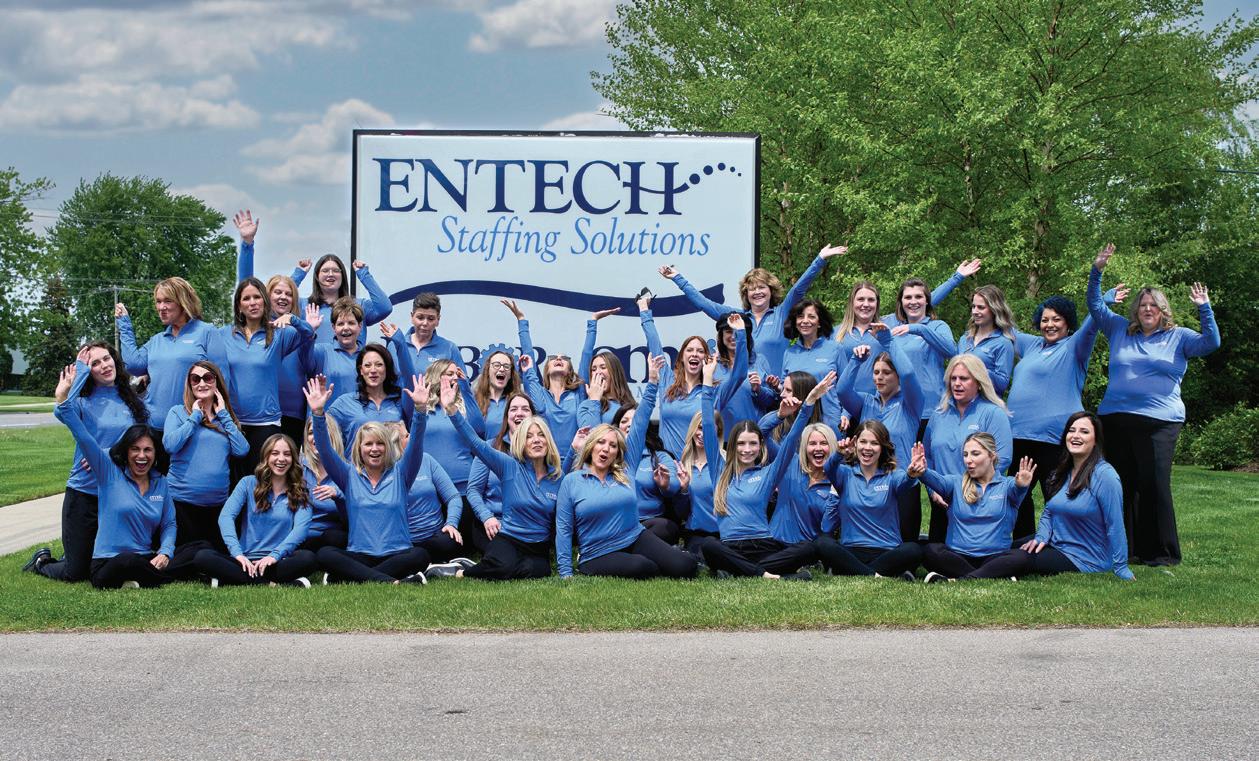


Farbman o ers unlimited PTO and has many employees with 20, 30, and 40 years of service, due in no small part to the way they’re treated, according to Andy Gutman, president of Farbman Group, which was founded by the late Burt Farbman.
“We’ve been implementing workplace exibility for decades, before it was popular and cool,” Gutman says. “It’s always been a great way to keep really good employees. We have a lot of mothers who want to work from home. For us, it’s treating people like adults, showing that you can trust them, and getting the work done. We think it’s one of the main factors in our success.”

Farbman’s newly renovated o ce building, which was originally designed by famed architect Minoru Yamasaki, embraces exibility. In addition to having all of its companies under one roof, the renovated space has specially designed meeting rooms, some with shower facilities, permanent desk areas for full-time employees, and “hotel” space for workers who just need a place to set up for a day or even just a few hours.
“If you’re a happy employee, you’re going to do better,” Gutman says, summarizing the company’s corporate culture philosophy.
Detroit interior design company Concetti is the leader in the Community Engagement Category among small businesses.
“One of the things we talk about all the time is an attitude of gratitude,” says Rachel Nelson, founder, CEO, and principal designer at Concetti. “Gratitude is something really important to me and how I relate to people. It’s part of our promise to ourselves to be the best versions of ourselves to our team and our community.”
Each year, the company identi es “attitude gratitude” projects, according to Nelson, who says most often they revolve around education. e company

has mentored students at Wayne State University, Central Michigan University, and the College for Creative Studies.
Nelson also says she participates in various industry events and panel discussions.
“ e energy we put out into the world goes beyond our physical body and radiates past us,” she says. “When we’re able to be the best version of ourselves and show up, it’s a ripple e ect into the community.”

Nelson also equates the work she does with clients to community engagement, like when Concetti worked with Good Cakes and Bakes along Livernois Avenue in Detroit’s Fashion District.
“One of the most amazing pieces of feedback we heard was the community being grateful for having such a beautiful place in their neighborhood,” Nelson says. “We think it’s important to think about the e ect a project will have on the greater community, in addition to the client.”
Kapnick Insurance in Troy is the medium-tolarge company Community Engagement winner.
“Like a family, we are caring, empathetic, and supportive,” the company says in its promotional literature. “We value giving back and are always ready to help or give the support needed in our communities.”
Past e orts have included making cash donations to charities, holding company-wide volunteer events, and the more than 1,500 hours of annual volunteer time put in by Kapnick team members.
Companies that excelled in the leadership category of the DBusiness Corporate Culture Awards were Entech Sta ng Solutions in Troy (small business) and Lockton Cos. in Detroit, Birmingham, and Grand Rapids.
“We want our sta to come in and work every single day and be happy about it,” says Kathy Camara, co-owner and CEO of Entech. “By



providing the things to them like chef-prepared lunches twice a week, a personal trainer twice a week, and having a light, bright open work environment, our employees like coming to work every day and they want to work hard for us.”
Camara says she leads by example.
“I’m not afraid to step in and do something that needs to be done,” she says. “I’d answer the phones in front. I’ve taken out the trash and unclogged toilets. Nothing is beneath us.”

In addition, Entech’s leaders have created an environment that’s conducive to learning and being able to communicate openly.
“We want everyone to be truly heard and have an opinion, and we try to incorporate that in what we do on a day-in day-out basis.” at philosophy trickles down the Entech chain of command.
“ e people right below us on the corporate ladder follow our same philosophy,” Camara says. “ ey’re really involved in the day to day. ey’re a great resource, so no one feels like they’re left out on a limb if a decision needs to be made.”
e entire Entech leadership team has an opendoor policy and they’re always available to discuss any issue.
Elaine Co man, executive vice president at Lockton, the winner in the medium-to-large business category, credits the company’s leadership philosophy with enabling her o ce to become a $20 million operation in ve years.
Among the tenets Lockton leadership follows are transparency and frequent communication. It also uses a proactive and thoughtful approach to sta ng, and looks for new ways to enhance what has come to be a high-performing team.
“Our entire o ce cares about each other, and leadership is a big part of setting that example of dedication and support,” she says.

March 12, 8 to 10 a.m. nawbogdc.org
The National Association of Women Business Owners propels female entrepreneurs into economic, social, and political spheres of power worldwide. The NAWBO Greater Detroit chapter will honor outstanding female business leaders at the 2025 Top 10 Michigan Business Women Awards, recognizing perseverance, innovation, and community impact. Established in 1994, the awards celebrate trailblazers shaping Michigan’s business landscape.
March 14, 8 to 11 a.m. unitedwaysem.org
The Women of Influence Summit is one of United Way for Southeastern Michigan’s most highly anticipated events, and it is one of the largest women’s events in metro Detroit. Hosted by Women United, United Way’s philanthropic group, this event raises vital funds to support early education initiatives and youth programs focused on STEM and literacy. Since its launch in 2017, the Women of Influence Summit has raised more than $1.6 million to benefit children, families, and caregivers across the community.
March 20, 6 to 9 p.m. bbbssoutheastmi.org/great-big-auction



The Great Big Auction is a sports-themed night of fun and philanthropy in support of Big Brothers Big Sisters of Southeast Michigan, whose mission is to create and support one-to-one mentoring relationships that ignite the power and promise of youth. The event will take place Thursday, March 20, from 6 to 9 p.m. at the historic and iconic Cambria Hotel in downtown Detroit. The VIP experience starts at 5:30 p.m. at Five Iron Golf inside the Cambria Hotel. Guests can expect great food and fabulous drinks, an online silent auction (guests don’t need to be present to participate) and a thrilling live auction, a Golden Draft raffle drawing, BBBS Champions, pro-athlete appearances, networking opportunities, and more. The event will be emceed by CBS News Detroit anchor Lauren Winfrey. The Great Big Auction is a curated event in partnership with Be a Part of Me Consulting.
April 5, 5 to 11 p.m. henryford.com/development/ways/events/friends-ball
On April 5, Henry Ford Health hosts the Friends’ Ball at Suburban Collection Showplace in Novi. Proceeds support advanced digestive health equipment at Henry Ford Providence Southfield and Novi hospitals, aiding treatment for inflammatory bowel disease and colorectal cancer. With colorectal cancer rising in young adults, early screening is critical. Attendees’ support will enhance diagnostic and therapeutic resources, improving patient outcomes.
April 25, 6 to 10 p.m. lifedirections.org


Life Directions will host its annual “Spark of Hope” Tribute Gala on April 25 at the Grosse Pointe War Memorial. Chaired by Ed Peper, retired vice president of General Motors, the event will feature fine dining, entertainment, and live and silent auctions. Founded in 1973, Life Directions empowers Detroit youth through mentorship and self-direction programs, impacting over 180,000 young adults. Proceeds will support the organization’s mission of fostering responsible, productive community members.
May 4, Noon to 5 p.m. mib.international
She Means Business: Unleash 2025 invites attendees to a transformative experience featuring dynamic speakers, industry-leading panels, and networking opportunities. The event will showcase women-owned businesses through vendors, raffles, and giveaways. Guests will gain resources to amplify their careers, foster meaningful relationships, and unlock financial success. A supportive community encourages collaboration, empowerment, and growth. Join a movement that uplifts, inspires, and fuels professional and personal success.


Dennis L. Reed II, founder and CEO of DRII Productions in Oak Park, has produced and directed more than 40 movies and TV series in metro Detroit.
BY R.J. KING | NICK HAGEN
Dennis L. Reed II, a film director, producer, writer, and distributor, refers to metro Detroit as “the independent movie capital of the world.”
He should know. The Bronx native grew up in Detroit and wrote his first book, “He Said She Said,” in 2005 while living in Detroit. Between making author presentations at bookstores and selling the novel out of the trunk of his car, he sold 50,000 copies.
Following its publication in 2006, Reed made the book into a stage play and, eventually, a hit film. Since then, he has written four more books, which have collectively sold more than 300,000 copies. He also produced several plays before making the leap to live action films.
Now, crowned the “King of Tubi,” Reed has produced 43 movies and TV series, with 23 of his works reaching the No. 1 spot on Tubi. Most of his on-screen work is in the Black cinema genre, and in a nod to the Motor City, Detroit’s skyline is featured prominently both in background shots and on movie posters.
“I was writing books and I saw an opportunity to step into another genre — stage plays — and that led to producing films and TV series,” says Reed, founder and CEO of DRII Productions in Oak Park.
He also co-founded, with three partners, Homestead Entertainment, which provides alternative distribution solutions to independent filmmakers, and he co-owns 1919 Distribution with Brandon T. Jackson and Michael McConnell.
One of Reed’s first on-screen works, a 2016 TV drama series called “I Declare War,” which he directed, explores the motives of three organized crime families vying for control of the illicit drug trade in the inner city.

Dennis L. Reed II, founder and CEO of DRII Productions in Oak Park, has directed and produced 43 films and TV series. He also co-founded Homestead Entertainment in Oak Park, which acts as a distirbutor for independent filmmakers.
“It did very well, but I didn’t have a studio,” Reed says. “I was renting houses, offices, and stores, mostly in Detroit and the suburbs. It was hard. We didn’t have the (production) infrastructure.
“Then you find someone to edit, to film, score the movie, and find the right sound — including live artists. I learned to do nearly everything myself, and make it work.”
What followed was a string of screen hits including “First Lady” and “True Law” in 2018; his first sequel, “First Lady II: Maria’s Revenge,” in 2019; and another in 2021: “First Lady III.”
As for the adaptation of his first book, the movie of the same name was released in 2021, as was “Paper Heart,” a story about a love triangle between the characters Knight, Lennon, and Scotland.
Like a production line, Reed and his core team of 30 full-time employees have developed a system of “working on two projects at one time,” Reed explains. “We try to do a TV show or a movie every month. When we’re on set, we could have another 40 or 50 people either acting or working behind the camera.”
Early on, Reed would film in multiple locations across the region. But once his films began making money, he leased space in a multistory office structure, the Crown Pointe Plaza Building, located along Greenfield Road south of Lincoln Street in Oak Park.
During a recent tour of DRII Productions, the filmmaker led the way through a succession of different sets — a mahogany-paneled courtroom, a kitchen, a bedroom, an airport lounge, a hospital room, an operating room, and other locations.
“We map everything out, in terms of what we need, ahead of time, so when we’re ready to film, we can get most everything done in a week or two,” Reed says. “At the same time, we rent our sets out for other films or TV shows like





‘Mathis Court with Judge Mathis,’ which stars Judge Greg Mathis.”
Overall, DRII Productions operates a production-ready studio that collectively spans 50,000 square feet on two oors. In addition to Tubi, Reed and his partners distribute his works and that of other artists on Net ix, Hulu, NBC Universal’s Peacock Network, and more.
In 2024, Reed partnered with the nonpro t organization Crime in the D to produce “Crime in the D Unsolved.” Set to air in the fall, the series brings awareness to cold cases that a ect the lives of individuals and families in metro Detroit.
His success led him to establish, in 2024, the Dennis L. Reed II Foundation. He says the foundation’s overall mission is to help others get in the lm business, as well as provide college scholarships and host annual coat drives and turkey drops before Christmas.
In the pipeline are two drama series, “We Di erent” and “ e Mayor.”
e latter pairs someone like former Detroit Mayor Kwame Kilpatrick and Michael Corleone from “ e Godfather.” While Reed won’t give up much more, he says “it will revolve around what it would be like if they met.”
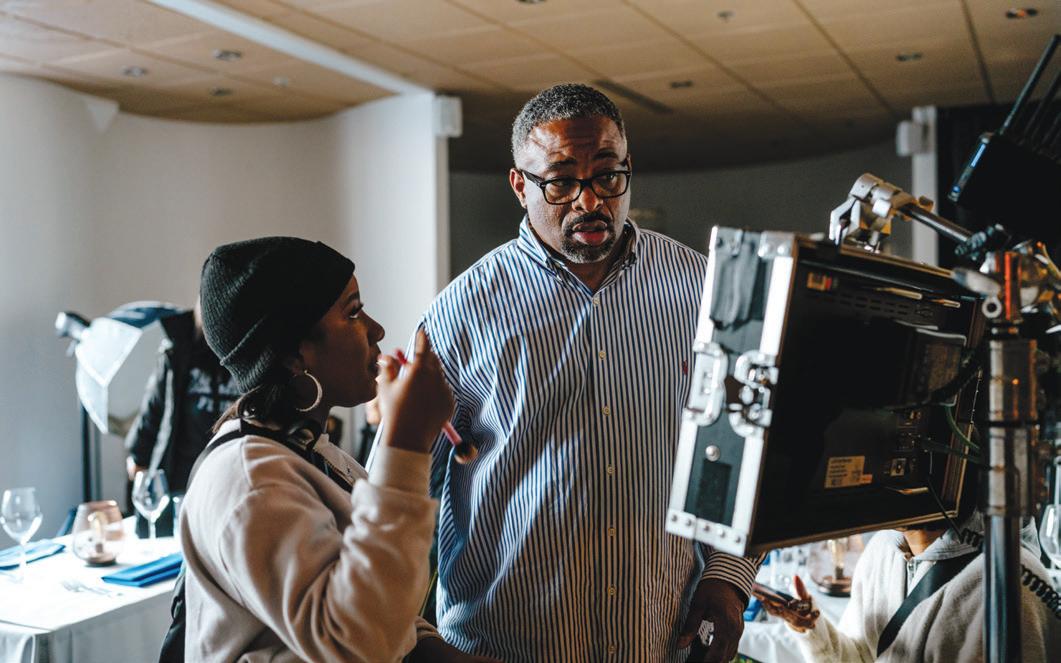

FRAME RATE
Reed oversees the production of a scene for “We Di erent,” which tells the story of five friends who all come to Detroit from di erent places, but somehow have some of the same problems.

Michele Varian ventured from Detroit’s Indian Village to New York City to stake her claim in the fashion industry.
BY TOM MURRAY
Michele Varian remembers it vividly, as if it happened only yesterday. She was born a triplet, all girls, and her sisters were playing outside the family home on Seminole Street in Indian Village, a stately neighborhood on Detroit’s east side.
“It was a very warm day,” Varian recalls. “The birds were chirping, the sun was shining and sparkling on the leaves. I was totally blissing out, and my sisters come skipping up arm in arm and began teasing me, saying, ‘Haha. Haha. We’re the same, and you’re different. We’re the same, and you’re different.’
“They were identical, and I was fraternal. They had blonde hair and blue eyes, and I had black hair and brown eyes. I was the first one born, and bigger than the other two, and at birth they basically shot out after me. We were literally all born within five minutes.”
The telling childhood memory helps explain why Varian left Detroit at a very early age for New York City, where she’s owned and operated a home accessories store for nearly 25 years. But she also credits her parents for fortifying her independent spirit and imbuing her with the moxie she needed to make the move.
“My sisters and I were born the same year as the riots (1967),” Varian explains. “When ‘white flight’ happened, many people in the middle class who had the ability to leave the city did, but I have to say our parents were remarkable, because they made the choice to stay.”
Varian’s father worked in housing development, and is still active as the board chairman of Associated Management Co. in Livonia. Her mother grew up in Monroe and became a teacher.
And the lessons Varian’s mother taught weren’t confined to the students in her classrooms.
“One day, my sisters and I were eating in the kitchen, and we were having a girlie meltdown because a spider had crawled across the table, and my mom just was not having it,” Varian recalls.
“She was like, ‘Listen, girls, you can either wait for somebody else to do things for you or be in charge; decide what you want and do it. You’ve got two choices: Ignore the spider and let it go, or take him out.’ ”
While Varian doesn’t remember which of the sisters snuffed out the spider, she never forgot her mother’s message. It proved to be an integral part of the decision her parents made to not only send the Varian triplets to public school, but to keep them there long after many of her classmates moved away.

Michele Varian grew up in Detroit’s Indian Village neighborhood. After attending college in New York City, she launched Michele Varian Shop and Design, today located in Brooklyn.
“By the third grade, my sisters and I were the only kids in the entire school not on welfare,” Varian says. “We were at Monteith Elementary, just off Jefferson Avenue. It’s no longer there.
“At the same time, my dad felt really strongly that we needed to participate in some kind of team sport, and the school just didn’t have that going on, so we became members of the Detroit Boat Club on Belle Isle and were on the swim team.
“Most of those kids were from the suburbs, so we spent our school year with kids who were having a very different experience than the kids we were summering with, and I think having that contrast was incredibly healthy. It really gave us perspective.”
All the while, Varian’s mother was regularly taking her girls on various excursions around Detroit.
“My mother is very creative, very interested in the arts and culture,” Varian says. “We went to the Detroit Institute of Arts probably once a week for our entire youth, and also the Detroit Historical Museum. We spent time at the library, and we all had a deep appreciation for buildings and craft and materials.”
Varian’s interest in all things related to art continued to grow and expand through the art classes she took at Monteith and in middle school at Whitney Young.
“And then at Cass Technical High School, they had a fantastic art curriculum,” she says. “I was an advanced placement student, and we had a terrific teacher there, Marion Stephens, who was really invested in the success of the kids and encouraged us to pursue a creative profession.”
A lifelong Detroiter who recently celebrated her 90th birthday, Stephens taught countless students during her 40-plus years in the city’s public school system, and was once designated by the Michigan Art Education Association as the High School Art Teacher of the Year.
She remembers Varian well from those early days, and with great affection.
“The best students always went out of their way to excel and do more than was expected of them,” Stephens recollects. “Michele was certainly one of them. And those were the students I took to New York every year, usually by train, to visit Cass graduates who were at schools like Parsons School of Design, to stay in the dorms, and help inspire them.
“Later on, Michele wrote me the most beautiful letter, thanking me for what I taught her. I still have it.”









I LOVED DESIGNING CLOTHING, BUT I WAS FRUSTRATED WITH NOT BEING ABLE TO RUN EVERYTHING.”
— MICHELE VARIAN
Varian was more than simply inspired by those visits to New York.
“ e rst couple of times I went to the Metropolitan Museum of Art I was like, Oh, yeah, I’m gonna live here,” she says, laughing. “I moved to New York by myself when I was 18 to go to Parsons, which is a wildly expensive school.
“ ankfully, I received several scholarships and nancial aid, and worked parttime (during the school year) and during the summer, until my parents were able to start contributing during my senior year.”
In 1990, Varian says thought she had completed her studies at Parsons.
“I say ‘graduated’ with air quotes, because technically I never did. I was three credits short for a class I’d uno cially withdrawn from.
“ ey let me walk in the graduation ceremony, guring I’d eventually nish those credits, which I never did. But I was very fortunate. I had student loans to pay o , and I had already secured a job as a designer at a women’s clothing company called Kikit, which is no longer around.”
Over the next 10 years, Varian held designer jobs with a handful of other companies.
“Part of why I went into fashion was the prospect of traveling,” Varian explains. “But I was working 12 hours a day, and the rst time I ew to Hong Kong, I worked all day, went from work directly to the airport, ew 20 hours, landed with 13 trunks and no valet, and went directly from the airport to the o ce.
“But my attitude, being from Detroit, was nobody’s going to do it for you, so you just have to do it yourself.”
Varian realized she needed to make some changes in her life and her career, but not because of her grueling travel schedule.



Varian and a fellow student, Ying Su, in draping class at the Parsons
“I loved designing clothing, but I was frustrated with not being able to run everything,” she says. “I was already manipulating fabrics to make them new and di erent, with applique and all kinds of things.
“I started my company in 1999, and was designing and manufacturing my own collection of home textiles, mainly pillows, and had begun selling to Neiman Marcus and Barneys, and I was self- nanced. And that’s part of why I decided to do home goods.”
Varian opened her rst retail store in 2001 in New York’s SoHo district, occupying several other progressively larger locations in the area before nally settling in 2020 on Atlantic Avenue in Brooklyn.

Today, Michele Varian Shop and Design o ers “an unexpected oasis of curious, provocative, and beautiful things,” including the founder’s collections of textiles, pillows, wallpaper, lighting, and furniture. She also o ers ne jewelry from more than 70 local designers.
A friend of Varian’s once observed that every item in her store features a common characteristic: “He said I need to see the hand of every person who made every object, that I need to see the hand of the maker,” Varian says, smiling widely.
“ at’s exactly right, and it de nitely comes from having grown up in a neighborhood like Indian Village, and my awareness of the skills that were cultivated and what was achieved there. It’s very important to me and is a big part of what oats my boat.”
It shouldn’t go unmentioned that the little girl who silently vowed on a long-ago summer day she would energetically embrace the notion of being different is married to a rock star — Brad Roberts, the lead singer and guitarist for the Canadian band Crash Test Dummies.
At the time of this interview with Varian, her husband was making final preparations for the band’s demanding 30th anniversary world tour — but Varian has no immediate plans to join him on the road.
“I was threatening to meet him in Europe on his last tour, but it’s pretty brutal,” she says. “They perform and then, right after, sometimes they have a long drive to their hotel. And it’s not a tour bus anymore, it’s a van. So, no, I don’t generally go anymore unless he’s going someplace I like. And also, you know, I have a business to run.”
And if Varian wasn’t at her store as much as she has been over the years, she might have missed opportunities to see a dear old friend: her former high school teacher.


“I always made a point to visit her shop regularly,” Stephens says, wistfully. “But I haven’t been able to go anywhere since COVID-19. I hope to get there again. Michele was one of my special kids. I think of her often.”
For Varian, the feeling is mutual — not only for her former teacher, but for her hometown, too.
“I still love Detroit deeply, and I really do think the fact that my parents stayed after the riots had a really huge, positive impact on my sisters and I,” Varian says. “Today, my sister Kathleen is one of the two women executives running our dad’s company, and my sister Elaine has her own consulting firm. My dad is very proud of the fact that all three of his daughters run their own companies.”
Varian proudly shares that her parents still live in the same house she grew up in.
“Think about that. You have an entire community of people who made this choice to stay, and mostly because they didn’t want to give up. They didn’t want to run away from something that was going to be difficult. They believed in something. They believed there was a right and a wrong.
“It’s what we were taught, you know? Not just from our parents, but from our peers, because of their parents, and so on. So, we just don’t know any different than the scrappy ‘figure it out and get it done’ attitude, and most of us from Detroit are very passionate about it.”
Passionate, of course. But in the case of Varian, also confident and committed.
“One of my biggest motivations for leaving Detroit at 18 was being one of triplets,” she says. “Everybody was always comparing us, and I didn’t want to be compared to other people. I just wanted to do me.”
Neuvokas Corp., in the Upper Peninsula, has made its all-American composite rebar cost-competitive with steel.
BY TIM KEENAN

Once reserved for specialty, metal-sensitive construction projects like MRI suites in medical buildings, the use of composite rebar in concrete applications is expanding, due in no small part to Neuvokas Corp. in the Upper Peninsula.
Based in Ahmeek, in the northernmost reaches of the U.P., Neuvokas brought its GatorBar composite rebar to market in 2016, upending the conventional wisdom that non-steel concrete structural support was too expensive for many applications due to materials costs and long manufacturing cycles.
Neuvokas’ founders, Erik Kiilunen and Ken Keranen, both former polymer salesmen, saw an opportunity to use manufacturing and material science technologies to produce fiberglass reinforced polymer (FRP) rebar that’s cost-competitive with steel.
The resulting prototypes increased manufacturing speeds by more than 1,200 percent — and GatorBar was born.
“(FRP rebar) was produced at such slow speeds and high costs that it wasn’t competitive with standard black bar for concrete reinforcement,” says Chris Raymond, director of marketing at Neuvokas Corp.
“The changes that we were able to make in material science and how we produce the product allowed us to be comparable to steel and competitive from a cost perspective.”
Another price advantage comes from FRP’s improved tensile strength compared to steel.
“Because of our advanced tensile strength, it allowed us to go a size smaller when tensile strength was the prominent design criteria,” Raymond says. “That gave us an advantage from a pricing perspective.”
Another advantage comes from production speed. When the company first started, it produced 100 to 150 feet of FRP rebar per minute. In the years since, that number has increased to 300 feet per minute.
“Most of our competitors are producing in the 10to 15-feet-per-minute range,” Raymond says. “That allows us to produce more bar with the same amount of overhead, which improves our per-unit pricing.”
ExxonMobil, which supplies GatorBar’s resin, says its Proxxima resin system’s ultra-low viscosity and snap cure technology, paired with Neuvokas’ process, contributes to production speeds that are up to 20 times faster than traditional composite rebar methods.
Other advantages include FRP rebar’s rust-proof qualities, which extends the life of concrete.
“Water is a component of concrete and concrete will crack over time, which will cause steel rebar to rust,” Raymond explains. “When steel rebar rusts, it expands. When it expands, it cracks the concrete even further. What started out as a reinforcement for the concrete ends up becoming its worst enemy.”
FRP also is lighter than steel, while the production process eliminates slivers common to competitive products, according to the manufacturer. These features further differentiate GatorBar from traditional steel by delivering reduced transportation costs, simplified handling, faster installation, added design optimizations, and value across a broad range of projects.
“When you’re in a decorative situation, you’ll get rust bleed — and people don’t like to see that on their patios, especially around pools,” Raymond says.
GatorBar is a simple product, according to Matt Kero, director of engineering and manufacturing at Neuvokas Corp. It’s 80 percent fiber and 20 percent resin and “some other items.”
In 2025, Kero says he expects 100 million feet (8.5 million pounds) of GatorBar to be produced on three production lines, each offering different size rebar.
“This means we’ll be receiving up to 13 fiber trucks and three resin trucks per month in Ahmeek, along with multiple less-than-truckload shipments of various parts and materials,” Kero says. “Over 15 trucks
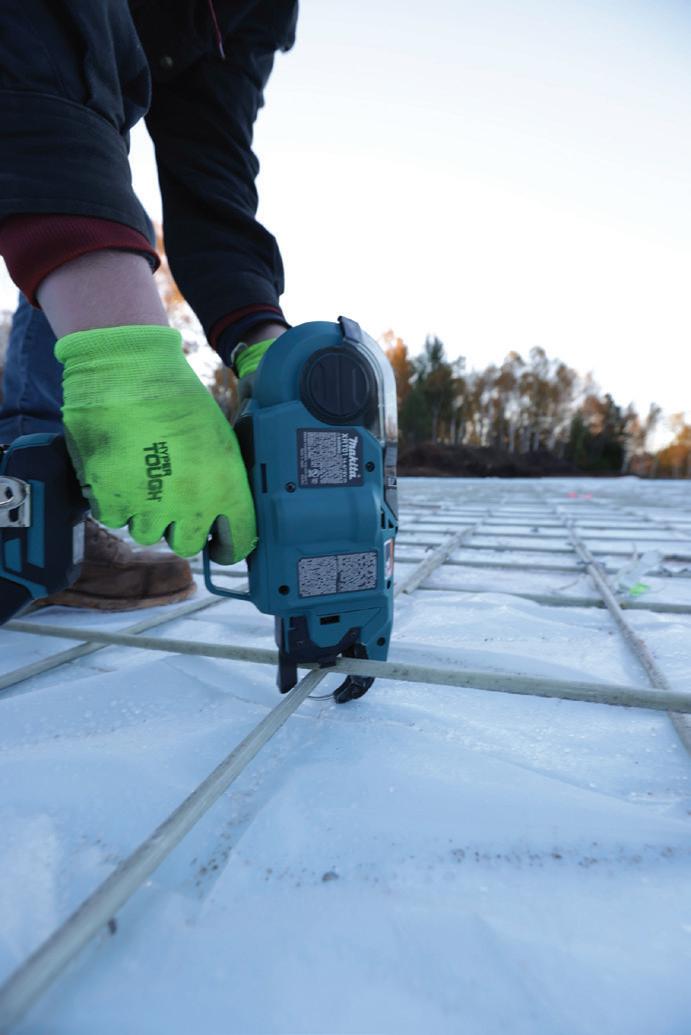
per month of finished product are sent back out through our dealer network.”
In January 2024, the company expanded its facilities by 12,000 square feet to prepare for future demand.
“We have the ability to produce over 200 million feet of GatorBar in any given year depending on dealer network needs,” Kero adds.
Neuvokas’ team of 30-35 employees includes draftsmen, fabricators, and engineers. The company sources all of its raw materials from suppliers in the United States, making its finished product purely American.
For example, resins are sourced from ExxonMobil in Texas, fibers come from NEG-U.S. in North Carolina, and machining work is farmed out to local and regional businesses.

“On a given day, you might see a fiber truck come from the Carolinas, a bulk tanker from Texas, and a pick-up truck with parts from just down the road,” Kero says. “We’re happy to give a lot of our machining parts business to local manufacturing shops.”
Once the raw materials are delivered to GatorBar’s plant, lot numbers are entered into a tracking system that follows the material all the way through to the finished product. When the rebar is completed, employees inspect each bar before the product is bundled and packaged.
Adding to the local flavor, the company works with Michigan Technological University in nearby Houghton to complete testing of its product in a variety of applications. In addition, real-time updates are provided on product improvements and quality.
Neuvokas sells its GatorBar to a nationwide customer base of concrete distributors, which in turn sell to construction companies and contractors.

Source: Neuvokas Corp.
GROUND CONTROL
Compared to steel rebar, GatorBar’s advanced tensile strength provides added durability, more competitve pricing, and faster production times.

GatorBar’s primary competition is steel rebar, not other composite rebar manufacturers.
“Our focus has always been on flatwork, where the advanced tensile strength of composite rebar was able to allow us to utilize a smaller size bar to get the same result as steel,” Raymond says. The product typically is used in parking lots, sidewalks, and roadways.
Although most of the GatorBar produced ends up in the Midwest, it can be found in projects in all 50 states and recently in China, which isn’t the only international destination in GatorBar’s sights.
In October 2024, Neuvokas’ resin supplier, ExxonMobil, signed a licensing agreement to sub-license Neuvokas’ proprietary manufacturing process in markets outside North America — a significant step toward expanding the global market of composite rebar in the concrete reinforcement sector.
In the meantime, Kero says, “We’re proud to produce a product that is 100 percent American-made.”


Cameron B. Waterman, who practiced in Detroit, was one of those rare lawyers who had a knack for inventions.
BY NORM SINCLAIR
In January 1950, e New York Times hailed a retired Detroit patent lawyer, Cameron B. Waterman, as one of the most in uential gures in the history of recreational boating.
“He is far more important to the sport of recreational boating than most of the commodores, commanders, skippers, and other big brass,” wrote Clarence E. Lovejoy, the newspaper’s boating editor.
“He is Mr. Outboard Motor personi ed, the man who invented the putt-putter that is clamped on the stern transom of uncounted hundreds of thousands of dinghies, ski s, and even canoes which take shermen, vacationists, and others up rivers, across lakes, and down into coves and harbors.”
Detroit patent lawyer Cameron B. Waterman tapped his creative side and developed one of the world’s first outboard motors.
According to national boating sales data, Waterman’s invention, developed on Grosse Ile and in the Detroit River at the turn of the last century, has become a $3.6 billion industry. In recent years, annual sales of outboard motors average around 300,000 units.
For much of the past century, however, Waterman’s role in inventing the rst working model of a gasoline-powered outboard motor, and the story of his invention, was nearly erased by competitors who were better equipped to mass-produce small marine engines.
From February 1905, when he tested his rst motor attached to a rowboat on the Detroit River, until he sold his edging engine manufacturing company a little more than a decade later, Waterman’s achievement was almost lost.
An early rival, Ole Evinrude, was widely credited for creating the outboard motor.
Waterman grew up around water, living on his family’s farm on Grosse Ile. His father was a wealthy Detroit real estate broker who bought the farm because he thought it would be a good place to raise his children.
Young Cameron was introduced to rowing growing up, and went on to captain the varsity rowing team at Yale University. He also was an avid sherman, with plenty of experience navigating the Detroit River in a rowboat.
Following his graduation from Yale Law School, Waterman returned to Grosse Ile and joined a law rm in Detroit. His unlikely and accidental inspiration for inventing an outboard motor came from his motorcycle.
In the fall of 1903, Waterman removed the 20-pound, four-cycle, air-cooled motor from his bike and hung it over the back of a desk chair to clean and overhaul it.
Seeing the motor hanging on the back of the chair led to a “Eureka” moment for Waterman — and boating enthusiasts.
“It occurred to me that I could hang it on the transom of a rowboat, attach a propeller to it, and drive a boat,” he said. “If I hinge the engine to the back of the boat, it could be used to steer as well as propel it.
“ en, in my mind, I provided it with a tiller and mounted a gasoline tank (an idea from an oil lamp base) near the tiller to make (it) a self-su cient unit. (My) nal idea was to allow the engine to tilt up to a horizontal position, to protect it in the absence of a keel or skeg.”
In the following months, Waterman continued to esh out his idea of a motor attached to the stern of a boat.
Sharing his proposal with his colleagues at omas Sprague and Son, all specialists in patent law, they suggested he create sketches and write up descriptions of his edging idea.
When Waterman showed the completed drawings to the manager of a machine shop, they signed a deal for a prototype — so long as the Detroit barrister supplied the motor.
To land the engine, Waterman wrote Glenn Curtis, an engine-builder and nationally renowned bicycle, motorcycle, and aviation racer, and made a pitch. A few weeks later, Curtis shipped the inventor a three-horsepower, four-cycle motor.
When the prototype motor arrived in February 1905, Waterman and a group of friends attached it to a 15-foot steel rowboat and red up the engine.
Despite one setback, the test was deemed a success. e motor-powered rowboat made it across the Detroit River without using oars, according to the Waterman le at the Grosse Ile Historical Museum.
“Although the river was full of ice cakes, the try-out was a complete success, except for the fact that a piece of ice got caught between the chain and sprocket, causing the chain to run o the sprocket,” Waterman said. “We rowed ashore to replace the chain. at day, someone in our party called it an ‘outboard motor.’ ”
e problem with ice or other debris in the water jamming the chain and sprocket was solved by a production engineer, Oliver Barthel, who advised Waterman to change the chain drive to a vertical shaft with bevel gears.
On Dec. 6, 1905, Waterman submitted a patent application for his outboard motor to the U.S. Patent and Trademark Office. The following April, U.S. patent 851,389 was granted to Waterman for a “Boat Propelling Device.”
Next up was finding a manufacturer to mass-produce the motors. Although they had never built a motor, Waterman convinced Caille Brothers Manufacturing Co. in Detroit, one of the country’s foremost builders of slot machines, to take on the project.
In 1906, the inventor formed Waterman Marine Co. to collaborate with Caille Brothers Manufacturing to produce 25 models he named the Waterman Porto, short for portable outboard engine. He sold 24 of them, and kept one for himself.
The Porto was a two-horsepower unit weighing 35 pounds that retailed for $50. To market the outdoor motor, Waterman passed out brochures of his invention at the 1906 Sportsman’s Show at Madison Square Garden in New York.
A hit with attendees, Waterman took in a significant number of advance orders without anyone seeing the actual motor in action.
Those early models, however, were not without major flaws.
On a boat ride with his wife, Lois, on the Detroit River on a hot summer day, the motor overheated. Barthel, the engineer, who had joined Waterman’s marine company, solved the problem by developing a water-cooled motor; a new pump and other components were added.
Still, the early cast iron Porto made it too heavy for lightweight boats. The engine also lacked a mechanical starter, and operators had to manually turn a flywheel with a wooden crank to start the motor.
Once the motor fired, the crank kept spinning, putting the boater’s hands and knuckles in danger from the rapidly rotating handle.
Because the motor didn’t have a neutral gear, as soon as the motor started the boat took off, albeit at three to four miles per hour, but it was still tricky enough for a boater leaving a crowded dock.
In November 1906, Waterman put up $30,000 to build a factory to manufacture and market the Porto. The plant opened on Fort Street in Detroit in March 1907, with a capacity of producing 12-15 motors per day. With a workforce of 11 men and four women, the company turned out somewhere between 800 and 1,000 outboard motors that first year.
With help from his motto — “Make a motorboat of any boat in five minutes” — production ramped up to 3,000 units over each of the next two years.
The first challenge to Waterman’s claim as the inventor of the outboard motor emerged in Milwaukee in 1909. Ole Evinrude, a Norwegian-born American engineer with experience building gasoline-powered engines, opened Evinrude Motor Co. to build his version of an outboard motor for small boats.
Evinrude was well-known in Wisconsin for his invention of an early motor car, a “horseless carriage” powered by a gasoline motor.
A widely circulated anecdote noted that his fiancée, Bess Cary’s, fondness for a particular ice cream cone inspired him to invent an outboard motor. To reach her favorite ice cream shop in the summertime, Evinrude had to row her across a 5-mile-wide lake, a chore he wanted to avoid.
Evinrude’s patent application for an outboard motor, described as a “Marine Propulsion Mechanism,” was granted by the U.S. Patent Office in 1911, five years after Waterman received his patent for his “Boat Propelling Device.”
With the marketing talent and ability to mass-produce a product, Evinrude went on to build a billion-dollar marine products company that would dominate the market for more than a century.
Despite his patent for the earliest functioning outboard motor, Waterman was never able to fully capitalize on his invention.
“I never had a basic patent because I couldn’t get one, and neither could anyone else,” he explained. “Way back in 1883, a fellow whose name I forgot stuck a small steam boiler on the back of a boat, used a propeller, and was given a U.S. patent on what he called an outboard motor. It never worked, and never was produced, but the issuance of that patent prevented anyone else from getting full protection.”
With as many as eight other outboard manufacturers on the market, Waterman sold his product name and manufacturing rights in 1917 for $20,000 to Arrow Motor and Machine Co. in Newark, N.J. Arrow continued to produce the Waterman Porto, but dropped the line four years later.
Following his run at mass production, Waterman returned to practicing law. Now living in Grosse Pointe, he died on April 19,1955, at the age of 76.
A humorous description of the rivalry between Cameron B. Waterman and Ole Evinrude appeared in the New York Herald Tribune in January 1950, written by famed sportswriter Red Smith.
“There is no evidence that the Evinrude people, who have since propelled innumerable craft over uncounted nautical miles, ever subscribed to this tale (about Bess Cary’s passion for ice cream) in its entirety. They have only claimed that Ole Evinrude developed the first outboard for mass production,” Smith wrote.
“Mr. Waterman’s attitude toward ice cream and related products is not known. His position with regard to rowing is clear; he thinks it stinks and always did, which is why, he says, he invented the outboard motor.”
SUMMARY DISCHARGE
An early model of Waterman’s outboard motor is on display at the Grosse Ile History Museum, which is overseen by the Grosse Ile Historical Society.

By combining innovation, ethical standards, and supportive policies, predictive models developed from genomic analytics can usher in a new era of smarter patient care.
BY MD NAGIB MAHFUZ SUNNY
In today’s rapidly advancing health care landscape, big data analytics is reshaping patient care, enabling providers to predict outcomes, improve decision-making, and personalize treatments.
While machine learning can better deliver realtime insights that empower clinicians to make informed choices, optimize resources, and proactively manage complications, it also introduces challenges around data privacy, integration, and ethics that must be thoughtfully addressed to ensure sustainable and fair health care solutions.
Big data, in this case, integrates information from electronic health records, wearable devices, and genomic databases. Predictive models built from these diverse data sources can forecast disease onset, gauge treatment success, and identify highrisk patients. Such anticipatory interventions are driven by algorithms analyzing large datasets in real time to create personalized treatment plans.
By leveraging predictive models, health care providers can allocate resources more e ectively and tailor care to individual or group needs, ultimately improving treatment paths and enhancing patient well-being.
From ndings highlighted in our latest research, factors contributing to positive health outcomes, such as frequent health care interactions and strong patient engagement, can be enhanced. Key variables, including treatment duration, body mass index, and individualized care plans, signi cantly impact recovery.
As part of work recently published in the Journal of Intelligent Learning Systems and Applications, my team developed three predictive models to consider for various types of health care data.
1. Logistic Regression: Useful for predicting binary outcomes, such as whether a patient will respond to treatment, this model achieved an 85 percent accuracy rate. However, it struggled with rare outcomes, highlighting the need for specialized models to handle uncommon cases e ectively.
2. Random Forest: By combining multiple decision trees, this model achieved a 92 percent accuracy rate and performed especially well in cases where patient engagement metrics were central to success. is would help track how patient behaviors and interactions in uence outcomes.
3. Neural Networks: Known for managing complex data, such as readings from wearable devices, neural networks proved valuable in intricate cases where they could reveal hidden patterns in patient data. Although slightly less accurate than other models, neural networks o er unique insights into complex datasets.
While big data in health care o ers immense potential, it faces several implementation challenges. Data fragmentation is one signi cant hurdle, as health care providers frequently work with isolated datasets, restricting the scope of integrated predictive models. Additionally, data quality is critical, as incomplete or inaccurate data undermines model reliability. e goal is to develop advanced preprocessing techniques to improve data quality, but challenges persist.
treatment plans. My team found that predictive models used at the Children’s Clinic of Michigan successfully identi ed high-risk patients, reduced hospital readmissions, and improved patient outcomes.
Future research should explore advanced machine learning techniques, such as deep learning, which can process even more complex data and adapt to evolving health care needs. Integrating predictive models into clinical work ows through intuitive platforms also supports datadriven decision-making.
Educating clinicians on these tools will be essential in order to maximize their potential and foster widespread adoption. Such adoption can bene t individual patients while advancing broader public health goals.
What’s more, complex models, such as neural networks, can be di cult for clinicians to interpret, which may be a barrier to widespread adoption.


which may be a barrier to widespread adoption.






transparent explanations of certain predicated outcomes, building clinician con dence, and promoting greater acceptance of advanced tools.
Explainable AI could be the solution, o ering transparent explanations of certain predicated outcomes, building clinician con dence, and promoting greater acceptance of advanced tools.


— and once a foundation is established, it will pave the way for more e cient, e ective,

Looking more into ethical considerations,



Addressing challenges related to data quality, privacy, and interoperability will be essential for health care providers to con dently adopt predictive analytics — and once a foundation is established, it will pave the way for more e cient, e ective, and personalized delivery and care, and ultimately lead to improved and sustainable patient


Looking more into ethical considerations, models trained on historical data may inadvertently perpetuate health care disparities, especially if the data re ects existing inequities in care. is could disadvantage vulnerable populations if not properly addressed.
tently perpetuate health care disparities, especially if the data re ects existing inequities in care. is could disadvantage vulnerable popula-





As such, ethical guidelines should prioritize fairness, transparency, and informed patient consent. In addition to policymakers establishing responsible data-use practices that minimize bias, blockchain technology can enhance data security and privacy through decentralized data management. at alone builds trust among patients and clinicians.


tize fairness, transparency, and informed patient consent. In addition to policymakers establishing responsible data-use practices that minimize bias, blockchain technology can enhance data security






management. at alone builds trust toring and early intervention when
Already, predictive analytics is making tangible impacts. For example, wearable devices that track vital signs enable real-time health monitoring and early intervention when irregularities are detected.







complications in chronic conditions such as

AI-powered models also can forecast complications in chronic conditions such as diabetes, helping clinicians to proactively adjust












ery and care, and ultimately lead to improved and sustainable patient outcomes.


PATRICK GLORIA
The St. Jude Children’s Research Hospital in Memphis, Tenn., held its St. Jude Detroit Gala on Jan. 25 at the Henry Ford Museum of American Innovation, part of The Henry Ford in Dearborn. The sold-out event, which was expected to raise $1.5 million for the hospital, included a cocktail reception, a three-course plated dinner, live and silent auctions, presentations, and inspirational displays outlining the mission of St. Jude.
1. Ted and Madga Moss, Cathy and Ted Willrich
2. Dave and Kate Mannarino, Marla Feldman, Mike Jacobson
3. Dominic and Tanya Skilton, Lorron James
4. Joe and Vanessa Durham, Gretchen and Ethan Davidson
5. Jason and Stacey Raznick


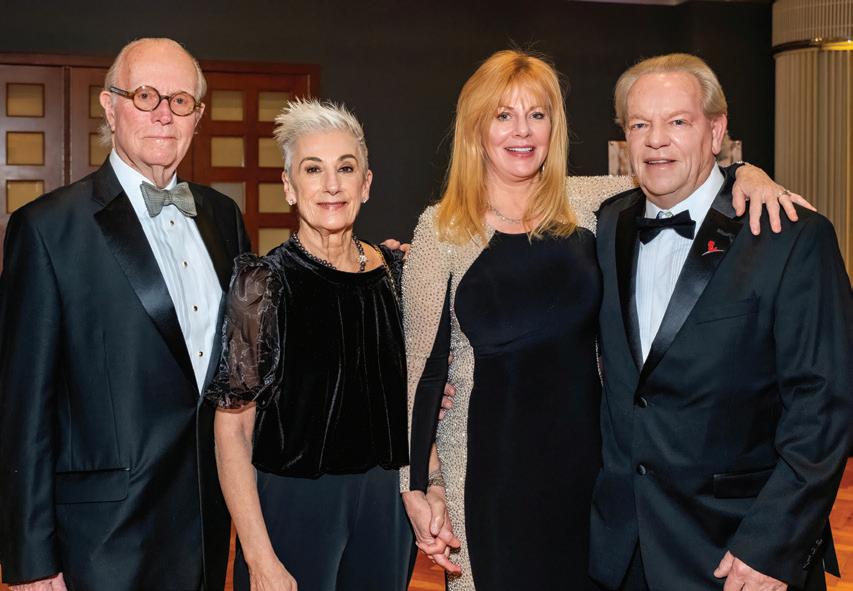

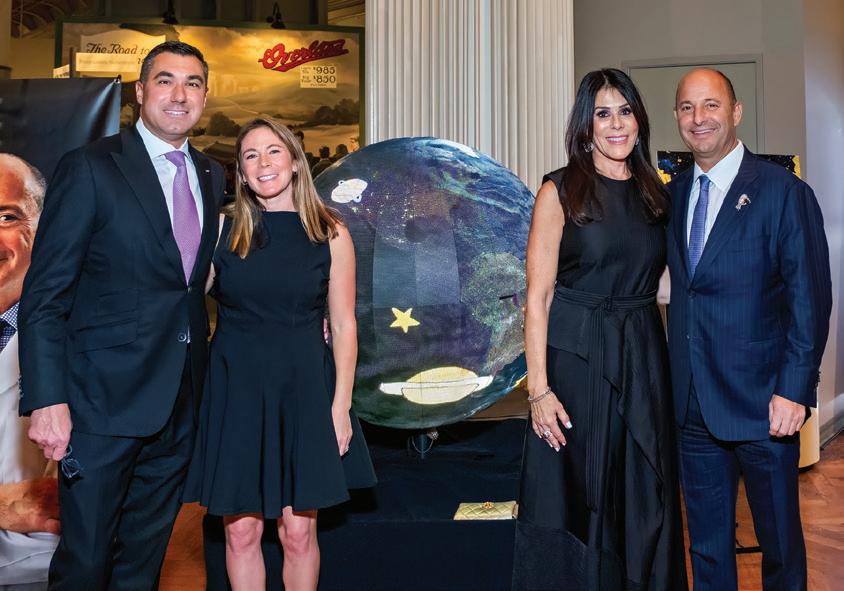

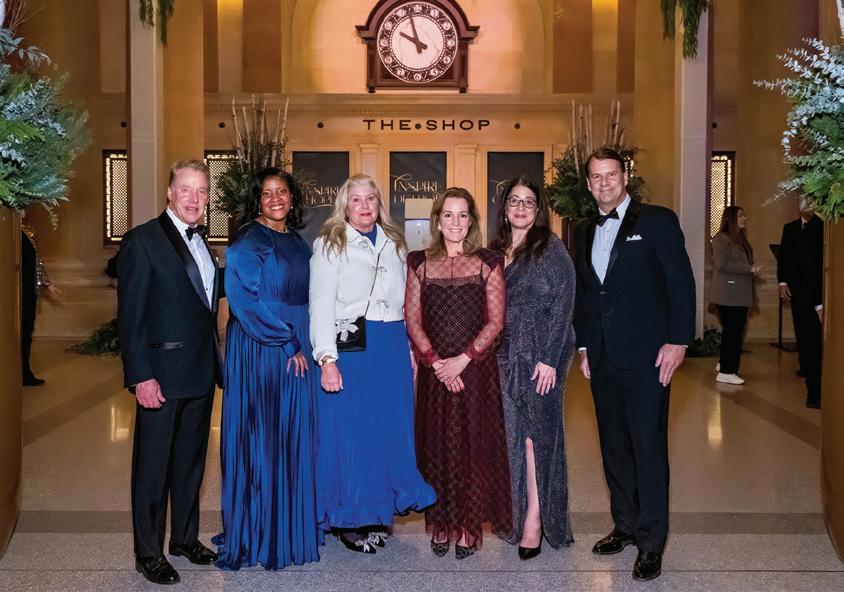

PATRICK GLORIA
The 2025 Detroit Auto Show Charity Preview, which was held at Huntington Place in downtown Detroit on Jan. 10, drew thousands of guests who were introduced to the latest vehicles from the world’s automakers and enjoyed a performance by recording artist and hip-hop icon Flo Rida. Over the past 25 years, the Charity Preview has raised more than $125 million for children’s charities in southeast Michigan. Sponsors included Auto Hauler Exchange, Delta Airlines, MEDC, the Michigan Office of Future Mobility and Electrification, Hour Media, and WXYZ-TV 7.
11. Robert Morgner, Stacy Anderson
12. Ryan Savage, David Douch, Rod Alberts, Zack Douch, Paul Sabatini
13. Aaron Van De Mark, Alison White, Kristie and Bob Mihelich
14. Bailey Staff, Christina Frank, Anne Baldwin
15. Mandi and Troy Slivka

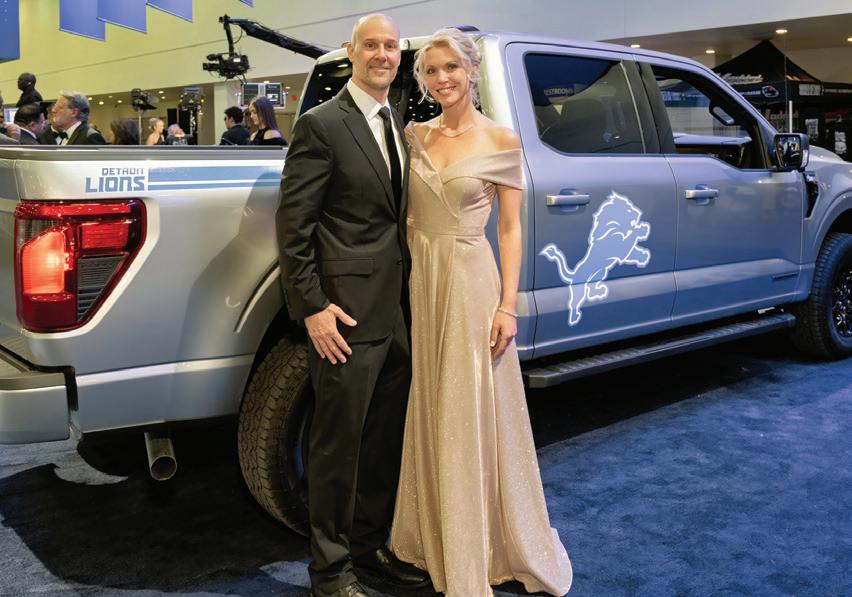

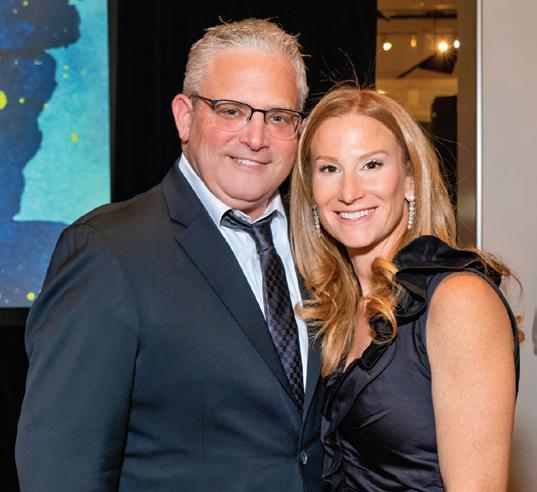
PATRICK GLORIA
AutoGlow 2025 presented by Ford Motor Co., a pre- and post Detroit Auto Show Charity Preview event benefiting The Children’s Center in Detroit, took place on Jan. 10 at Michigan Central. The event was hosted by Lisa and Bill Ford and Lia and Jim Farley. The theme of the evening was “Inspire Detroit,” and the event featured appetizers, a strolling dinner, and desserts from Forte Belanger, along with music from DJ Prevu and the Blue Water Kings Band. Guests were offered transportation via luxury motor coach to and from the Charity Preview at Huntington Place.
6. Elizabeth Agius, Desiree Jennings, Dr. Sonia Hassan, Mayor Mike Duggan 7. Bill Ford, Desiree Jennings, Lia Farley, Lisa Ford, Elizabeth Agius, Jim Farley 8. Harold and Claudia Meeks
9. Madison Linton, Renee Godfrey 10. Patricia and Gary Love







CHRISTINE M.J. HATHAWAY
The Friends of Detroit Rowing revived its Oarsmen’s Ball at the Dossin Great Lakes Museum on Belle Isle on Feb. 1. Guests at the black-tie optional event were able to explore museum exhibits, sample hors d’oeuvres, listen to jazz music, and bid on silent auction items. Funds raised go toward the Share an Oar, Share the Shore Campaign to build a new “shellhouse” on the island that will help increase public access to the Detroit River and the sport of rowing.
6. Jason Watt, Jeremy Watt
7. Stephen Malbouef, Cathy Nordby, Gerard Martin
8. Lauren Wallner, David Misch
9. Al Coleman, Hon. Alicia Jones-Coleman
10. Lisa and Brad Stocker, Edward Wujek
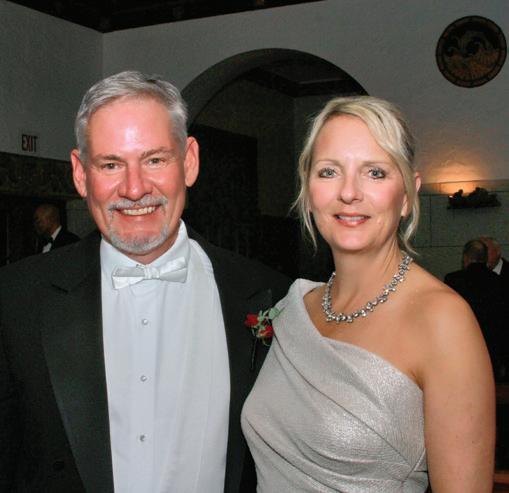
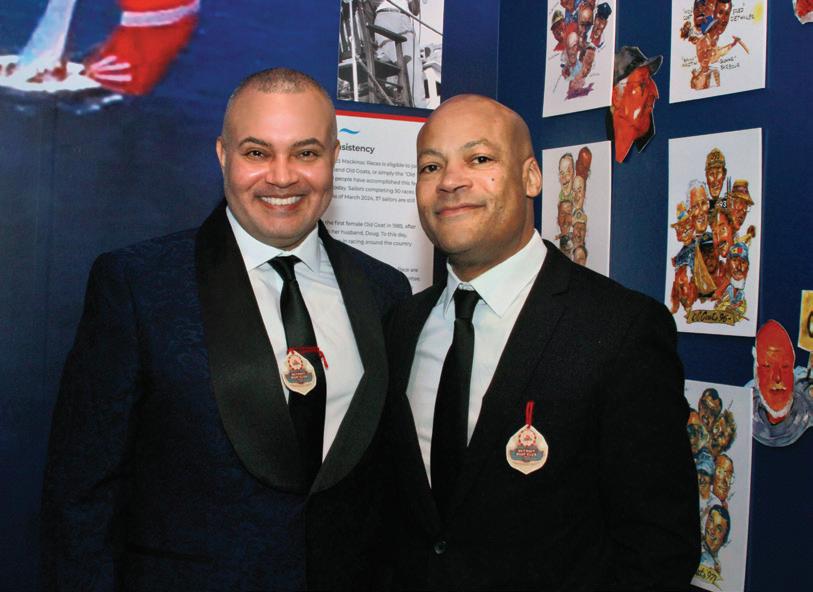

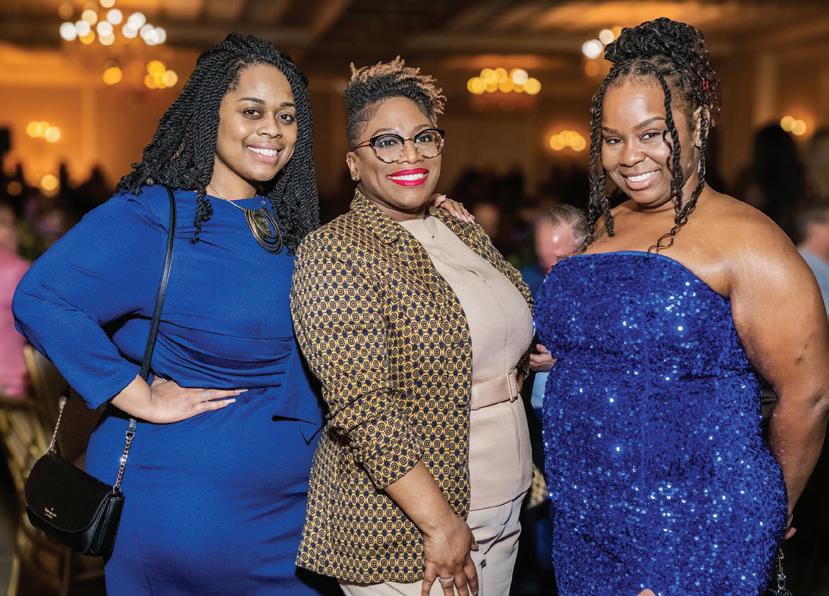

CHRISTINE M.J. HATHAWAY
The Detroit Yacht Club hosted its 149th annual Officers’ Ball on Jan. 25, on Belle Isle in Detroit. The black-tie event featured a cocktail reception, a sit-down dinner, programming, and an afterglow featuring Detroit singer Angela Davis. Founded in 1868, the Detroit Yacht Club is the largest and one of the oldest private clubs in North America.
1. Erin Hardin, Bonnie Zsigo
2. Doug Rocho, Wendy Caldwell, Michael Babiarz, Vincent Cooley
3. Zack and Gina Aboona
4. Kevin Graziani, Commodore Hope Shovein
5. Michael and Lynn Thomas

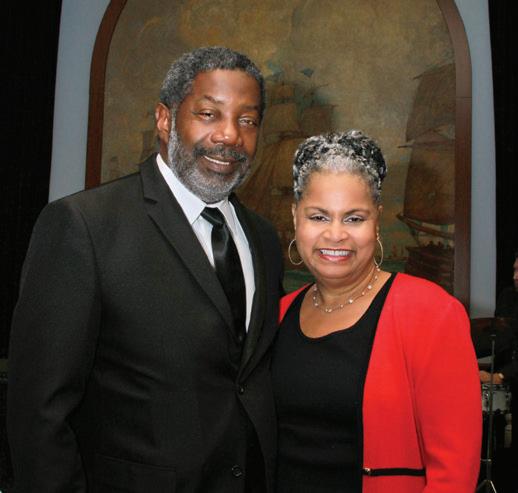




PATRICK GLORIA
Variety the Children’s Charity hosted its Variety Cocktails and Cuisine fundraiser on Feb. 6 at The Townsend Hotel in downtown Birmingham. Guests enjoyed dishes prepared by some of metro Detroit’s most talented chefs, including those from Andiamo, Bella Piatti, The Birmingham Pub, Crispelli’s Bakery & Pizzeria, The Hudson Cafe, Joe Muer Seafood, and The Rugby Grille. Proceeds benefited Variety’s programs serving special needs children in southeast Michigan.
11. Marilyn Lawrence, Princess Castleberry, Raquel Parker
12. Paul and Stephanie Buscemi, Theresa and Christopher Ahee, Carmie and Peter Graves
13. Annmarie Kluzak, Laura Hertgen, Sara Fontanai
14. Aubrey Tobin, Dee Lenard, Robert Dempster
15. Erin Hardin, Bonnie Zsigo















































in Metro Detroit and across our great state.


















ght for justice, airness, and the rule of law strengthens the y and upholds the legal , it is an honor to work alongside y our dedication to the pursuit for truth and equity in ery decision you make.” our commitment to the fight fairness, foundation of our democracy rights of all Michiganders.
“As a proud member of Michigan’s community, you and witness your every












































BAKER COLLEGE
CADILLAC, JACKSON, MUSKEGON, OWOSSO, ROYAL OAK, ONLINE | Private, Nonprofit
Undergrad programs: Bachelor’s and 3+1 accelerated BBA/MBA degree programs including accounting, business administration, finance, human resource management, information technology, supply chain, marketing, and more. Programs are offered at select campuses or 100 percent online. Transfer students can apply at no cost. baker.edu; 855-487-7888
CLEARY UNIVERSITY
HOWELL, DETROIT | Private
Undergrad programs: BBA programs including business communications, business ethics, business leadership, corporate accounting, corporate finance, cybersecurity management, data management and analytics, digital marketing, diversity and leadership, health care management, human resource management, media production management, nonprofit management, project management, public accounting, sports promotion and management, and supply chain management.
BS programs include information technology with major concentrations in artificial intelligence, cybersecurity, data analytics, and information technology management, as well as health care management. cleary.edu; 800-686-1883
CONCORDIA UNIVERSITY
ANN ARBOR | Private Christian University
Undergrad programs: BBA and BA programs in management and analytics, change management, health care management, human resource management, public service – leadership, public service – management of criminal justice, and accounting. cuaa.edu/business; 734-995-7300
DAVENPORT UNIVERSITY
DETROIT | Private
Undergrad programs: BBA programs focus on accounting, accounting fraud investigation, industrial project management, human resource management, general business, finance, management, marketing, and sports management. Associate degrees in business administration are available in finance, human resources, accounting, and general business administration. davenport.edu; 800-686-1600
EASTERN MICHIGAN UNIVERSITY
YPSILANTI
Undergrad programs: BBAs in accounting information systems, accounting, computer information systems, entrepreneurship, finance, financial planning and wealth management, general business, international business, management, marketing, and supply chain management. An undergraduate certificate in business analytics is also available. emich.edu; 734-487-1849
HENRY FORD COLLEGE
DEARBORN
Undergrad programs: Associate degrees in 65 programs including accounting, business administration, computer science, general business, and more. Bachelor’s degrees in culinary arts and hospitality management. hfcc.edu; 313-845-9600
LAWRENCE TECHNOLOGICAL UNIVERSITY
SOUTHFIELD | Private
Undergrad programs: BBAs with concentrations in accounting, finance, general business, information technology, marketing, and sports management. A BS in business data analytics or information technology is also available. ltu.edu; 248-204-4000
MACOMB COMMUNITY COLLEGE
CLINTON TOWNSHIP, WARREN
Undergrad programs: Associate degrees in business administration are available with concentrations in accounting, business communications, business management, construction management, entrepreneurship, small business management, general business, global supply chain management, hospitality management, marketing, project management, and restaurant management. macomb.edu; 586-445-7999
MADONNA UNIVERSITY
LIVONIA | Private
Undergrad programs: Bachelor’s degrees in accounting and business administration with concentrations in business analytics, computer science, finance, global supply chain management, information technology, and marketing. Certificates are offered in coaching, digital media, entrepreneurship, entrepreneurship for sport management professionals,
e-sports and gaming administration, forensic accounting, information technology management, pre-law studies, and fundamentals of quality and operations leadership madonna.edu; 734-432-5300
MICHIGAN STATE UNIVERSITY
EAST LANSING
Undergrad programs: Bachelor’s degrees in accounting, finance, hospitality, human resource management, marketing, management, and supply chain management. broad.msu.edu; 517-355-7605
NORTHWOOD UNIVERSITY
MIDLAND | Private
Undergrad programs: Bachelor’s degrees in accounting, aftermarket management, automotive marketing management, entrepreneurship, e-sports management, economics, computer science, cybersecurity management, finance, health care management, hospitality management, marketing, operations and supply chain management, sports management, and more. northwood.edu; 800-622-9000
OAKLAND COMMUNITY COLLEGE
AUBURN HILLS, FARMINGTON HILLS, ORCHARD RIDGE, ROYAL OAK, SOUTHFIELD
Undergrad programs: Associate degrees in business administration, accounting, computer information systems, management development, supply chain management, and more. oaklandcc.edu; 248-341-2000
OAKLAND UNIVERSITY
ROCHESTER HILLS
Undergrad programs: Bachelor’s degrees in accounting, actuarial science, economics, finance, general management, human resource management, management information systems, marketing, and operations management. Also home of the Southeastern Michigan Economic Data Center, and the Center for Data Science and Big Data Analytics. oakland.edu/business; 248-370-3360
ROCHESTER CHRISTIAN UNIVERSITY
ROCHESTER HILLS | Private
Undergrad programs: Bachelor’s degrees in accounting, business psychology, computer information systems, digital marketing, digital marketing – online, financial planning, financial planning – online, information systems – programming, management, management – online, nonprofit management, sports management, sports management – e-sports and gaming administration, strategic leadership, and strategic leadership – online. A BBA in marketing and marketing –online is also available. Computer information systems, management, and strategic leadership are offered in RCU’s accelerated degree completion format. rochesteru.edu/business; 248-218-2000
SCHOOLCRAFT COLLEGE
GARDEN CITY, LIVONIA
Undergrad programs: Associate degrees in accounting, general business, small business for entrepreneurs, marketing and applied management, business administration, business information technology, computer information systems (multiple degrees), cosmetology management, real estate property management, supply chain management, and more. Schoolcraft has transfer agreements with many four-year university business schools, as well. schoolcraft.edu; 734-462-4426
UNIVERSITY OF DETROIT MERCY DETROIT | Private
Undergrad programs: Bachelor of Science in business administration with majors in accounting or general business, and concentrations in accounting, business law, decision sciences, finance, human resources management, social entrepreneurship, international business, management, marketing, business intelligence, and sports management. Students can qualify for an accelerated, five-year BSBA/ MBA program, or an accelerated 3+3 Business Law program leading to a Doctorate of Jurisprudence (J.D.). udmercy.edu; 313-993-1245
UNIVERSITY OF MICHIGAN ANN ARBOR
Undergrad programs: The Ross School of Business offers a Bachelor of Business Administration, which includes course offerings in accounting, business administration, business economics and public policy, finance, business law, business communication, entrepreneurial studies, management and organizations, marketing, strategy, and technology and operations. michiganross.umich.edu; 734-764-7433
UNIVERSITY OF MICHIGAN DEARBORN
Undergrad programs: BBAs with
majors in accounting, digital marketing, finance, general business, human resource management, information systems management, marketing, small business management, and supply chain management. A business analytics offering is expected for fall 2025. umdearborn.edu/cob; 313-593-5460
UNIVERSITY OF PHOENIX DETROIT
Undergrad programs: Bachelor’s degrees in business and business management. In-person classes are no longer offered in Detroit phoenix.edu; 313-324-3900
WALSH COLLEGE TROY | Private
Undergrad programs: Online, virtual, and on-campus bachelor’s programs in accountancy, applied management, automotive cybersecurity, business analytics, business information systems, cybersecurity, data analytics, entrepreneurship, finance, general business, human resource management, information systems management, information technology, international business, management, marketing, operations, programming, and project management. walshcollege.edu; 248-823-1600
WAYNE STATE UNIVERSITY DETROIT
Undergrad programs at the Mike Ilitch School of Business: Bachelor’s degrees with concentrations in accounting, finance, global supply chain management, information systems management, management, marketing, and technology. ilitchbusiness.wayne.edu; 313-577-4505
Source: DBusiness research

BAKER COLLEGE, ROYAL OAK
BAKER COLLEGE — CENTER FOR GRADUATE STUDIES
ONLINE | Private, Nonprofit Graduate programs: MBAs in accounting, business administration, business intelligence, finance, health care management, human resource management, information systems, and leadership studies. Doctoral programs: DBA and DBA-ABD (all but dissertation) in business administration. All graduate and doctoral programs are offered 100 percent online for busy professionals. baker.edu; 855-487-7888
CLEARY UNIVERSITY
HOWELL, DETROIT | Private Graduate programs: MBA and MS degrees are offered 100 percent online. MBA focuses include analytical efficiency, health care leadership, project management, sports leadership, strategic leadership, and women’s leadership. MS focuses include culture, change, and leadership; and human resources management.
cleary.edu; 800-686-1883
CONCORDIA UNIVERSITY
ANN ARBOR/ONLINE | Private Christian University
Graduate programs: A doctorate in business administration (DBA) is available, along with MBAs with specializations in accounting, communications and public relations, finance, health care administration, human resources management, information science and digital technologies, innovation and entrepreneurship, leadership, management, management information systems, nonprofit management and public administration, sports and entertainment business, and more. All programs are online only. cuaa.edu/business; 734-995-7300
DAVENPORT UNIVERSITY
DETROIT | Private Graduate programs: MBA programs with specializations in general business, administration and finance, health care management, human resource management, managerial accounting, marketing, data mining, leadership strategies, predictive analytics and data visualizations, and strategy management. A Master of Management is available, along with a Master of Accountancy. davenport.edu; 800-686-1600
EASTERN MICHIGAN UNIVERSITY YPSILANTI
Graduate programs: An MBA in business administration as well as an executive MBA are available for full-time, online, and part-time students. MS degrees are available in accounting, financial analytics, human resource management and organizational development, information systems, integrated marketing communication, management of innovation and strategy, and tax consulting. Graduate certificates include: business administration, computer information systems, e-business, entrepreneurship, finance, human resource management, information technology governance, integrated marketing communication, international business, management, marketing, organizational development, and supply chain management. emich.edu/cob; 734-487-0042
LAWRENCE TECHNOLOGICAL UNIVERSITY
SOUTHFIELD | Private
Graduate programs: MBA programs are offered both online and on campus with concentrations in business analytics, cybersecurity, finance, information technology, marketing,
and project management. An MS in business data analytics is available, as are the following dual degrees: MBA/ information technology, MBA/ architecture, MBA/engineering management, and MBA/business data analytics. Students also have the option to pursue a general MBA where they can choose any combination of three graduate-level elective courses, providing the broadest range of knowledge.
ltu.edu; 248-204-3050
MADONNA UNIVERSITY
LIVONIA | Private
Graduate programs: An MBA is offered in business administration, and an MS is offered in business leadership. Graduate certificates offered in criminal justice leadership, international business management, nonprofit leadership, operations and global supply chain management, and quality management. madonna.edu; 734-432-5354
MICHIGAN STATE UNIVERSITY
EAST LANSING
Graduate programs: MBA programs are offered in person, online, or hybrid. Full-time MBA programs are available in accounting; business administration; business analytics; finance; health care management;
management, strategy, and leadership; and marketing research. Executive education: Executive MBAs are offered in Troy, East Lansing, and online one weekend/month. A wide range of non-degree, open-enrollment programs are available, specializing in business tools and techniques, finance, leadership, and more.
Full-time MBA: 517-355-7604
Executive MBA: 517-355-7603
Executive Development Programs: 517-353-8711 msu.edu; 517-355-1855
NORTHWOOD UNIVERSITY
DEVOS GRADUATE SCHOOL
MIDLAND | Private Graduate programs: Accelerated, online, and evening MBA programs; an MS is available in organizational leadership, business analytics, and finance. A Doctor of Business Administration is also offered. devos.northwood.edu; 800-622-9000
OAKLAND UNIVERSITY
ROCHESTER HILLS
Graduate programs: Online and on-campus master’s programs include 100-percent online MBAs, part-time MBAs geared for working professionals, executive MBAs for
experienced professionals, and a Master of Accounting. MS degrees are offered in business analytics, finance, and information technology management. Graduate certificates include business analytics, business essentials, data science, finance, FinTech, human resource management, information security management, leadership in business, and marketing.
Executive education: Career-advancing educational opportunities are available. oakland.edu/business; 248-370-3287
UNIVERSITY OF DETROIT MERCY
DETROIT | Private
Graduate programs: An MBA program geared toward working professionals is offered evenings and online, and may be completed in one year with a full-time class schedule. Concentrations include business administration and health services administration. Certificates in ethical leadership and change management, finance, forensic accounting, and business turnaround management are offered. Dual-degree programs are also available in law, computer and information systems, and health services administration. A new, flexible Master of Science in Ethical Leadership is now available that focuses on socially responsible, inclusive decision-making, and can be completed through full- or part-time study. business.udmercy.edu; 313-993-1245
UNIVERSITY OF MICHIGAN ANN ARBOR
Graduate programs at the Ross School of Business: MBA programs in various formats including: full-time, weekend, and online. An Executive MBA program is available in Ann Arbor and Los Angeles. The school also offers one-year master’s degrees in
accounting, business analytics, management, and supply chain management. michiganross.umich.edu; 734-615-5002
Executive education: There are a wide range of customized and open-enrollment programs designed to develop individual specializations and strengthen organizations. michiganross.umich.edu/programs/ executive-education; 734-763-1000
UNIVERSITY OF MICHIGAN DEARBORN
Graduate programs: Earn master’s degrees with courses available weekday evenings, online, or through a combination of the two. MBA and MS programs are offered in accounting, business administration, business analytics, finance, information systems, marketing, and supply chain management. Dual-degree options are also available. MS programs in financial analytics and marketing analytics are expected for fall 2025. umdearborn.edu/cob/ graduate-programs; 313-593-4776
UNIVERSITY OF PHOENIX DETROIT
Graduate programs: Master of Business Administration online and in person, along with a Master of Management. In-person classes are no longer offered in Detroit phoenix.edu; 313-324-3900
WALSH COLLEGE
TROY | Private
Graduate programs: Online, virtual, and on-campus master’s programs include a Master of Business Administration, STEM MBA, and five MBA dual-degree programs. Master of Science programs are offered in accountancy, artificial intelligence and machine learning, data analytics, finance,

CLEARY UNIVERSITY, HOWELL
information technology, information technology leadership, management, marketing, and taxation.
Doctoral programs: Online, virtual, and on-campus doctoral programs include a Doctor of Business Administration, Doctor of Philosophy in Organizational Leadership, and Doctor of Philosophy in Technology.
Graduate certificates: Online,
virtual, and on-campus master’s level certificates are offered in cybersecurity, data analytics, global project and program management, human resource management, strategic communication, and vehicle cybersecurity.
Executive education: Custom training includes professional development, the Walsh College HR Summit, Walsh Leadership Academy,
test prep, and continuing education for business certifications. walshcollege.edu; 248-823-1600
WAYNE STATE UNIVERSITY DETROIT
Graduate programs at the Mike Ilitch School of Business: MBAs offered part-time, full-time, and evenings, with 13 concentrations available online or
1. UNITED WHOLESALE MORTGAGE
585 South Blvd. E Pontiac
800-981-8898
uwm.com
Top local executive:
Mat Ishbia, President & CEO
Total residential loan volume
(2024): $100.7B (through Q3-24)
Total residential loan volume (2023): $108.3B
Loans closed (2024): NA
Loans closed (2023): NA
2. ROCKET CO.
1050 Woodward Ave. Detroit
800-610-5499
rocket.com
Top local executives:
Dan Gilbert, Founder & Chairman; Varun Krishna, CEO
Total residential loan volume (2024): $3.331B (through Q3-24)
Total residential loan volume (2023): $78.7B
Loans closed (2024): NA
Loans closed (2023): NA
3. NORTHPOINTE BANK
3333 Deposit Drive NE Grand Rapids
888-672-5626
northpointe.com
Top local executive: Charles Williams, Founder, President & CEO
Total residential loan volume (2024): $3.6B
Total residential loan volume (2023): $8.8B
Loans closed (2024): 10,522
Loans closed (2023): 25,154
4. FIRST NATIONAL BANK OF AMERICA
241 E. Saginaw St. East Lansing
800-266-7661 fnba.com.com
Top local executive: Bruce Maguire, Vice President
Total residential loan volume (2024): $1.2B
Total residential loan volume (2023): $1.2B
Loans closed (2024): 4,667
Loans closed (2023): 4,749
5. SUCCESS MORTGAGE PARTNERS*
1200 S. Sheldon Rd., Ste. 150 Plymouth Township
734-259-0880 successmortgagepartners.com
Top local executive: Allison Johnston, President
Total residential loan volume (2024): NA
Total residential loan volume (2023): NA
Loans closed (2024): NA
Loans closed (2023): NA
6. MORTGAGE 1 INC.* 43456 Mound Rd. Sterling Heights
866-532-0550 mortgageone.com
Top local executives: Mark Workens, CEO; Rick Holcomb, President
Total residential loan volume (2024): NA
Total residential loan volume (2023): NA
Loans closed (2024): NA
Loans closed (2023): NA
7. VANDYK MORTGAGE CORP. 2449 Camelot Court SE Grand Rapids
888-482-6395 vandykmortgage.com
Top local executive: Tom VanDyk, Founder & Chairman
Total residential loan volume (2024): $942M
Total residential loan volume (2023): $1.5B
Loans closed (2024): 3,367
Loans closed (2023): 5,377
8. PREMIA MORTGAGE
1111 W. Long Lake Rd., Ste. 102 Troy
866-591-0655
premiarelocationmortgage.com
Top local executive: Nina Arnaiz, President
Total residential local volume (2024): $795M
Total residential loan volume
on-site in accounting systems; digital/ business analytics; entrepreneurship and innovation; financial accounting; finance; global supply chain management; human resources management; international business; management; marketing; sports and entertainment management; technology, information systems and analysis; and health care supply chain management.
The school also offers master’s degrees in accounting, finance, data science and business analytics, organizational leadership (online), as well as an executive MS in automotive supply chain management. A Doctor of Philosophy in business administration with finance, management, and marketing options is available. Additionally, joint J.D./MBA, MD/MBA
and MBA/MSA are also available. ilitchbusiness.wayne.edu; 313-577-4723
Source: DBusiness research
(2023): NA
Loans closed (2024): 1,945
Loans closed (2023): NA
9. JOHN ADAMS MORTGAGE CO. 26261 Evergreen Rd., Ste. 510 Southfield 248-208-3902 johnadamsmortgage.com
Top local executive: Larry Bsharah, President
Total residential loan volume (2024): $561M
Total residential loan volume (2023): $427M
Loans closed (2024): 2,196
Loans closed (2023): 1,736
10. CAPITAL MORTGAGE FUNDING
17170 W. 12 Mile Rd. Southfield 248-569-7283 lowrateonline.com
Top local executive: Harry J. Glanz, President & Co-founder
Total residential loan volume (2024): $274.7M
Total residential loan volume (2023): $267.7M
Loans closed (2024): 1,107
Loans closed (2023): 997
11. HORIZON FINANCIAL GROUP
A division of First Securities Financial Services
30150 Telegraph Rd., Ste. 320 Bingham Farms 248-538-7162
horizonfinancialgroup.com
Top local executive: Joshua M. Rubin, President
Total residential loan volume (2024): $52M
Total residential loan volume (2023): $40.5M
Loans closed (2024): 160
Loans closed (2023): 138
*Did not respond to request for information.
Sources: DBusiness research and Scotsman Guide
1. PULTE HOMES
2800 Livernois, Bldg. D, Ste. 320 Troy
248-647-2750
Permits: 516
Permit value: $191.7M
2. LOMBARDO HOMES
13001 23 Mile Rd., Ste. 200 Shelby Township
586-781-7900
Permits: 375
Permit value: $108.7M
3. M/I HOMES OF MICHIGAN
40950 Woodward Ave., Ste. 204 Bloomfield Hills
248-836-4522
Permits: 192
Permit value: $69.7M
4. TOLL BROTHERS
26200 Town Center Dr., Ste. 200 Novi
248-305-4000
Permits: 151
Permit value: $57.8M
5. ROBERTSON BROTHERS HOMES
6905 Telegraph Rd., Ste. 200 Bloomfield Hills
248-657-4968
Permits: 182
Permit value: $56.2M
6. MJC COS.
46600 Romeo Plank Rd. Macomb Township
586-263-1203
Permits: 94
Permit value: $38.4M
7. CLEARVIEW HOMES
811 E. South Blvd. Rochester Hills
248-563-1195
Permits: 56
Permit value: $15.5M
8. PALAZZOLO BROTHERS
3737 Cherry Creek Lane Sterling Heights
586-739-9162
Permits: 32
Permit value: $11M
9. ACADIA HOMES
24715 Briar Bay Dr. Macomb Township
586-634-2246
Permits: 24
Permit value: $10.7M
10. INFINITY HOMES AND CO. 42400 Grand River, Ste. 112 Novi
248-449-8084
Permits: 43
Permit value: $8M
11. MOCERI DEVELOPMENT CO.
3005 University Dr. Auburn Hills
248-340-9400
Permits: 21
Permit value: $7.8M
12. LANDTEC COS. 2355 Bishop Circle W. Dexter
800-LANDTEC (800-526-3832)
Permits: 22
Permit value: $7.7M
13. ALLEN EDWIN HOME BUILDERS
2186 East Centre St. Portage
269-321-2610
Permits: 32
Permit value: $7.5M
14. GERISH CONSTRUCTION CO. INC.
9450 S. Main St., Ste. 101 Plymouth Township 734-453-2612
Permits: 25
Permit value: $7.2M
15. NINO HOMES INC.
2553 23 Mile Rd. Shelby Township 586-254-3232
Permits: 22
Permit value: $7.1M
16. WINDMILL GROUP INC. 31333 W. 13 Mile Rd., Ste. 200 Farmington Hills 248-538-7000
Permits: 19
Permit value: $6.4M
17. 4 DIAMOND SERVICES 23944 Eureka Rd. Taylor 734-407-5700
Permits: 43
Permit value: $11.2M
18. VESTA HOMES INC. 3140 Kendall, Ste. A Fraser 586-889-8130
Permits: 29
Permit value: $6M
19. CAMCO BUILDING SOLUTIONS 32233 Schoolcraft, Ste. 110 Livonia 734-632-1180
Permits: 19
Permit value: $4.8M
20. DETROIT LAND BANK AUTHORITY 500 Griswold St. Detroit 313-974-6869
Permits: 21 Permit value: $3.1M
Source: Home Builders Association of Southeastern Michigan



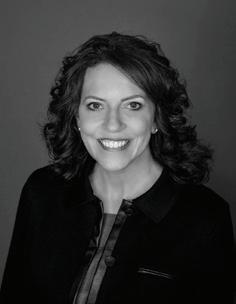











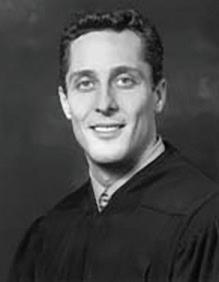



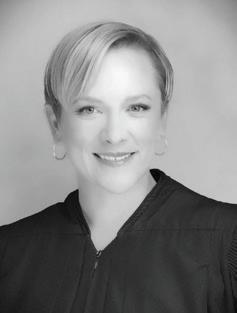




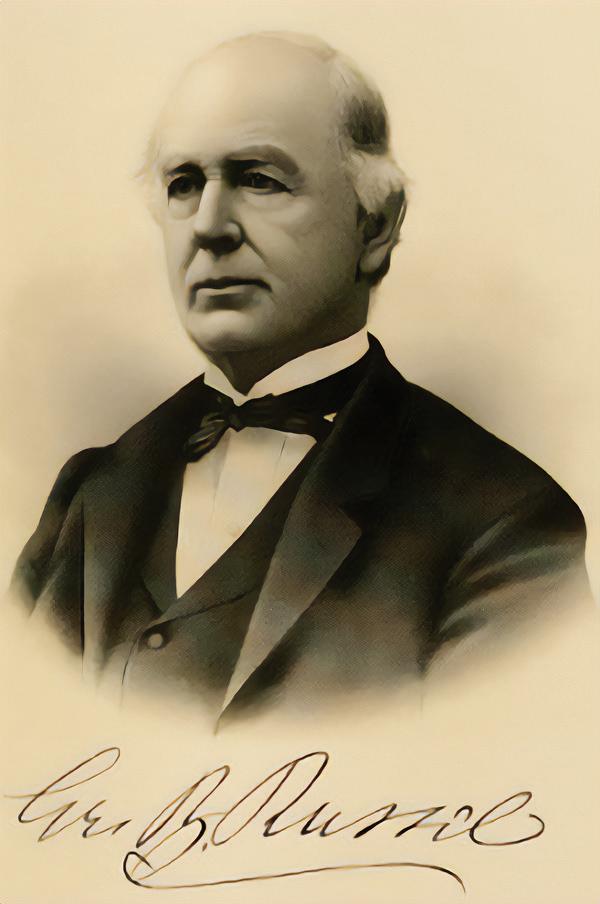

Between giving inoculations and becoming an industrialist, Dr. George B. Russel amassed a sizeable fortune developing real estate in Detroit.
BY RONALD AHRENS
Arriving in Detroit in 1836, Dr. George B. Russel, a Pennsylvanian fresh from Franklin and Marshall College, addressed the community’s medical needs in routine cases and epidemics, riding horseback around the district and building what he called “a large clientage.”
With plenty of saddle time for thinking, he pondered the real estate market and, in 1844, he bought a lot on the north side of Fort Street in Detroit, he told a reporter many years later. He made his payment by a bond worth $500.
“On this lot in 1844 I built the first modern house in Detroit, one with extra fixings such as speaking tubes, a bathroom, and a furnace. … It was built as a trifling wedding present to her who became my wife.”
George and Anna Russel produced eight children, and by 1848 the good doctor’s holdings sprawled to 2,070 acres, including a mile of the Detroit riverfront, at an average of $15 per acre. Apart from land, he acquired the Woodward Avenue ferry lot and built the 100-foot-long steam ferry Argo II. Adversity arose on a trial run, when the Argo’s boiler exploded.
Ferry historian William Oxford wrote, “The captain, first mate, and a few others were killed. Russel was not to be deterred.” Once refitted, the vessel served without further catastrophe until its retirement in 1872.
Through all his time as a circuit-riding healer, Russel’s inner industrialist incubated. As demand for plank roads swelled, and finding himself conveniently endowed with timberlands, Russel loaned the money
WHEEL ARRANGEMENT
Dr. George B. Russel was a successful medical practioner in Detroit during the mid-1800s. Like other physicians, he accepted land for payment in lieu of cash. Over time, he built up a railroad concern that eventually was acquired by George Pullman, who built his first sleeper cars on the city’s east side before moving to Chicago to start a new plant.
for a sawmill to be built five miles up Grand River Avenue, and his own logs were sawn into more than 1 million feet of planks.
At his peak, Russel became a developer by necessity. On Woodward Avenue in 1849, he built Detroit’s second block of stores with cast-iron facades. The next year he built three stores on Jefferson Avenue.
From there, he developed more than 50 houses and “many business places,” including another sawmill, which by 1854 became a shop that equipped the Detroit & Milwaukee Railroad. Next, his transit railroad from Rivard Street opened up the eastern riverfront for factory sites for Michigan Stove Co. and others.
According to Russel, in 1856 he factored in the first ton of iron produced in Detroit. He had already established Detroit Car & Manufacturing Co., agreeing to build 25 railcars for Detroit & Pontiac Railway — the first such operation west of Albany, N.Y. The first location was a shop on Gratiot Avenue, the second was on Beaubien Street, and finally a large facility arose on Monroe Avenue near the Detroit, Grand Haven & Milwaukee Railroad line.
George Pullman later acquired the plant and built his sleeper coaches there until 1893, when he moved to Chicago.
Following their father’s success, two of Russel’s sons established Russel Wheel and Foundry Co. in 1876. At that time, Detroit, with its skilled workforce, was the nation’s largest manufacturer of locomotives, railcars, boxcars, bridges, and railroad tracks.
Russel rode his physician’s circuit for 27 years, before moving to Hamtramck. “Although I closed my books, making no charges, there remained for me the care of a large family, many relatives and friends, and the poor among the host of my employees.”
He was 87 years old when he told his story. He could still read without glasses and, in a Detroit Free Press account, was “sick but five days in his life, not a headache in 33 years.”
He died three months afterward. Provision for his burial had already been made, thanks to his earlier, large contribution to acquire farmland that became Elmwood Cemetery on the city’s east side.










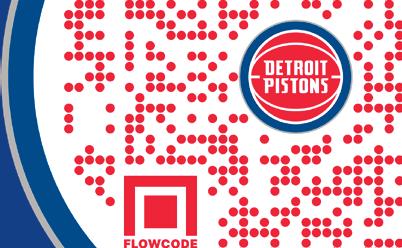














The numbers speak for themselves... ...And so do their clients.
Team TVA+RLA’s expertise, connections and professionalism are topnotch, and it is clear they are leaders in the Real Estate industry.
-Bloomfield Seller














































































